Caroline and I had a girls’ day on the 23rd. We decided to hike the Canal de Beauregard. From AllTrails:
“4.5-mile out-and-back trail near Fonds-Saint-Denis, Saint-Pierre. Generally considered a moderately challenging route, it takes an average of 2 h 7 min to complete. Highlights include stunning views and a pleasant ambiance along the canal. Challenges are narrow paths and vertigo risk.”
Info from https://azmartinique.com/:
Built in 1760, it owes its name “Canal de Beauregard” to the man who conceived it, Mr. Beauregard. It was subsequently appointed “Canal des Esclaves” to honor the men who carried on their backs stone for its construction.
It was once a vestige of the economic life of the 18th century. Its main purpose was to supplement traditional energy sources. It was also used to carry water from the river Carbet to the houses of the Caribbean Coast and to irrigate crops.
The hike is not recommended for those prone to vertigo, as the coping (cemented band) of the channel is only 30 cm wide in some places and it overlooks ravines over 100 meters deep.
Here are some pictures of the path, the canal and views along the way:
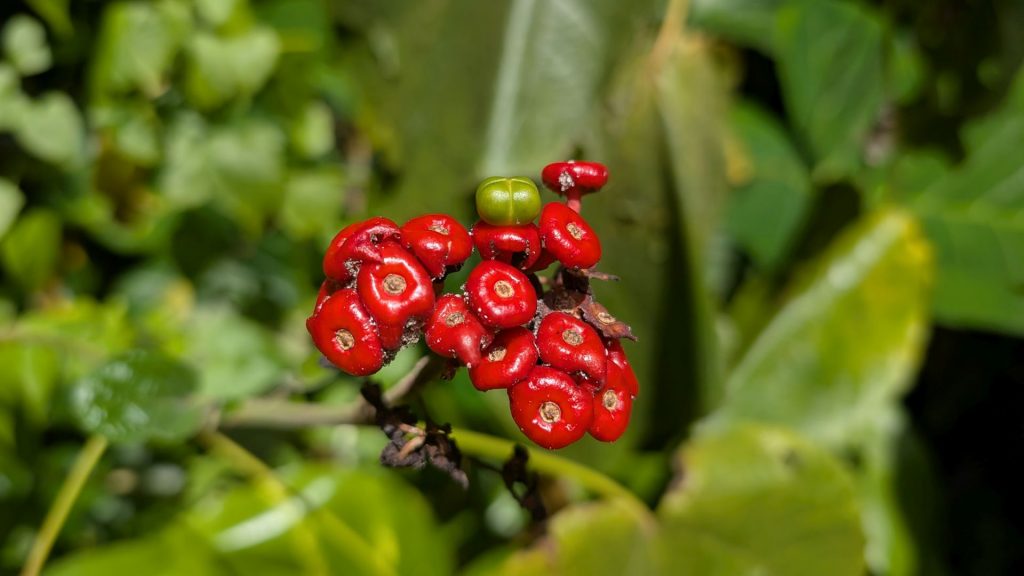
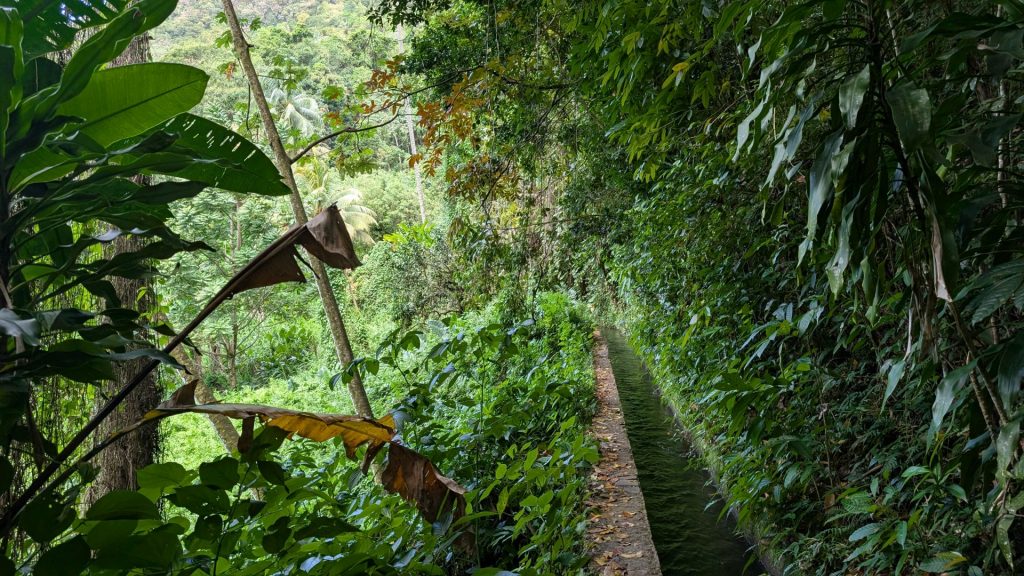
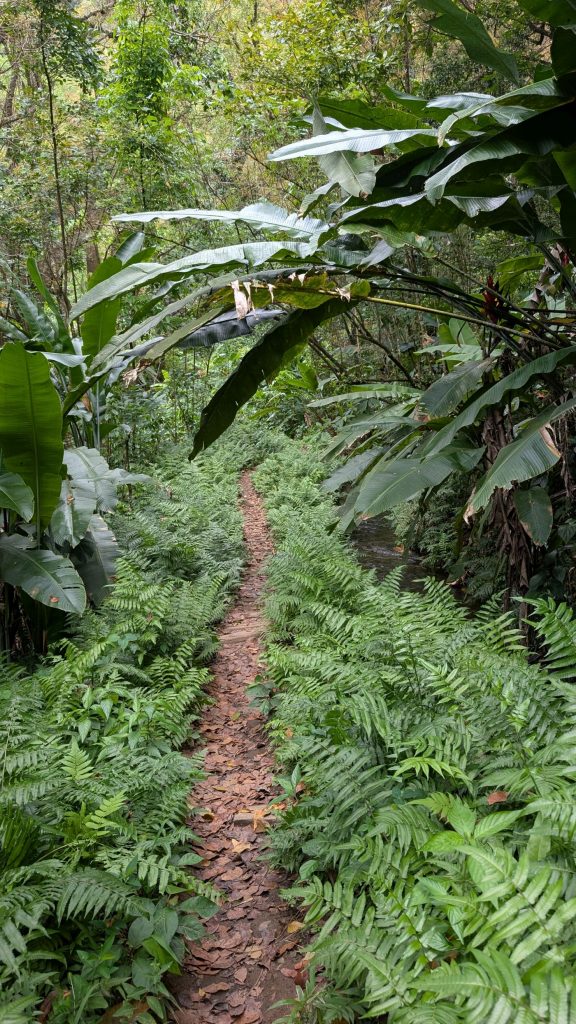
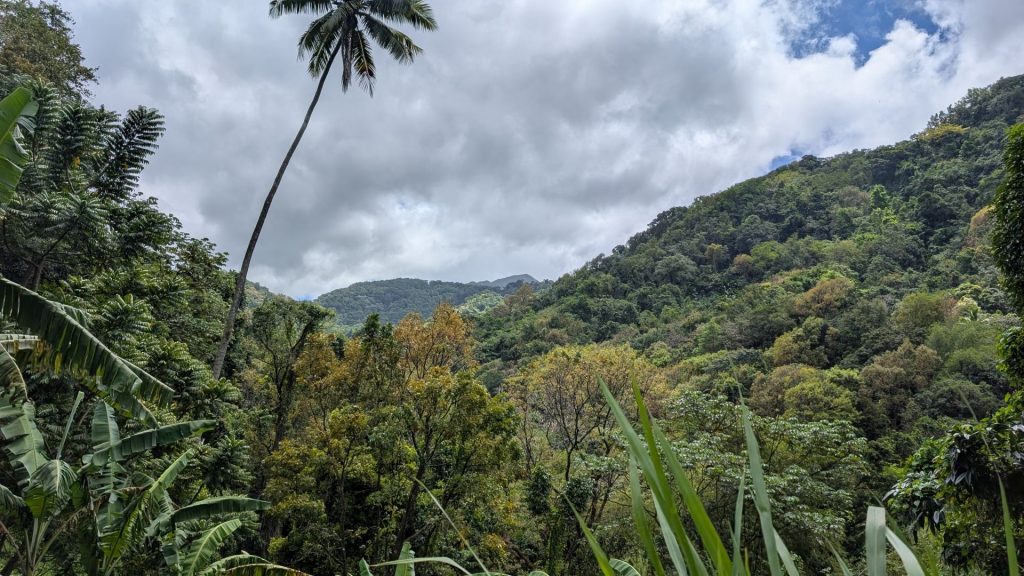
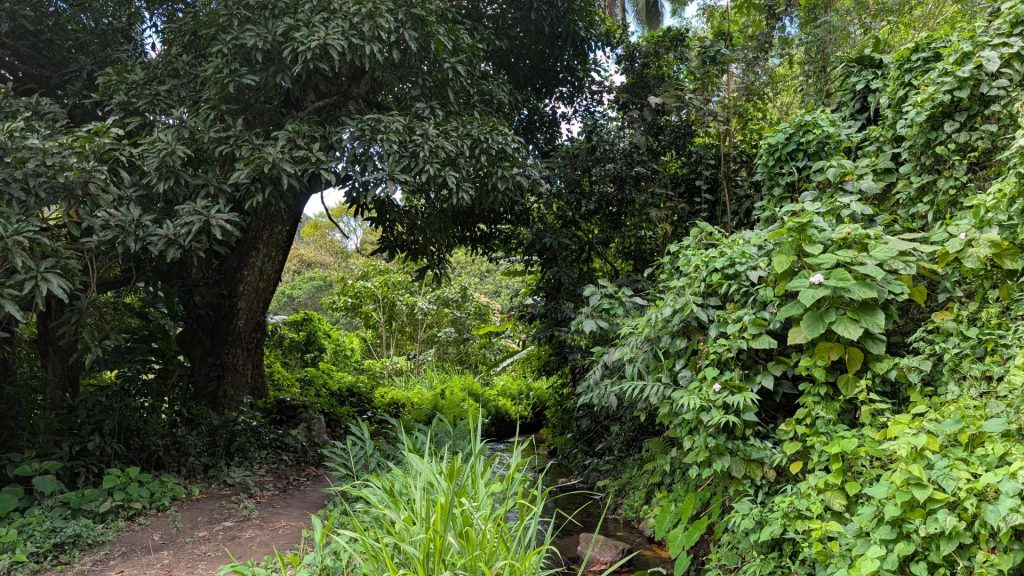
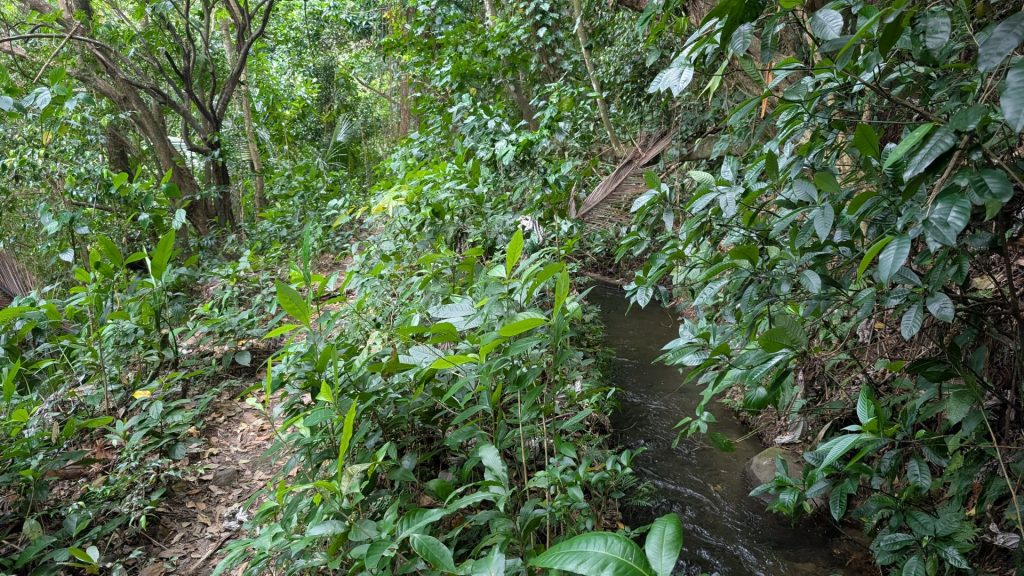
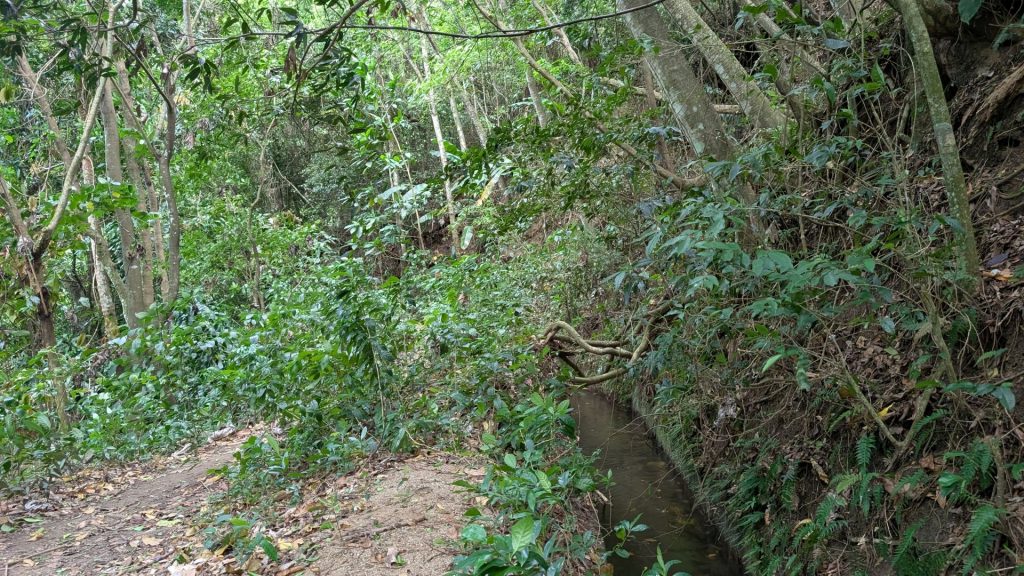
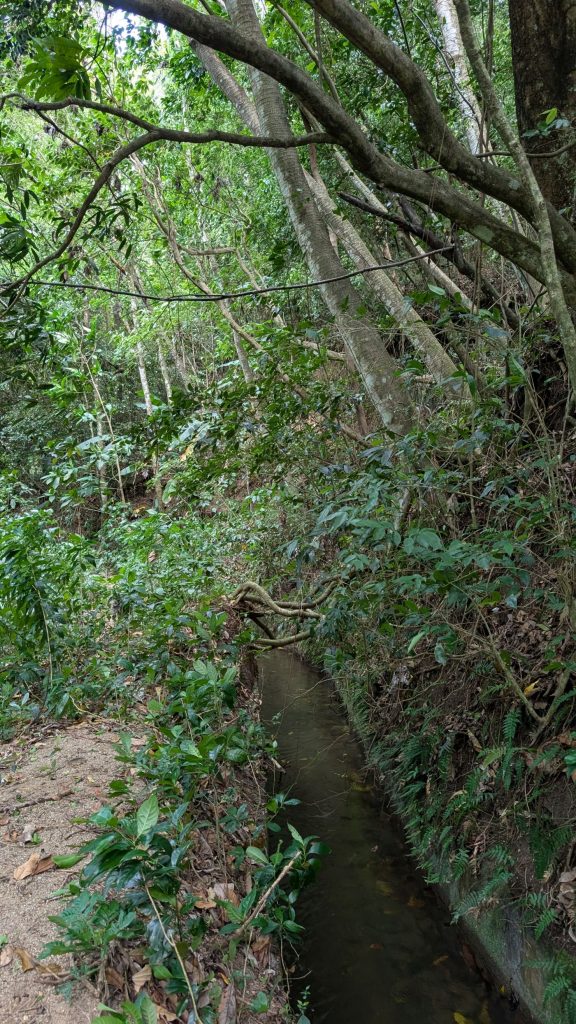
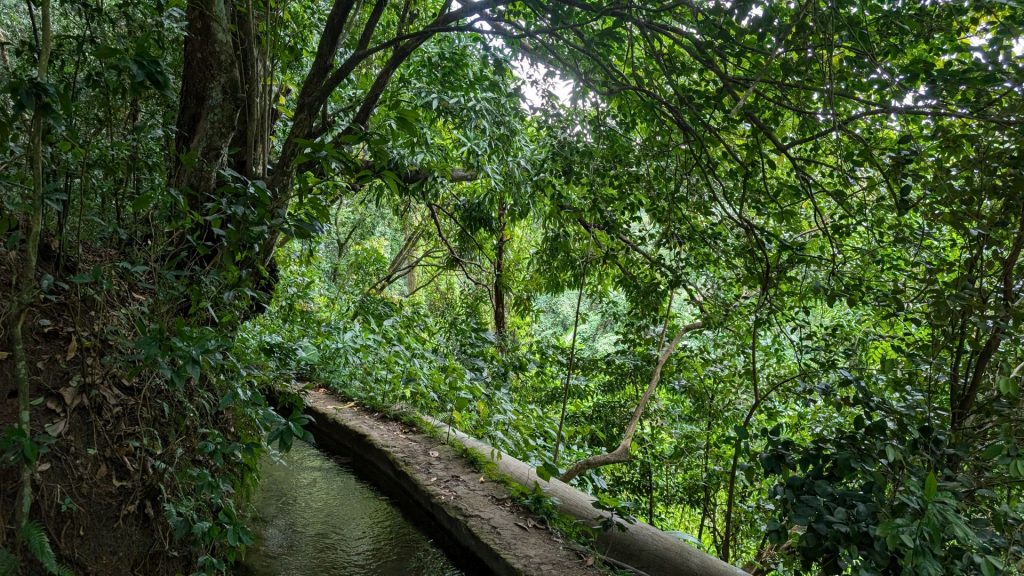
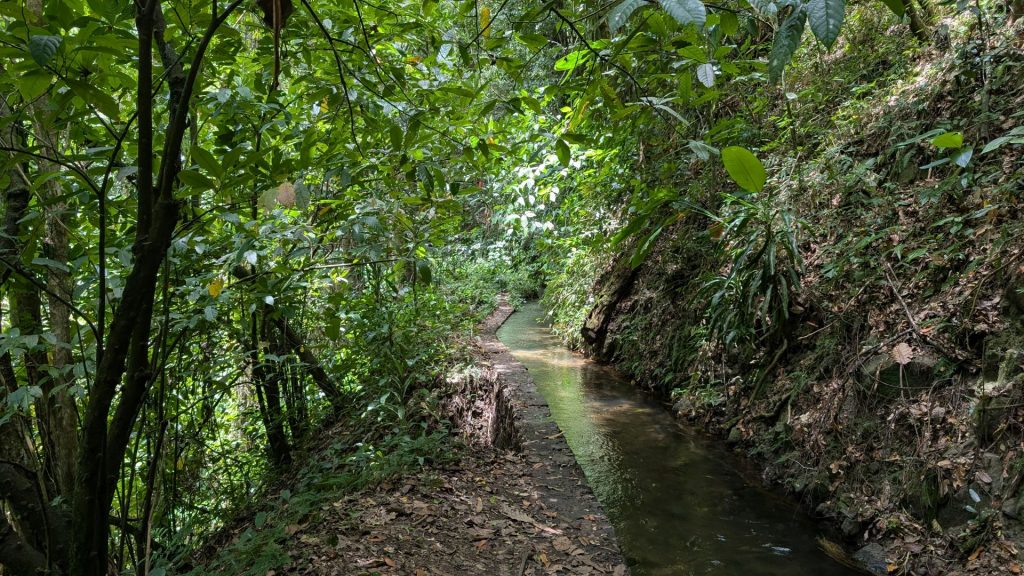
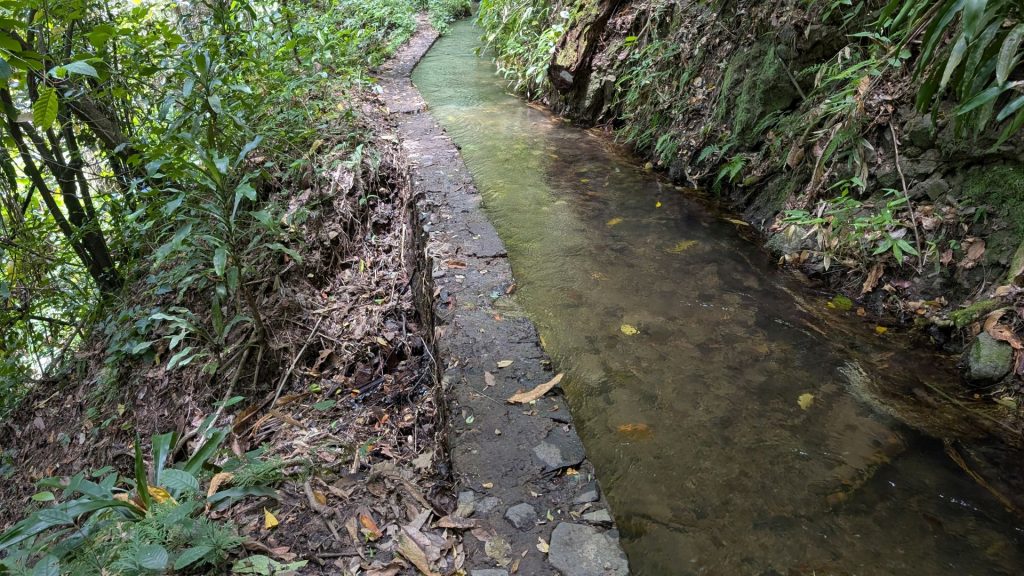
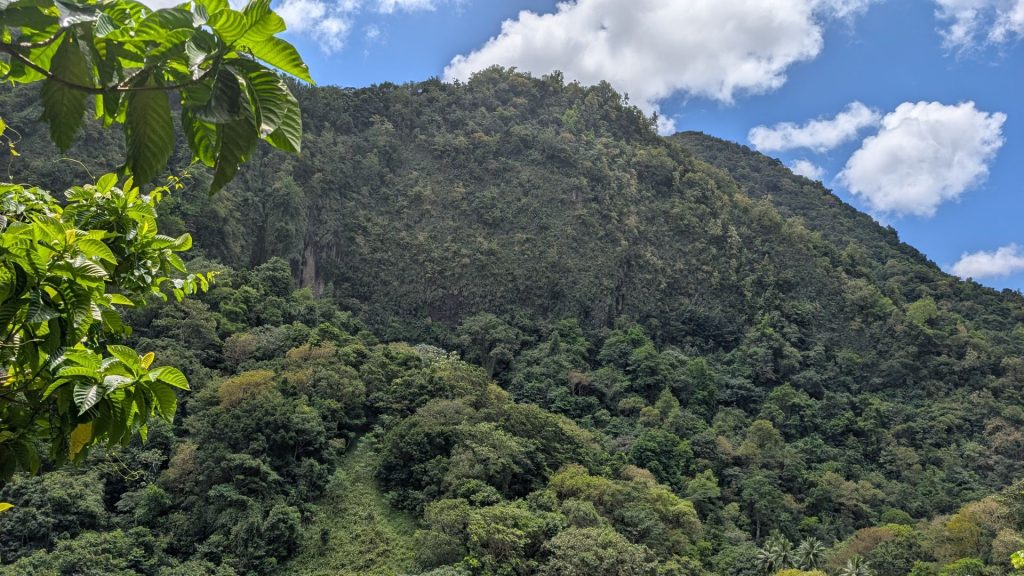
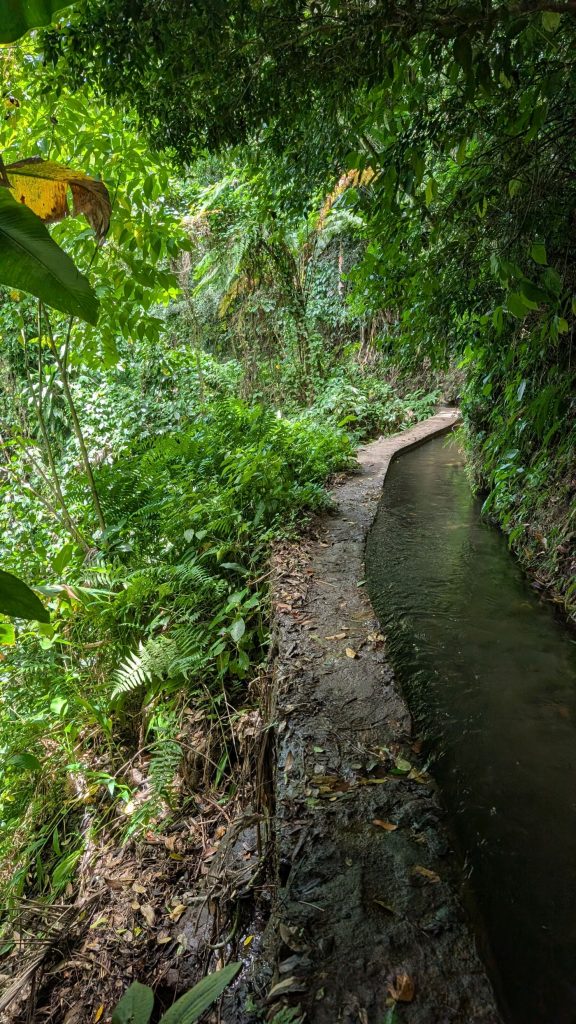
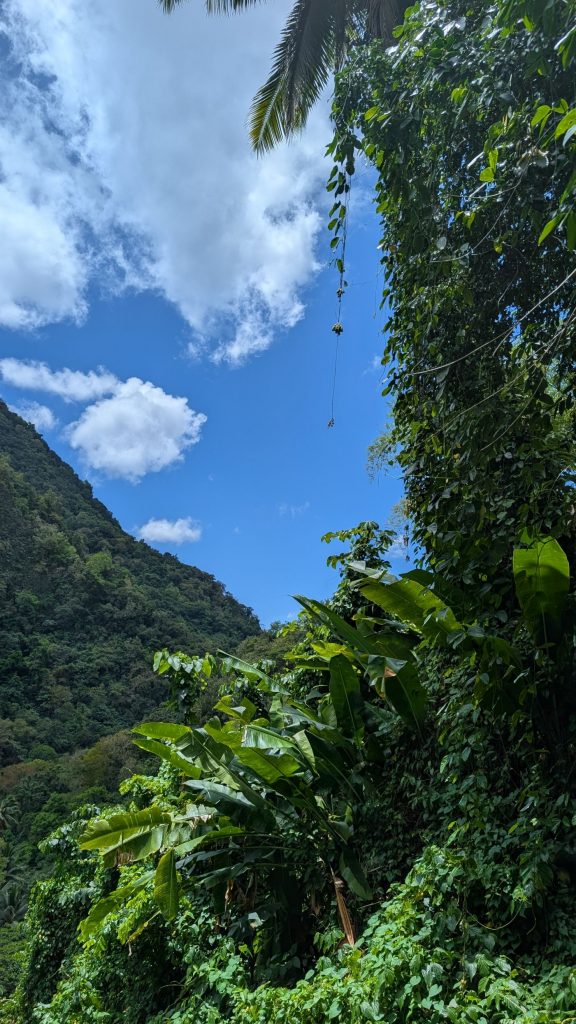
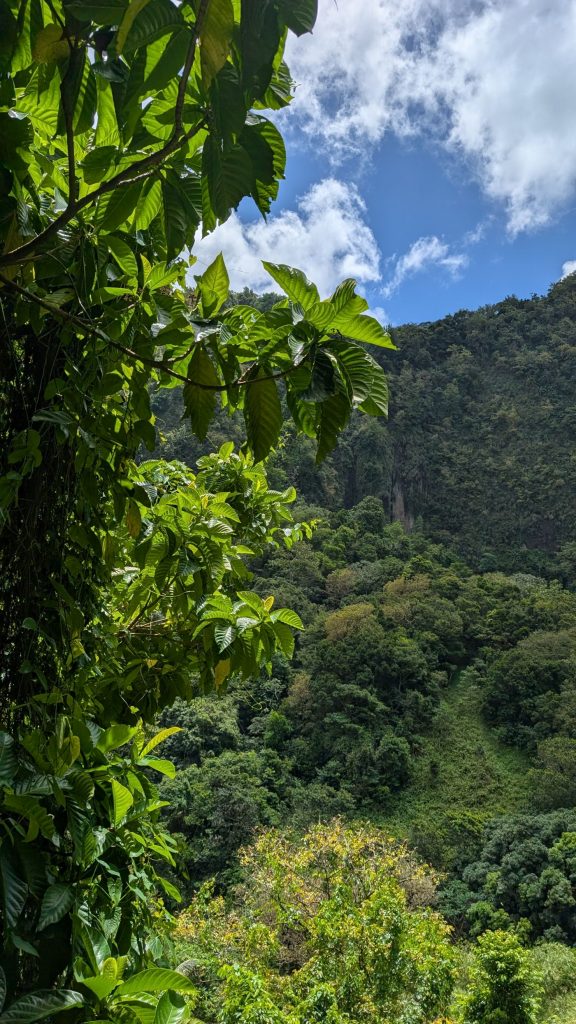

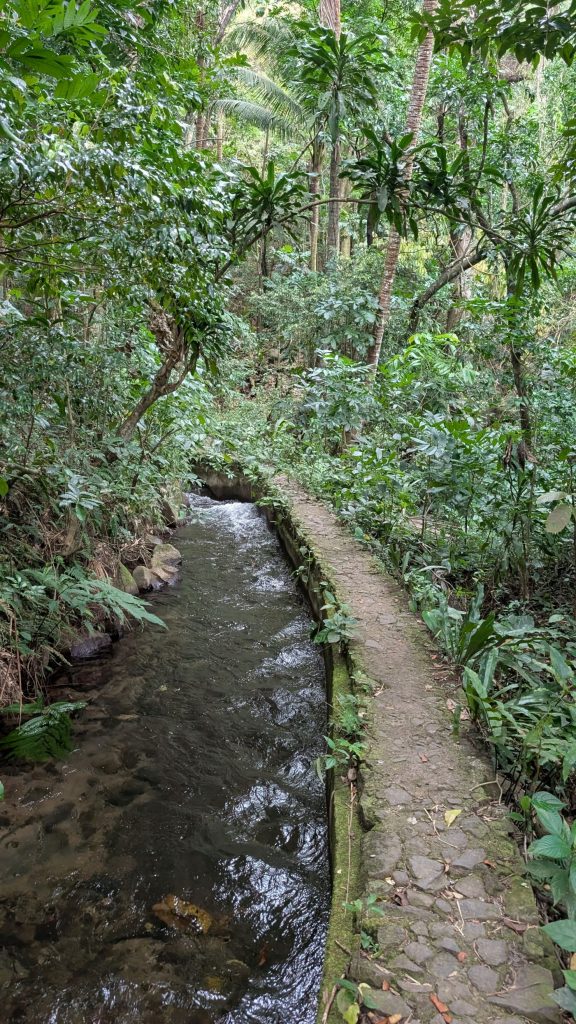
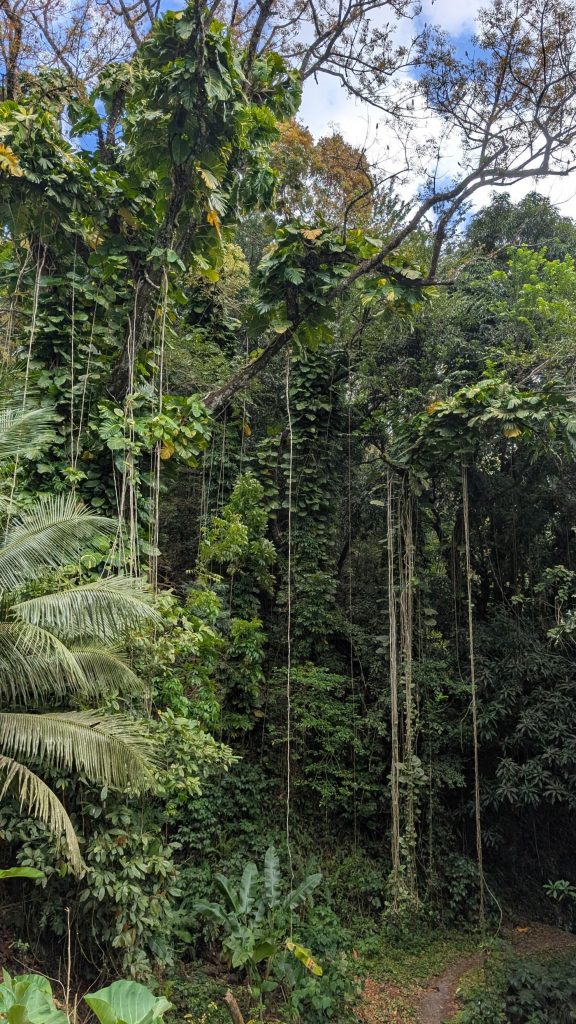
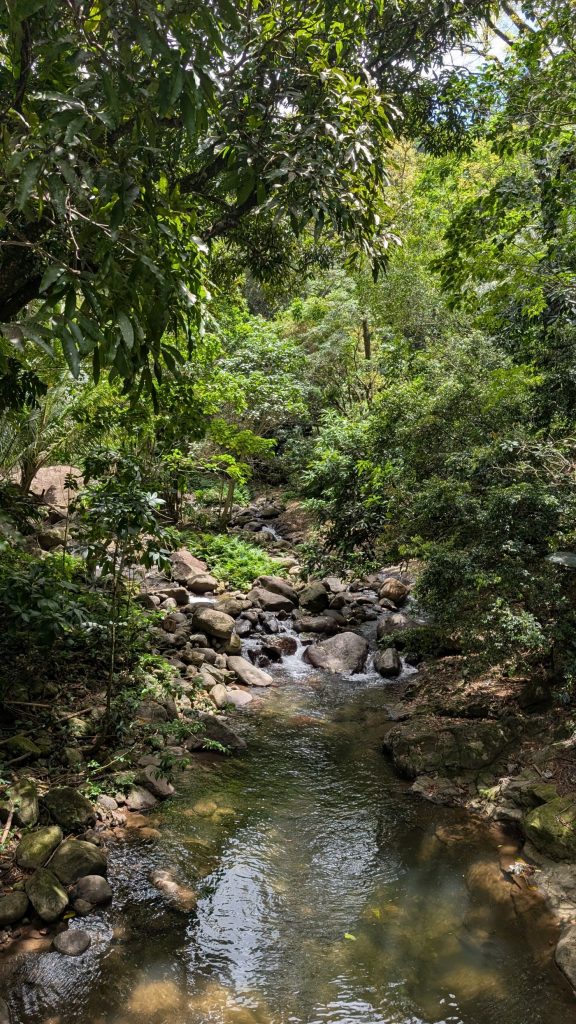
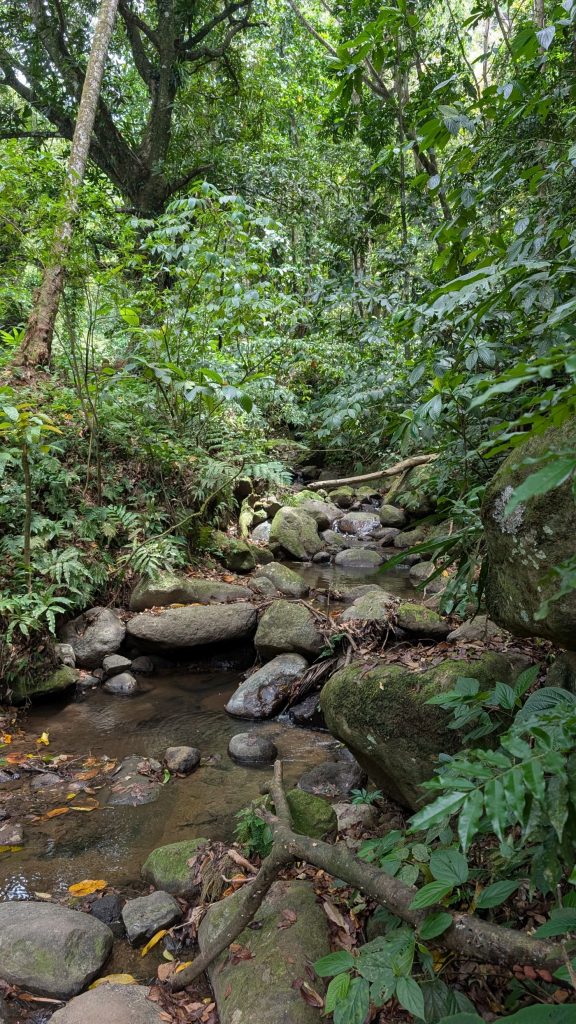

We drove to a nearby town for lunch. I asked for a rum punch, but I got. . . rum. Good stuff.
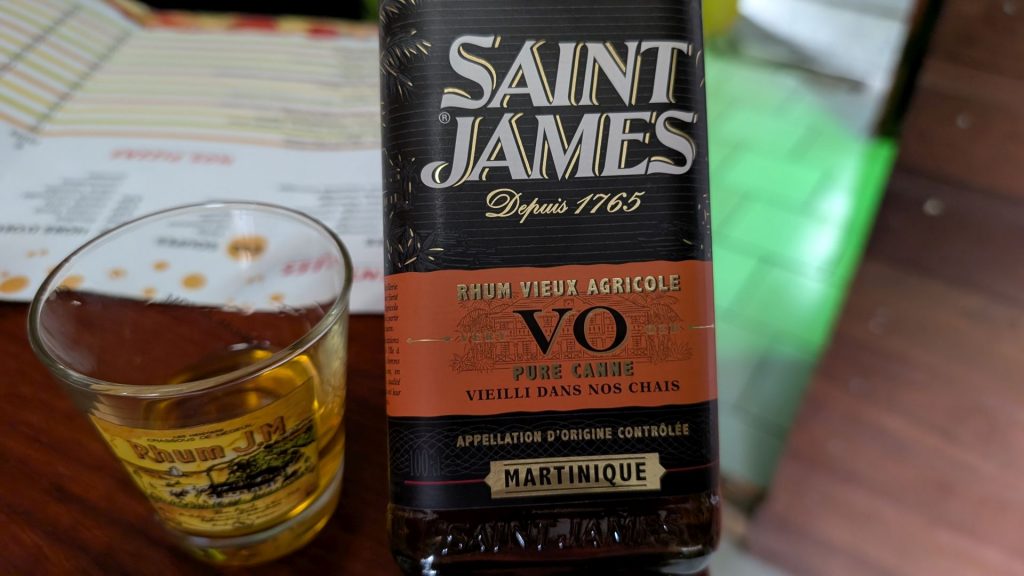
We took to the water the next day and sailed (two reefs in the main and two in the genoa) to the northwestern part of the island. It was windy, with 30 kt gusts most of the way.
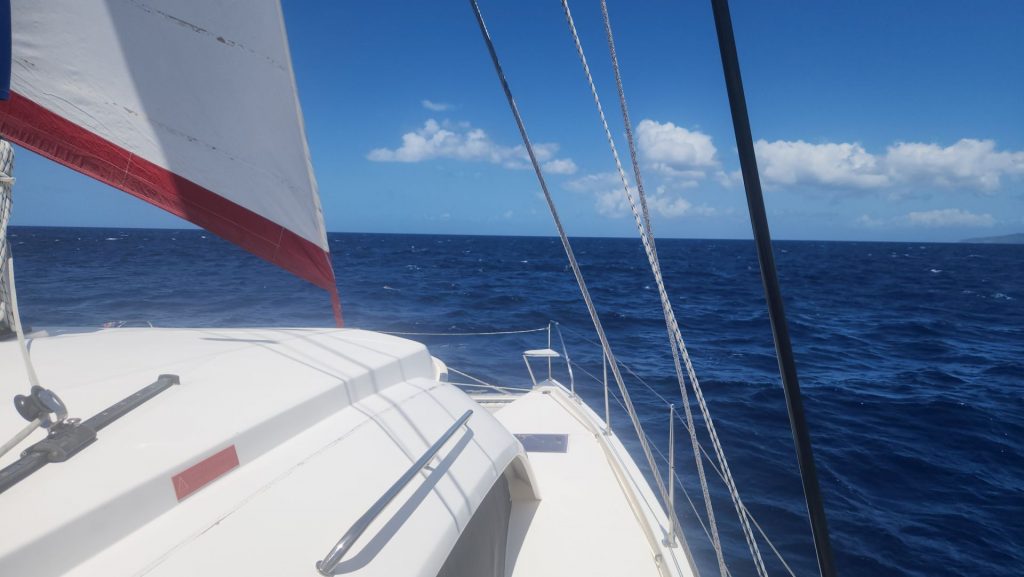
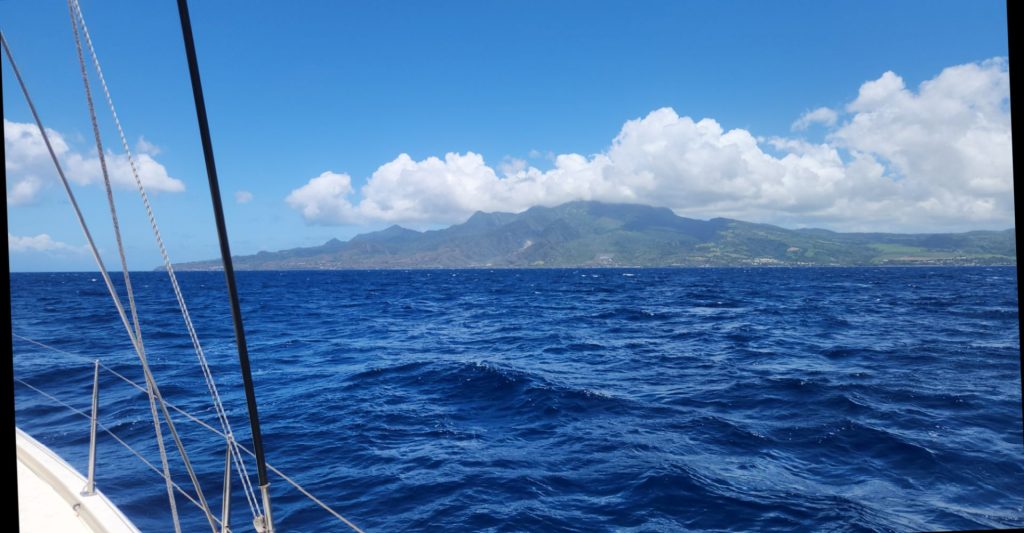
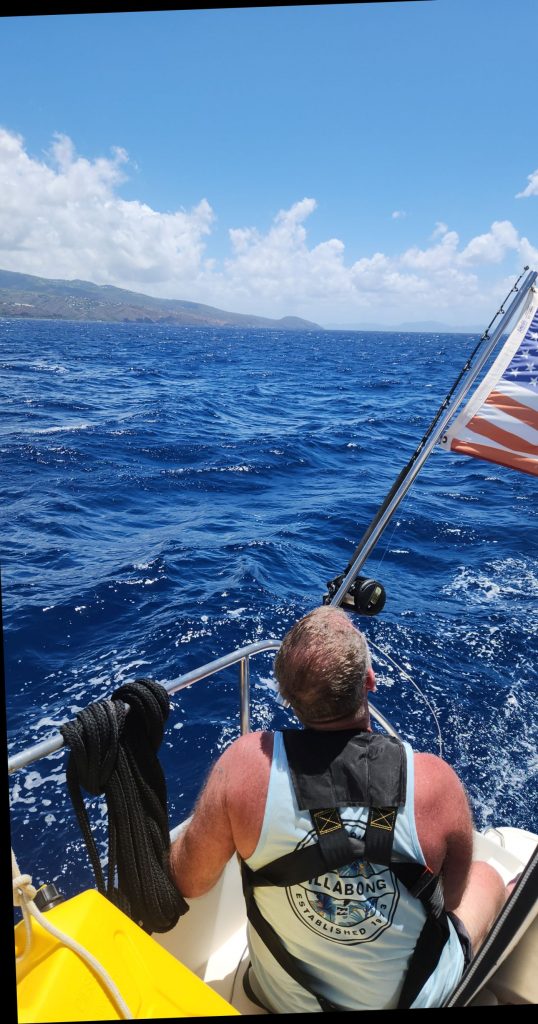
We arrived at the Anse Couleuvre anchorage by about noon. Jim, Caroline and I were planning to take the waterfall hike. To do that, we first had to get to shore on the dinghy. We didn’t pay enough attention to how powerful the surf was. Oops!
It didn’t work out so well. The new dinghy is quite heavy and even with three of us, we couldn’t pull it up on shore before the surf almost completely filled it with water. We started bailing like crazy. After trying and failing once too often, a Good Samaritan – who was also very strong! – helped us by lifting the stern of the dinghy and moving it to the side so the water would stop filling it. The four of us eventually maneuvered the dinghy far enough away from the water to keep her on shore . . . and dry.
Info about Anse Couleuvre Waterfall Hike from All Trails:
1.9 mi Length
731 ft Elevation gain
1h 19 m Estimated time
Out & back
Generally considered a moderately challenging route. Take a walk through the tropical forest of the Prêcheur Grand Rivière biological reserve, which leads you to the beautiful Rivière Couleuvre waterfall. This waterfall is over 120 meters high and is one of the highest on the island of Martinique. You can swim at the foot of the waterfall or in the river.
It is a great hike!!
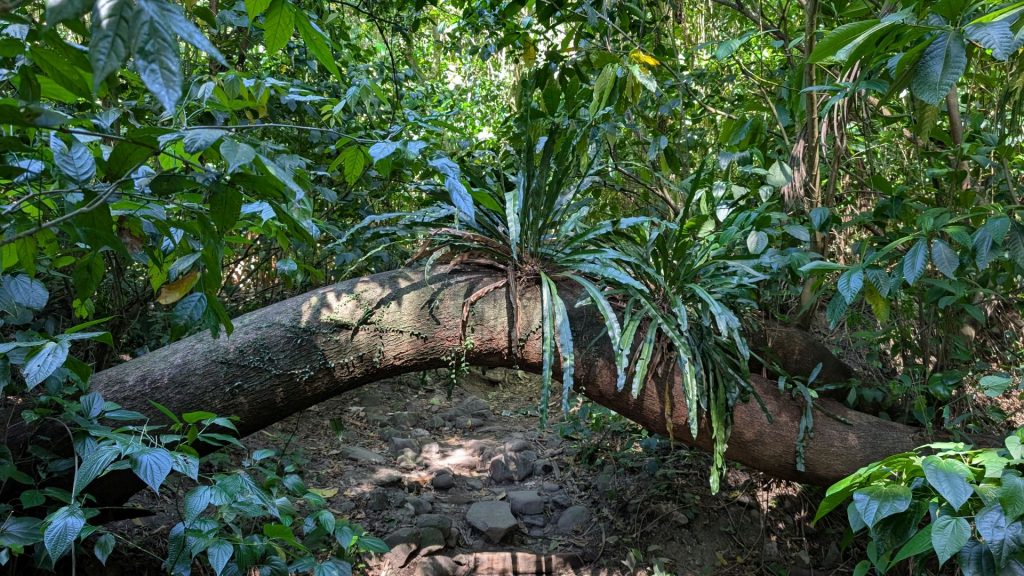
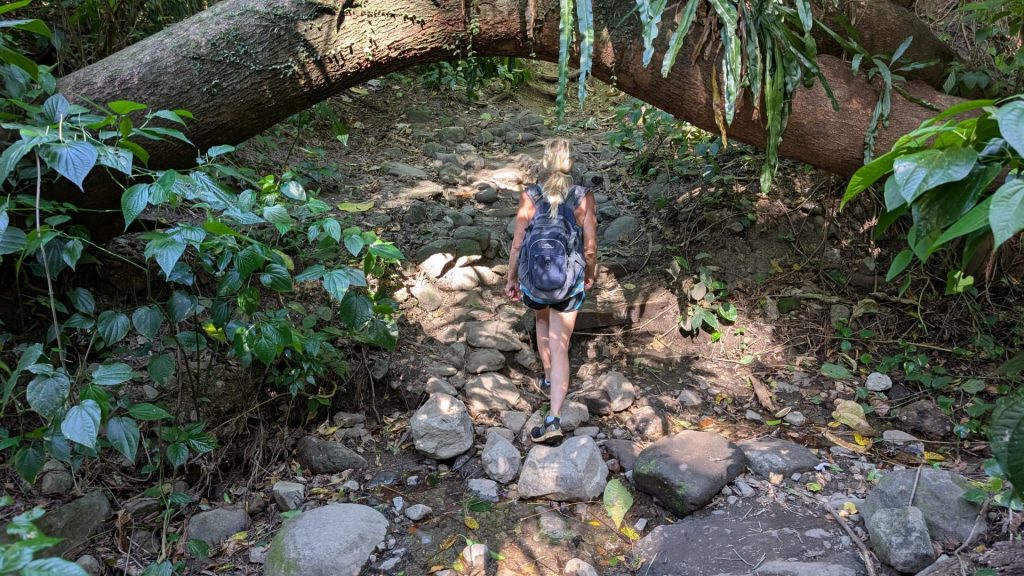
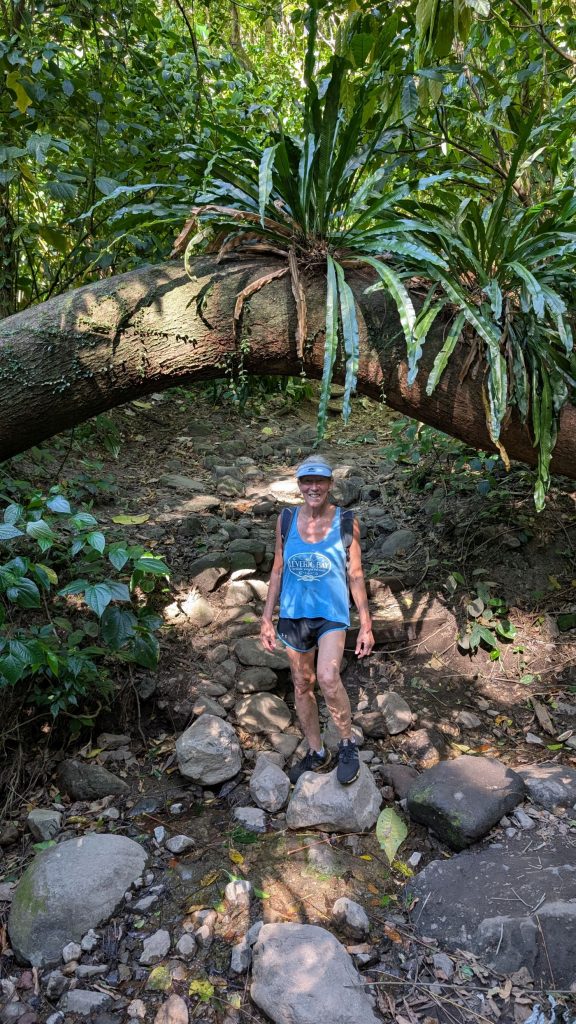
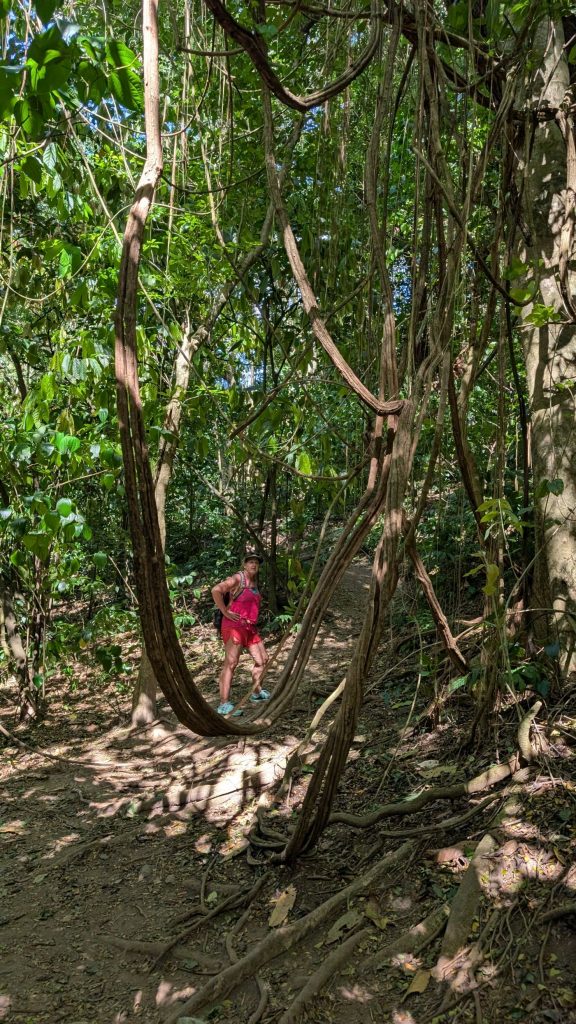
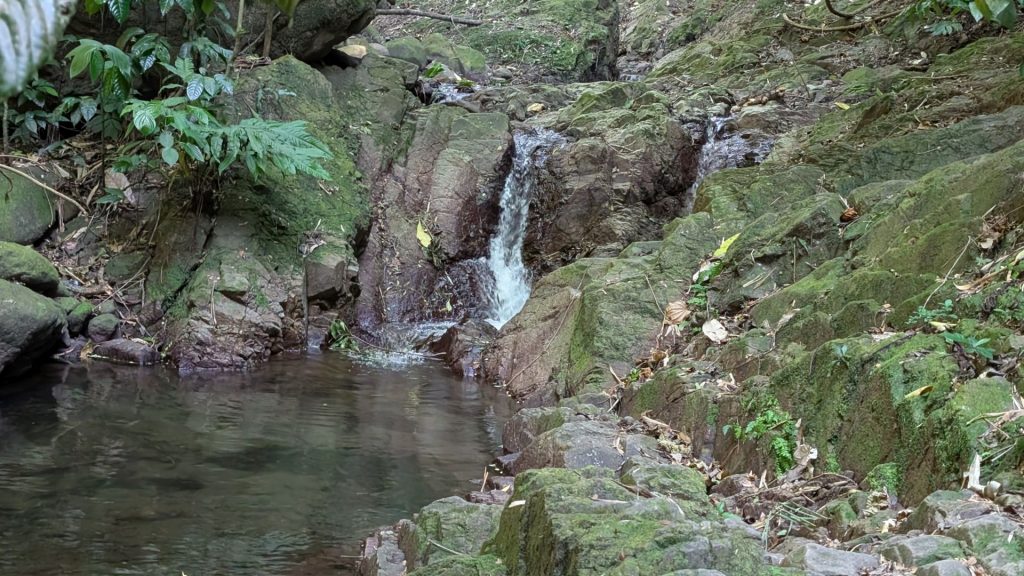
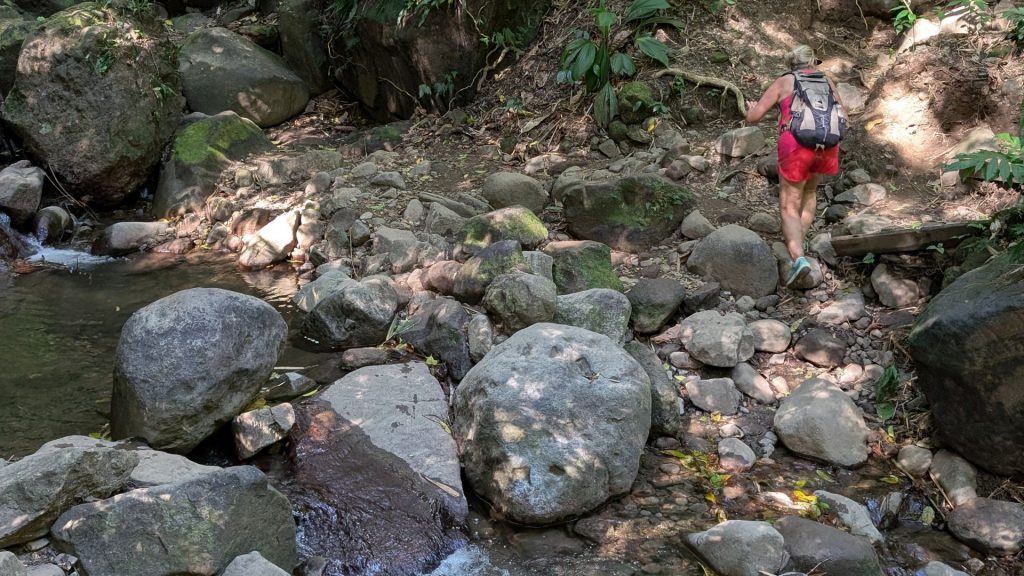
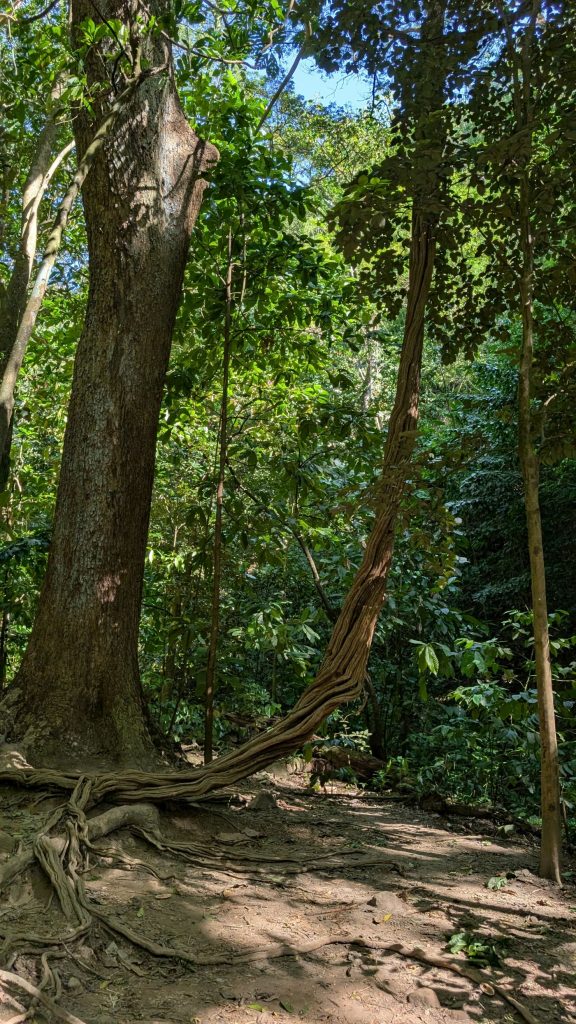
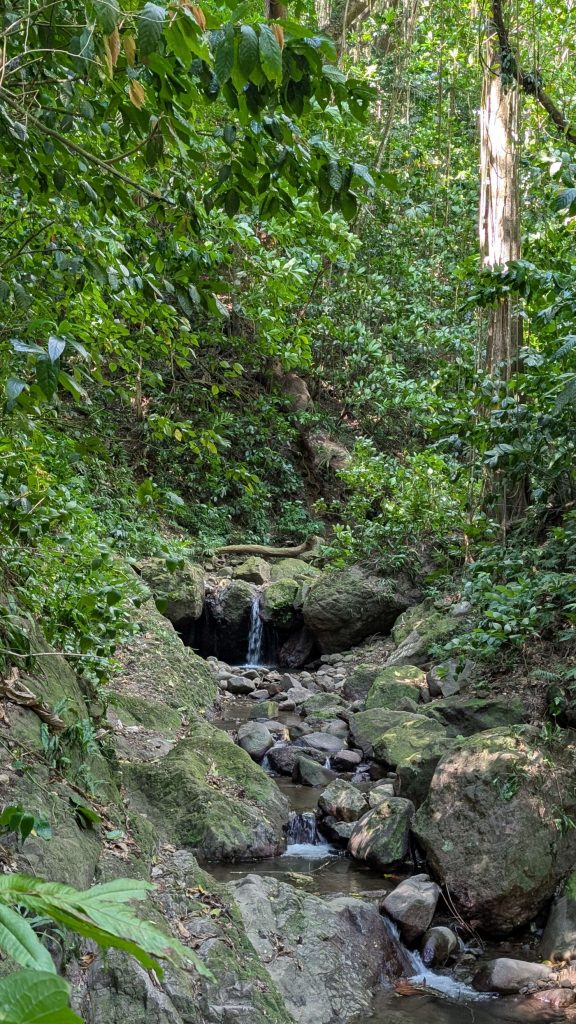
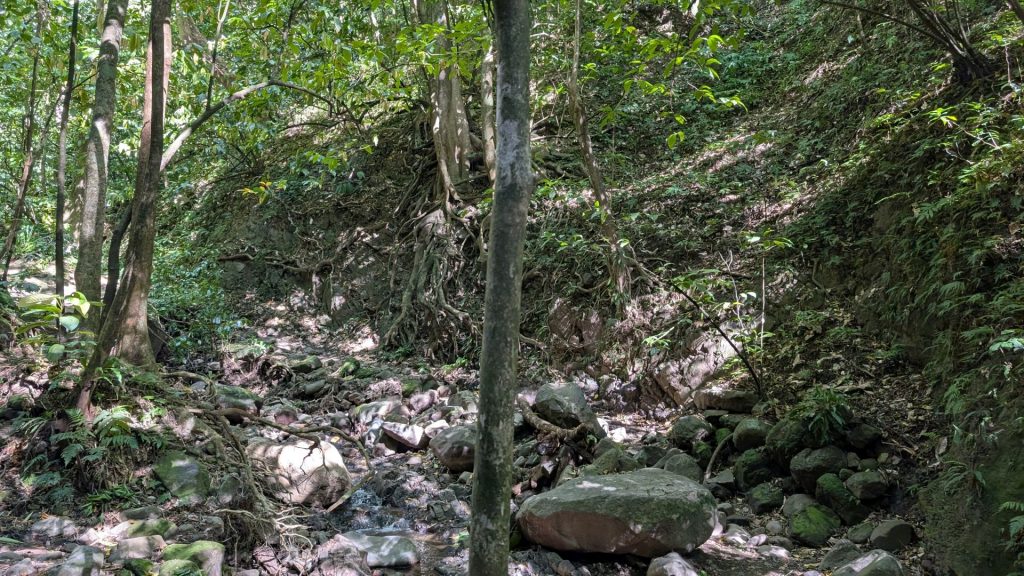
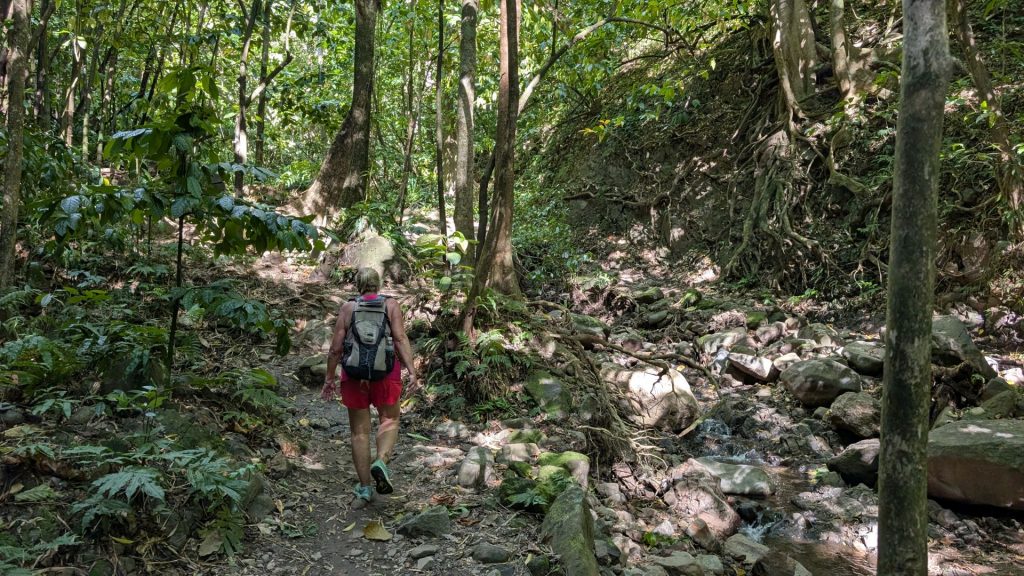
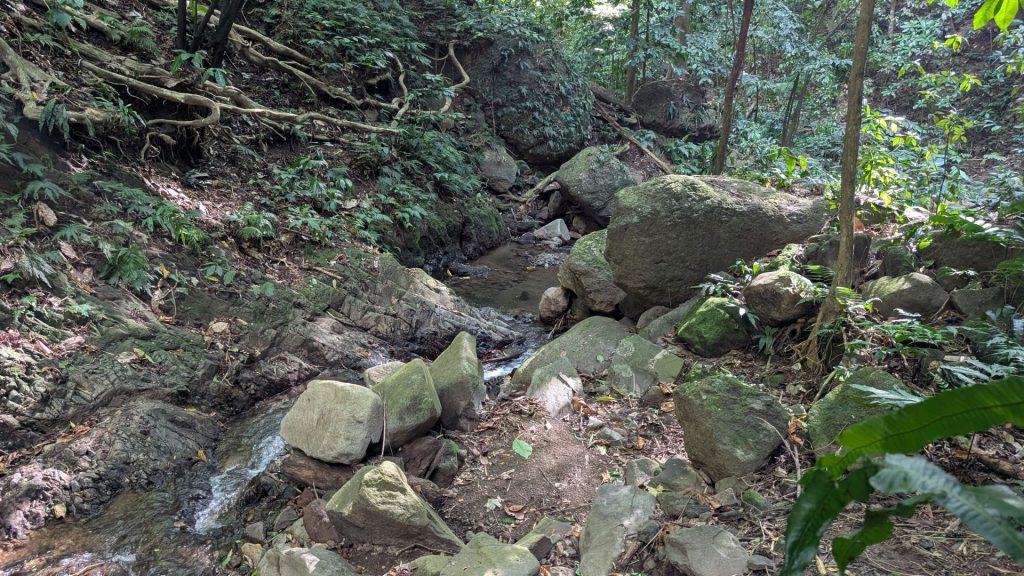
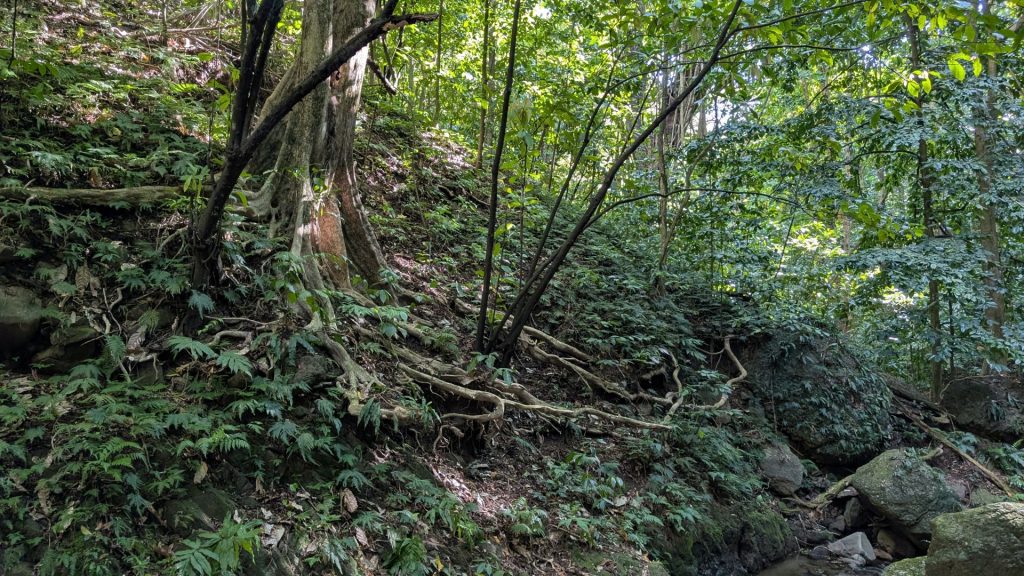
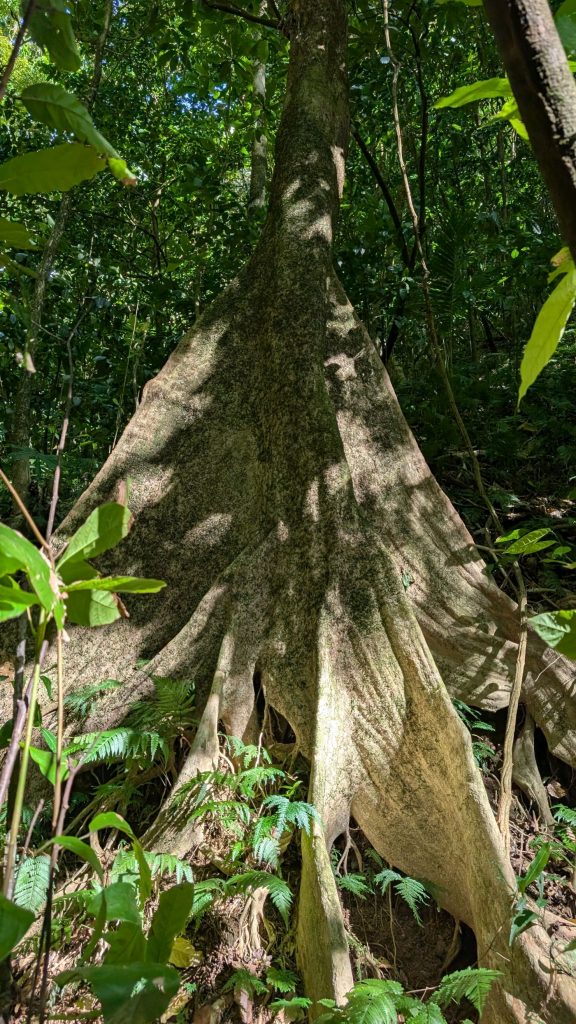
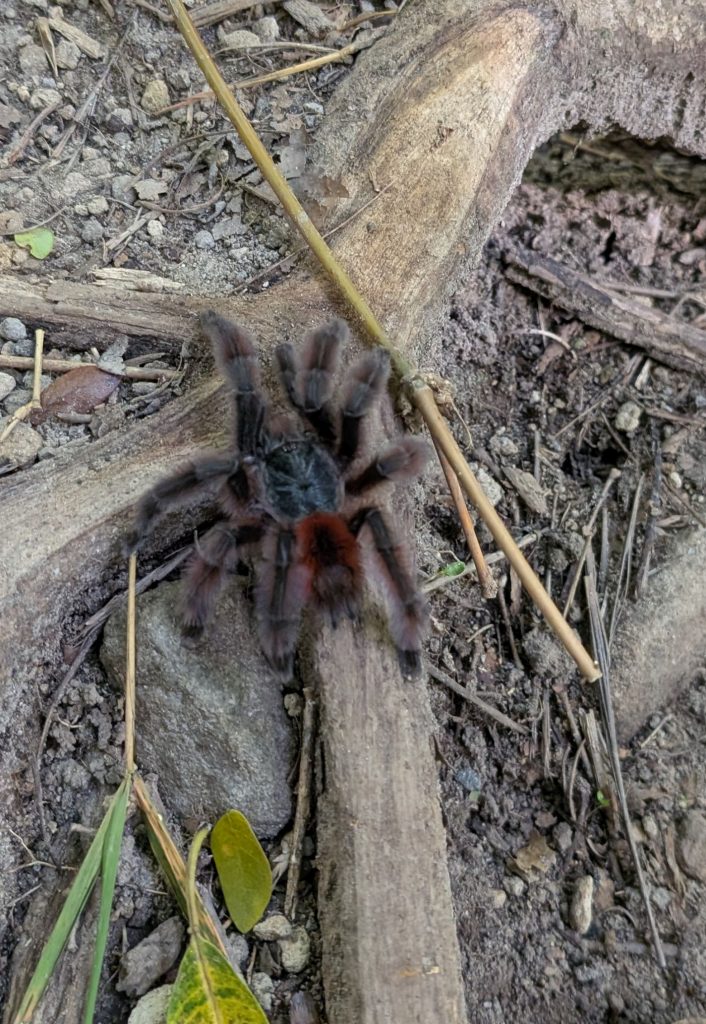
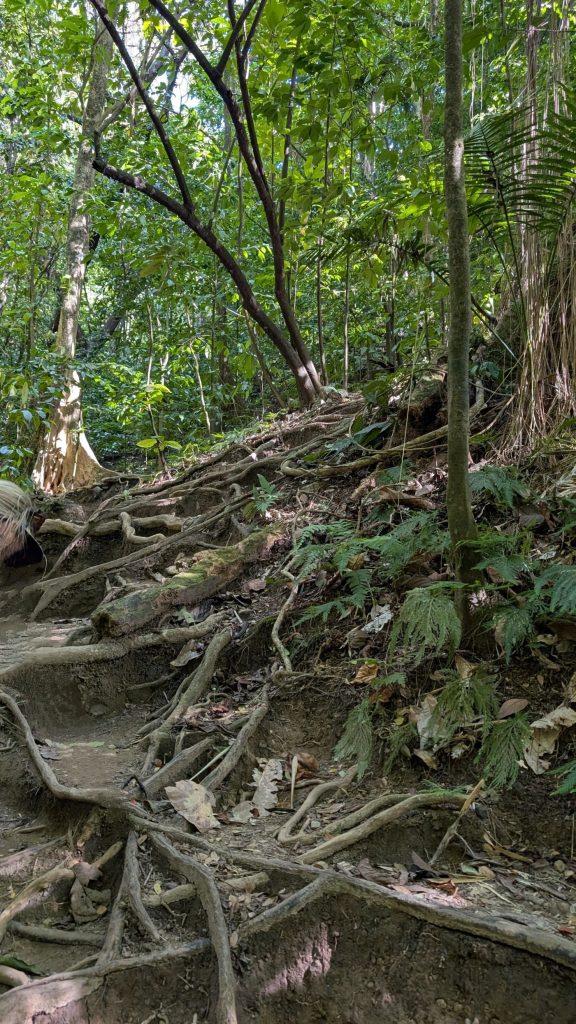
We made it to the waterfall. We were all more than ready to cool down in it!
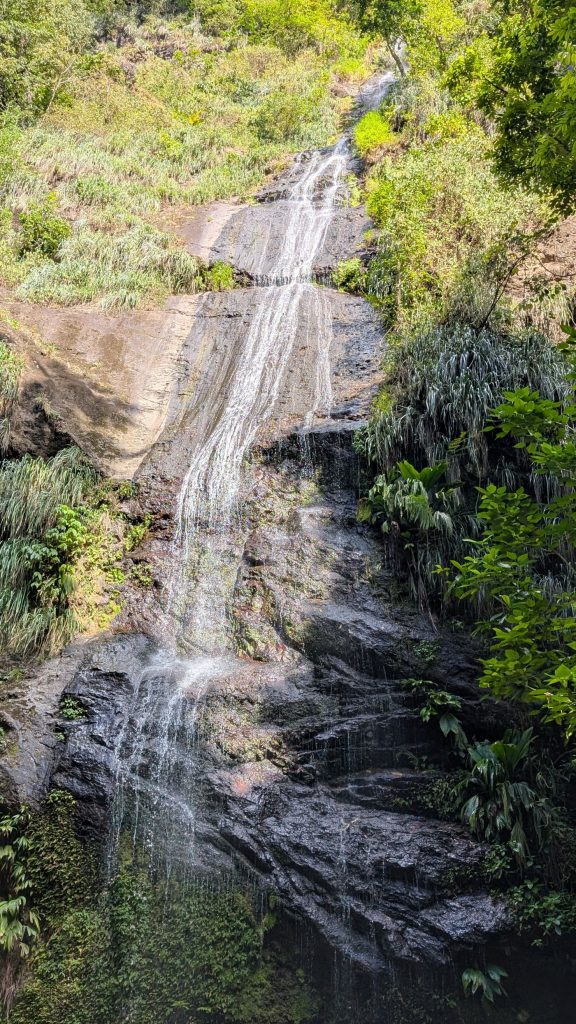
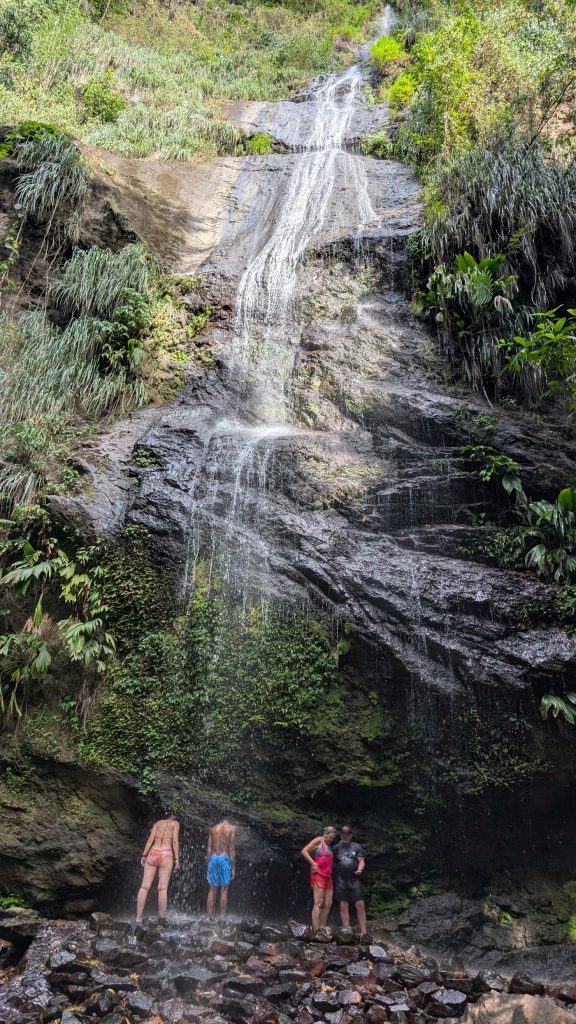
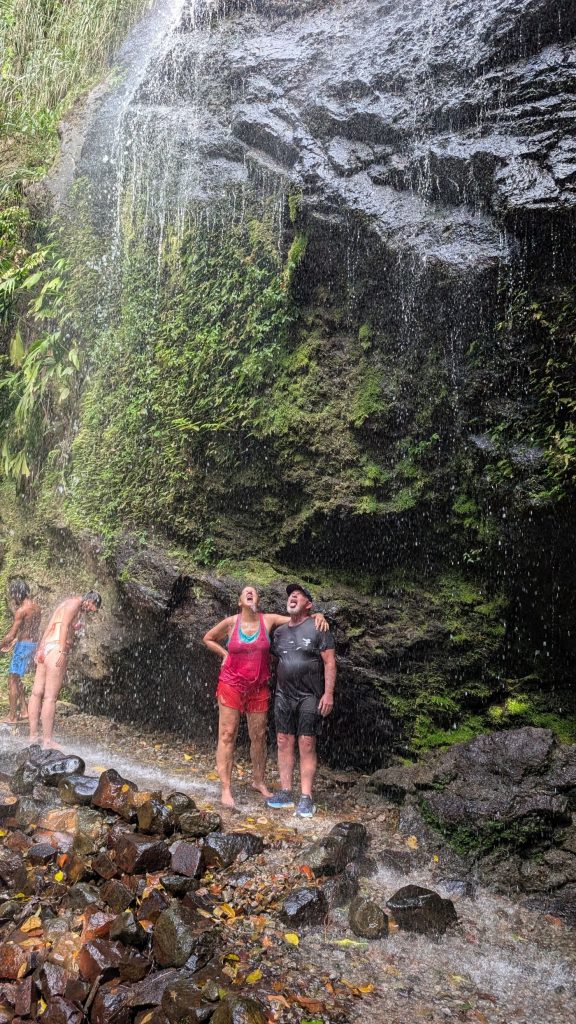
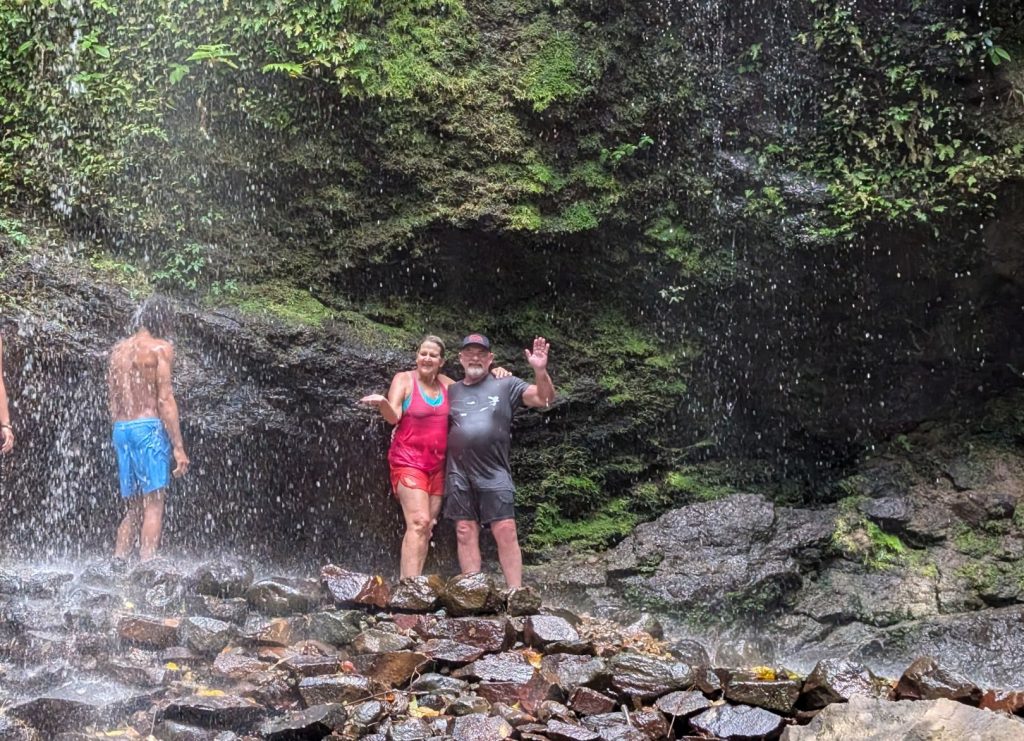
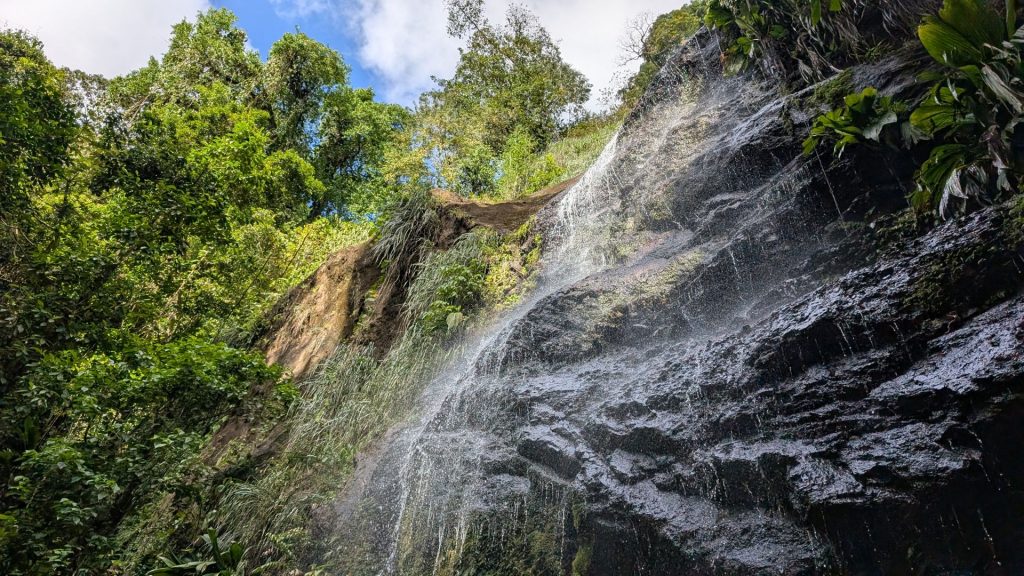
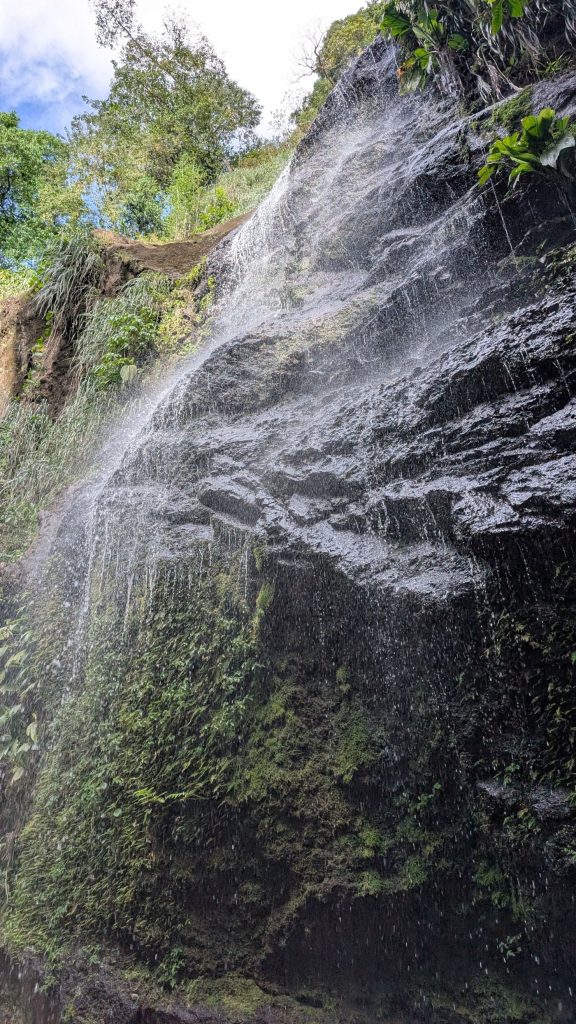
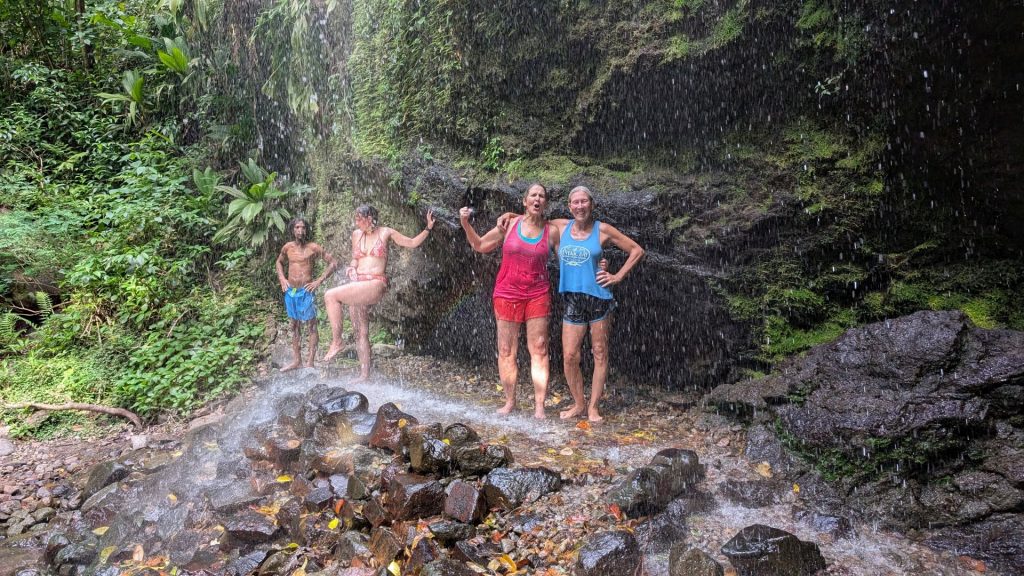
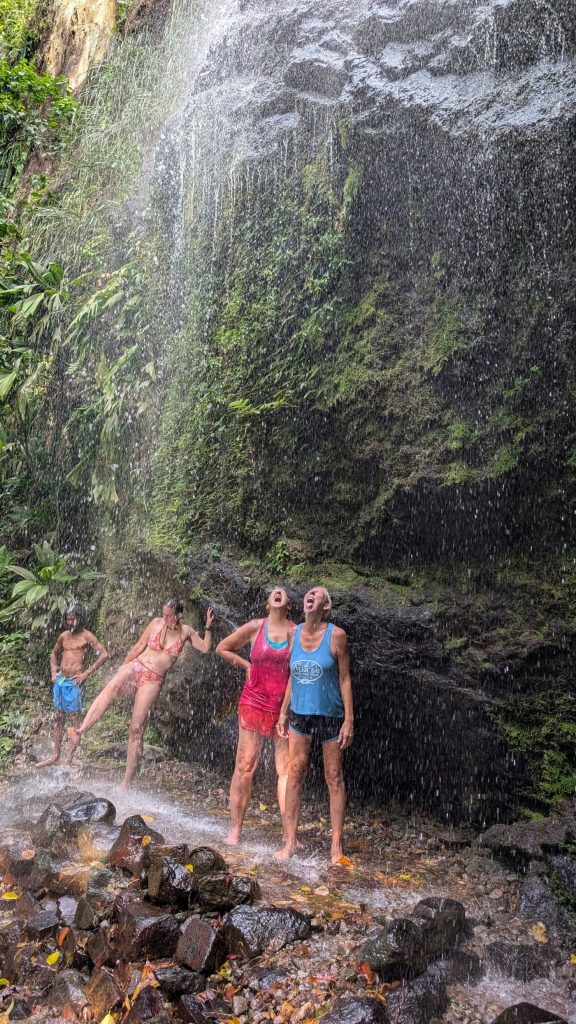
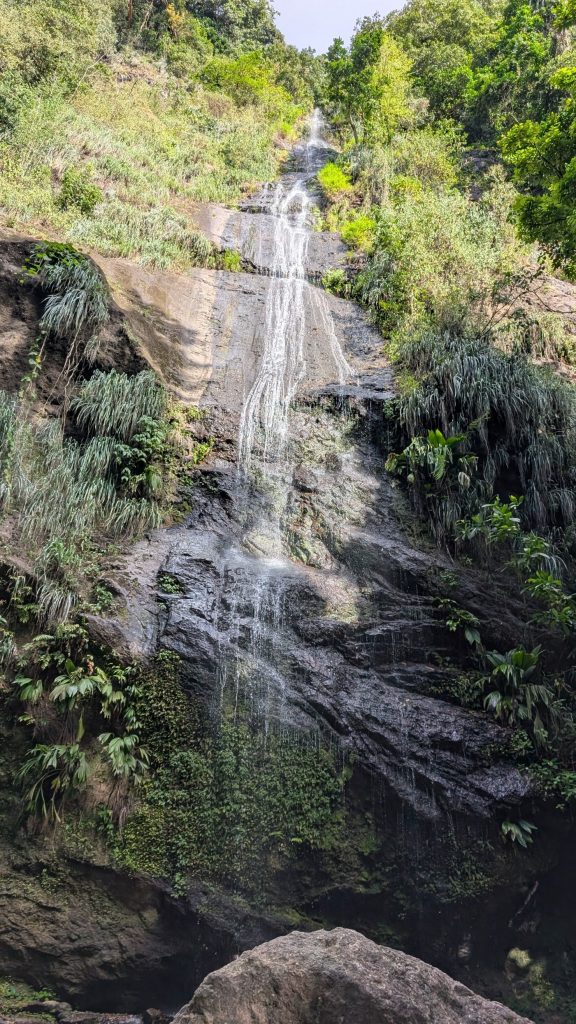
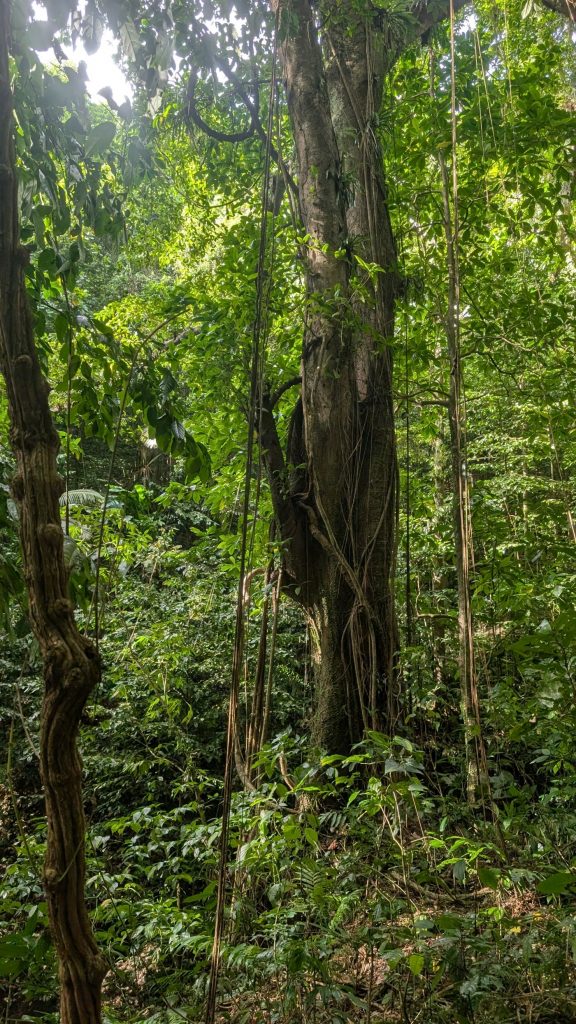
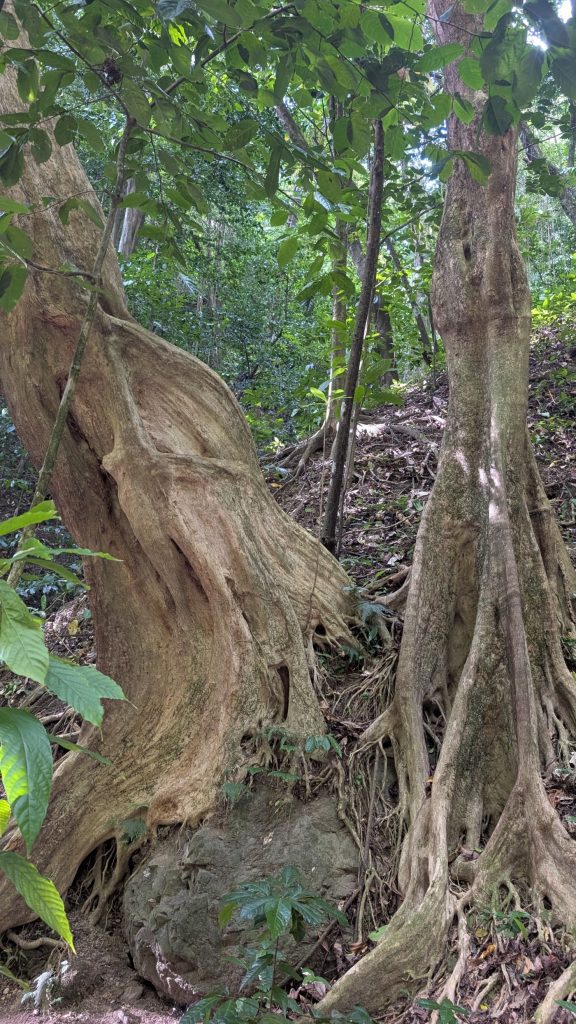
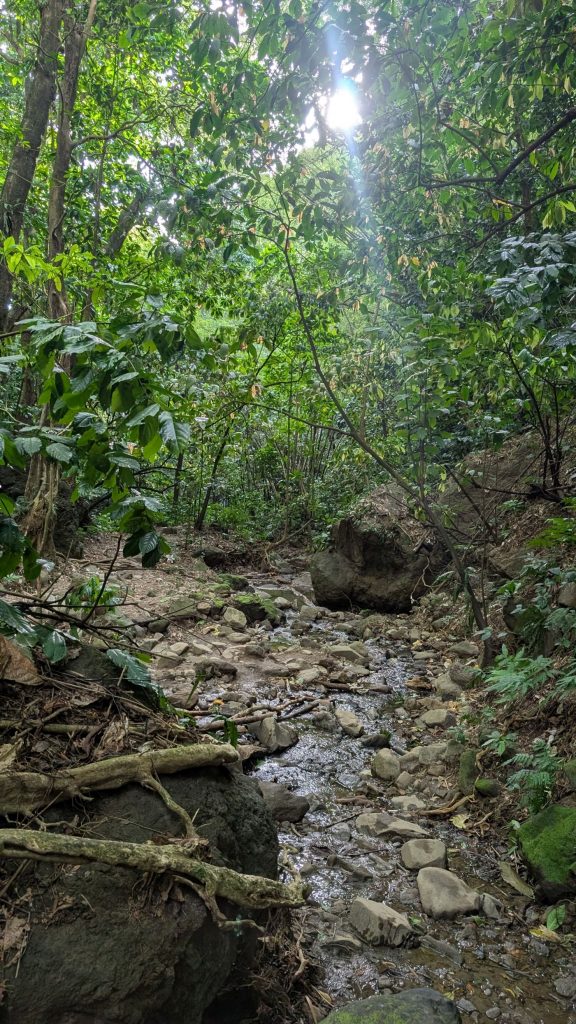
Jim decided to go for a swing on the tree limb that looped down low to the ground.

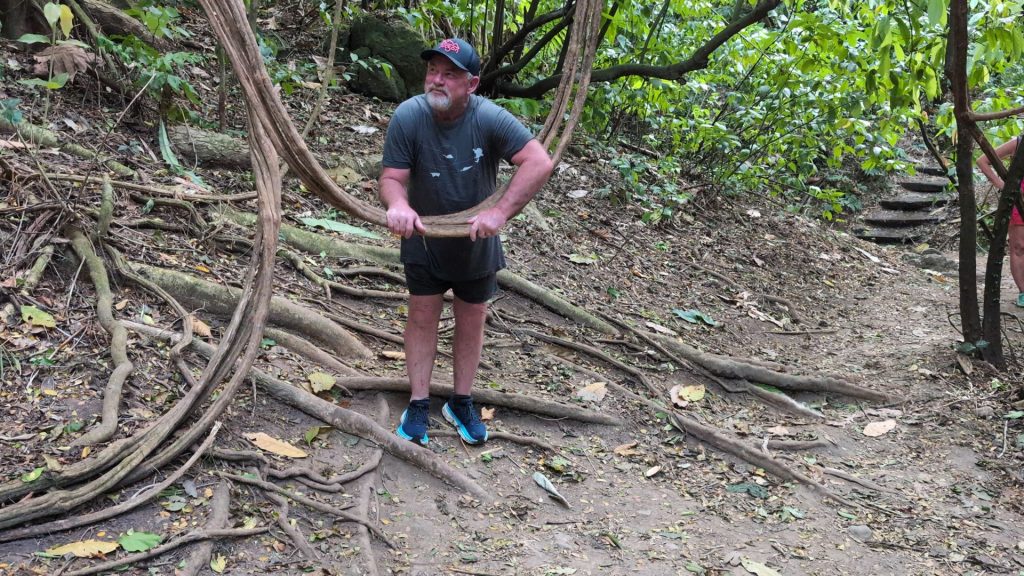
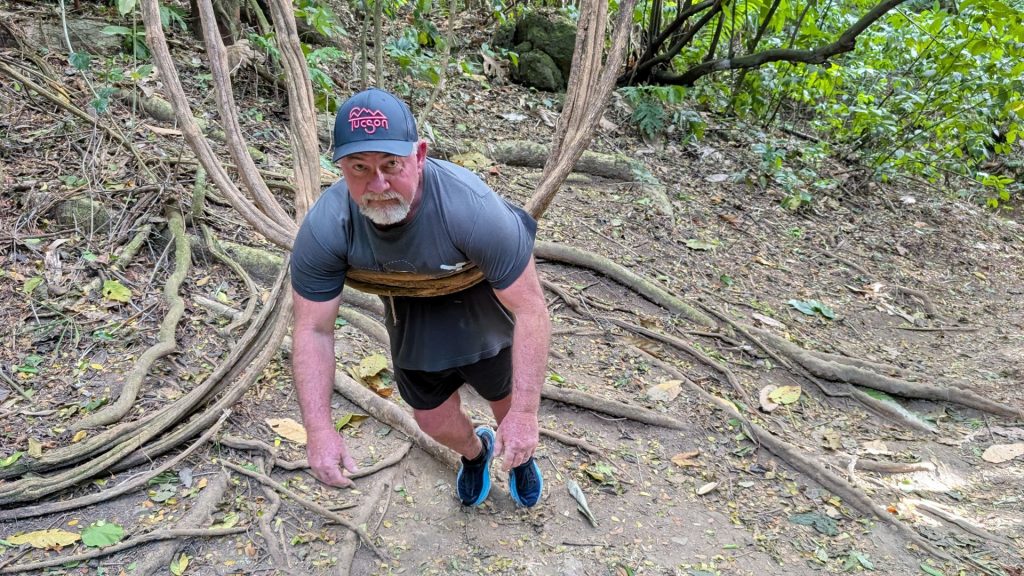
We were wondering how easy it would be to launch the dinghy into the surf for the ride back to Seahike. We lucked out again! This time it was in the form of six strapping young men who were standing in the water chatting. When they saw us turning the dinghy to go bow first into the water, they offered to help. So we all walked the dinghy out, then Caroline, Jim and I got into the dinghy. Jim rowed us and the guys gave us a push. Once we were beyond the surf, we started the motor. Nice!
We headed to Saint-Pierre, where we had reserved a mooring ball for the night. We were supposed to arrive no later than 6:00 p.m.
We were late. Forty minutes late. When we radioed for assistance, the guy told us several times that we were late, but he still showed up in his dinghy and led us to our ball (we never would have found it without him in this huge and full mooring field!) and helped us tie up. I apologize and thanked him numerous times. Within 10 minutes of being attached to the ball, it was pitch black.
We visited Saint-Pierre the morning of the 25th, then motor sailed to Grande Anse d’Arlet anchorage.
Saint-Pierre has a rather tragic history. It was founded in 1635 by Pierre Belain d’Esnambuc, a French trader and adventurer, as the first permanent French colony on the island of Martinique. The Great Hurricane of 1780 produced a storm-surge of eight meters (25 ft) which inundated the city, destroying all houses and killed 9,000 people.
Saint Pierre was again destroyed when Mount Pelée erupted in 1902, killing more than 30,000 people within minutes. It was a devastating event, notable as the worst volcanic disaster of the 20th century (and so far, the 21st). The entire population of the town, as well as people from neighboring villages who had taken refuge in the supposedly safe city, died, except for three people—a young girl, Havivra da Ifrile, a prisoner by the name of Louis-Auguste Cyparis, and Léon Compère-Léandre, who lived at the edge of the city.
A smidgeon of info about the three survivors:
Havivra Da Ifrile, a girl who survived by hiding inside a cave near the shore, reported a strange geological phenomenon: “…I looked back and the whole side of the mountain, facing towards the town, seemed to open and topple down on the screaming people. I was burned … by the stones and ashes that came flying …, but I got to the cave,…“
Louis-Auguste Cyparis (a.k.a. Ludger Sylbaris) was shielded from the immediate blast and its effects, including heat, debris, volcanic gas and ash, in an isolated outdoor jail cell. Four days after the eruption, a rescue team heard his cries from the rubble of the prison. Although badly burned, he survived and was able to provide an account of the event. He travelled with the Barnum & Bailey circus and became something of an early 20th-century celebrity.
Léon Compère-Léandre‘s description of the morning of May 8, 1902, follows.
“I felt a terrible wind blowing, the earth began to tremble, and the sky suddenly became dark. I turned to go into the house, with great difficulty climbed the three or four steps that separated me from my room, and felt my arms and legs burning, also my body. I dropped upon a table. At this moment four others sought refuge in my room, crying and writhing with pain, although their garments showed no sign of having been touched by flame. At the end of 10 minutes one of these, the young Delavaud girl, aged about 10 years, fell dead; the others left. I got up and went to another room, where I found the father Delavaud, still clothed and lying on the bed, dead. He was purple and inflated, but the clothing was intact. Crazed and almost overcome, I threw myself on a bed, inert and awaiting death. My senses returned to me in perhaps an hour, when I beheld the roof burning. With sufficient strength left, my legs bleeding and covered with burns, I ran to Fonds-Saint-Denis, six kilometres from St. Pierre.“
Rescuers found him and sent him to the town of Fort-de-France, where he was labeled as a madman. Shortly thereafter, he was deputized by the police, given a gun (because who doesn’t want to give a gun to a madman!?!) and sent to protect the ruins from looters. After a week of duty, he left the city on May 20, 1902, and started back towards Fort-de-France. He barely escaped a second death cloud. He eventually settled in the village of Morne Rouge, only to have another cloud pour through on August 30, 1902. He was again one of the few who survived. He lived on the island until his death in 1936 from a fall.
(BTW, the most scientifically viable theory as to how he actually survived is that Leon jumped into the ocean when the flow hit and survived despite the water’s boiling temperature.)
Back to the eruption. . .
Legend has it that the town’s doom was forecast by loud groaning noises from within the volcano, but the mayor of the town had it blocked off to prevent people from leaving during an election. This story appears to have originated with one of the island’s newspapers, published by a political opponent of the governor. Actually, there was considerable eruptive activity in the two weeks prior to the fatal blast, but since the phenomenon of the pyroclastic flow was not yet understood, the danger was perceived to be from lava flows, which, it was believed, would be stopped by two valleys between the volcano and the city.
Numerous ships were sunk due to the volcanic eruption. They were discovered in the early 1980’s by Michel Météry [fr], a diver and wreck hunter. From his discoveries, he wrote a book Tamaya – The Wrecks of Saint-Pierre, which was prefaced by Jacques-Yves Cousteau and Albert Falco. Today the wrecks are a reference in terms of scuba diving in Martinique.
This is a good short read about the wrecks: https://en.wikipedia.org/wiki/Wrecks_of_Saint-Pierre_harbor. Excerpt:
“The disappearance of the port administration’s archives made it impossible to compile an exhaustive list of the shipwrecks caused by the disaster. A total was established based on statistics published in 1904 by the National Establishment for Disabled Marines and various testimonies. It estimates the losses at 386 French ships and boats, mainly coastal vessels and fishing boats, eight foreign vessels, 647 crew members, and 34 passengers. Like the town, they were destroyed in an instant.”
The city of Saint-Pierre was never restored to its former entirety, though some villages were built in later decades in its place. Today, the town is the seat of the Arrondissement of Saint-Pierre. It has been designated as a “City of Art and History.”
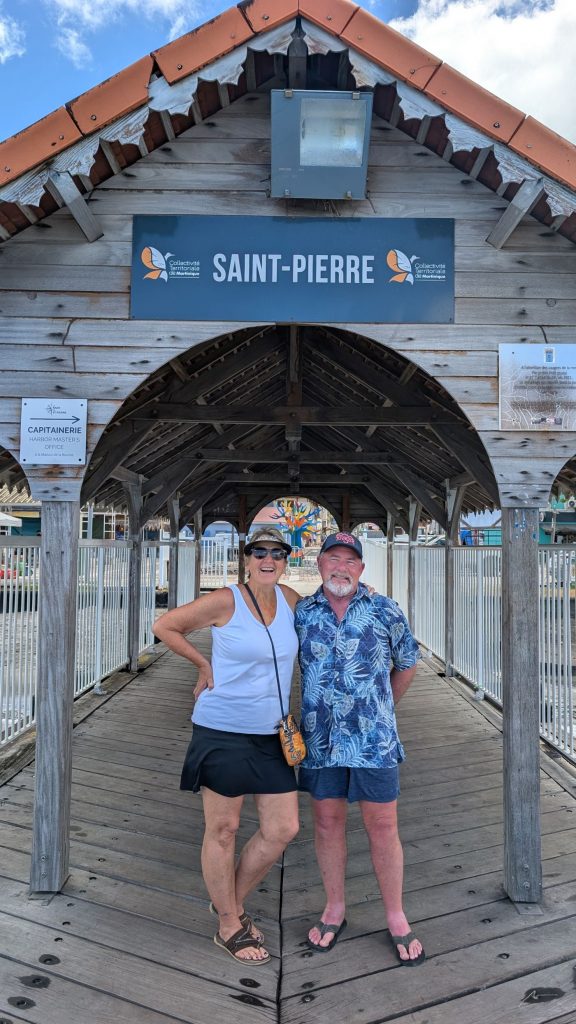
Our first visit was to the cathedral of Notre-Dame-de-l’Assomption or Notre-Dame-du-Bon-Port cathedral, previously called the Church of the Anchorage. It has been damaged multiple times (shocking, I know). This is the current look.
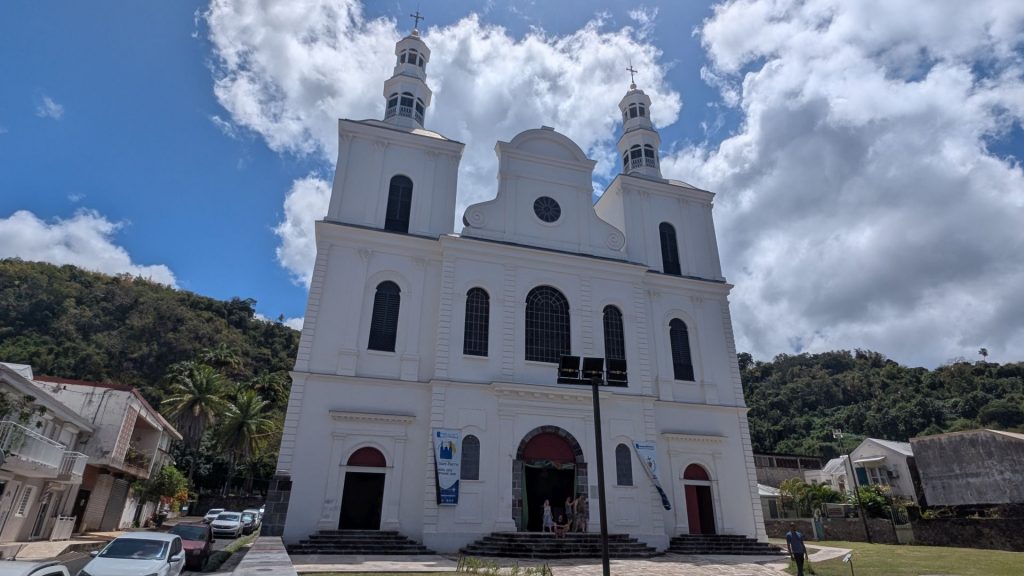
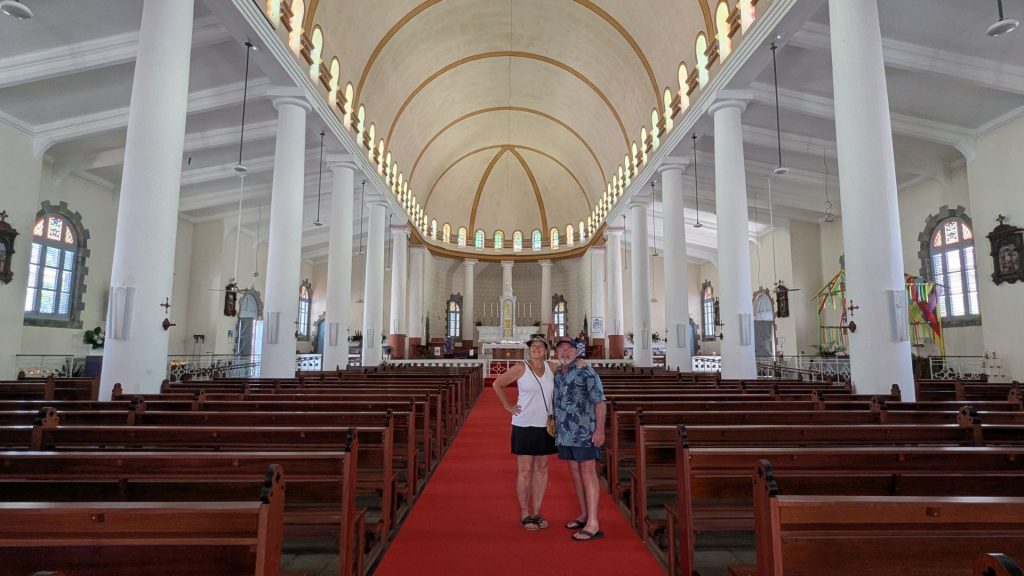
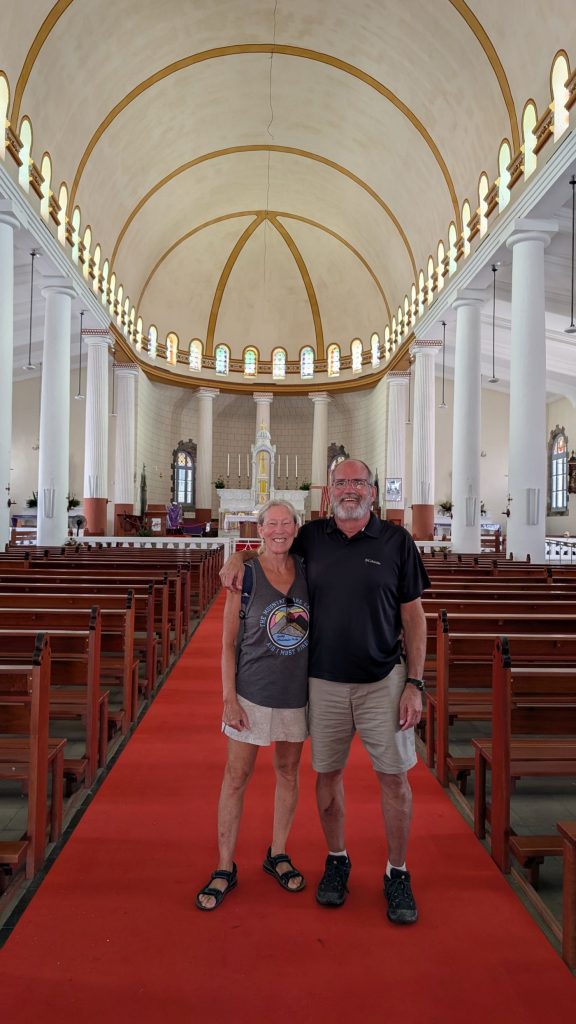
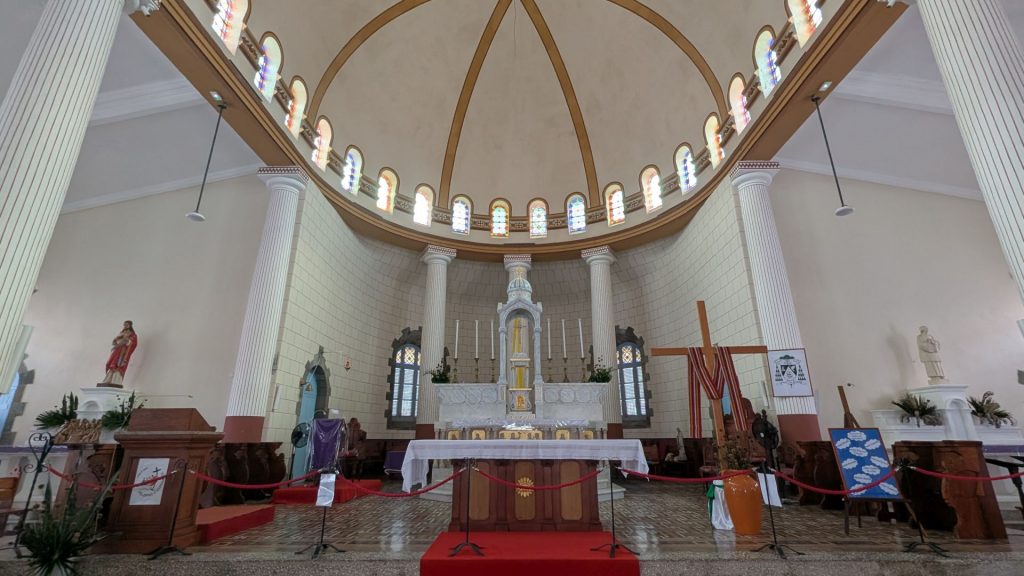

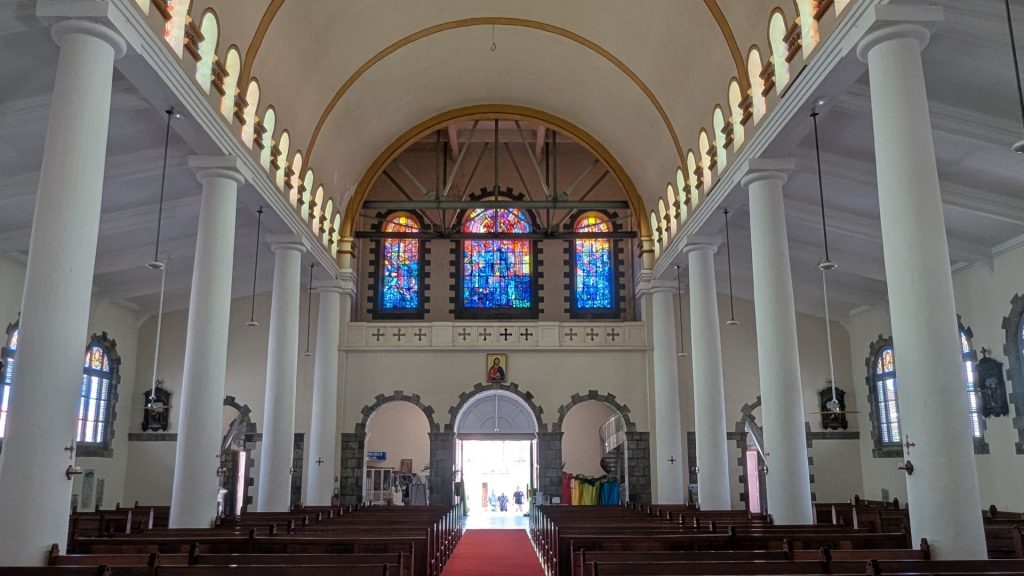
Our next visit was to The Mémorial de la catastrophe de 1902 | Musée Frank A. Perret. It is described as follows:
“Conceived around the catastrophe by the American volcanologist and philanthropist Frank A. Perret, the museum opened in 1933. The first ever museum ever built in Martinique, it had three purposes: Scientific, artistic and humanitarian.
Entirely restructured, the museum was renovated in 2019. . . . its aim now is to provide an anchor, an emotional experience and an instrument of cultural excellence. Both a place of conservation and transmission, the museum, now a memorial, is actively serving shared heritage, knowledge and memory.”
Cork shaper, Fonte (1830-1902):
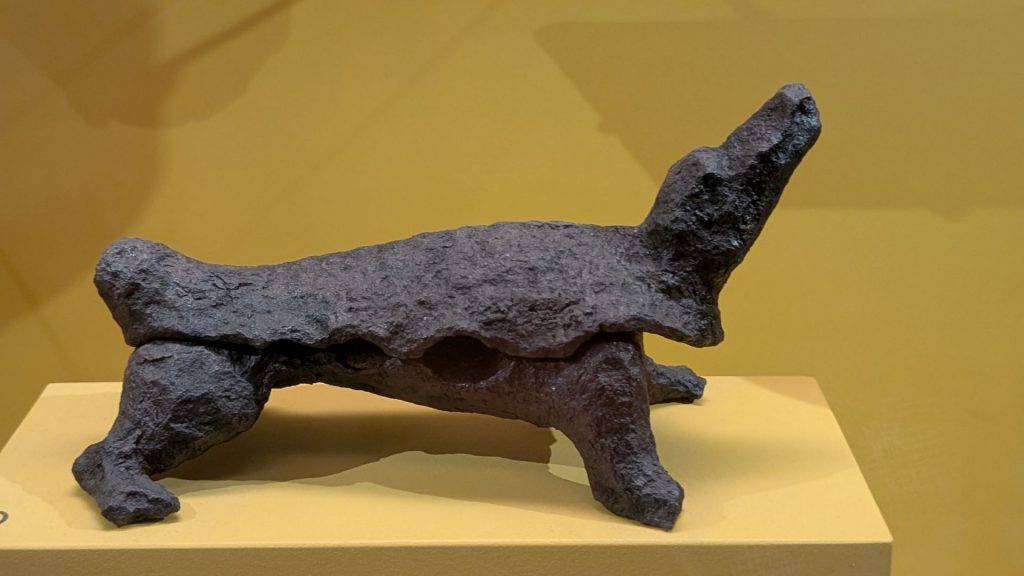
Tape measure, cotton reel, buttons, sewing machine (circa 1902):
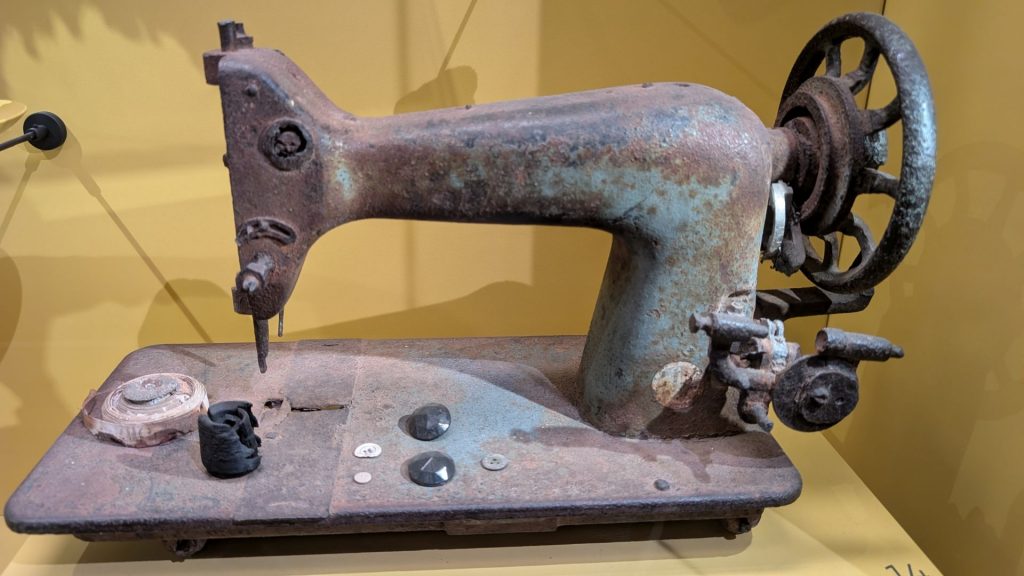
Fob watches:
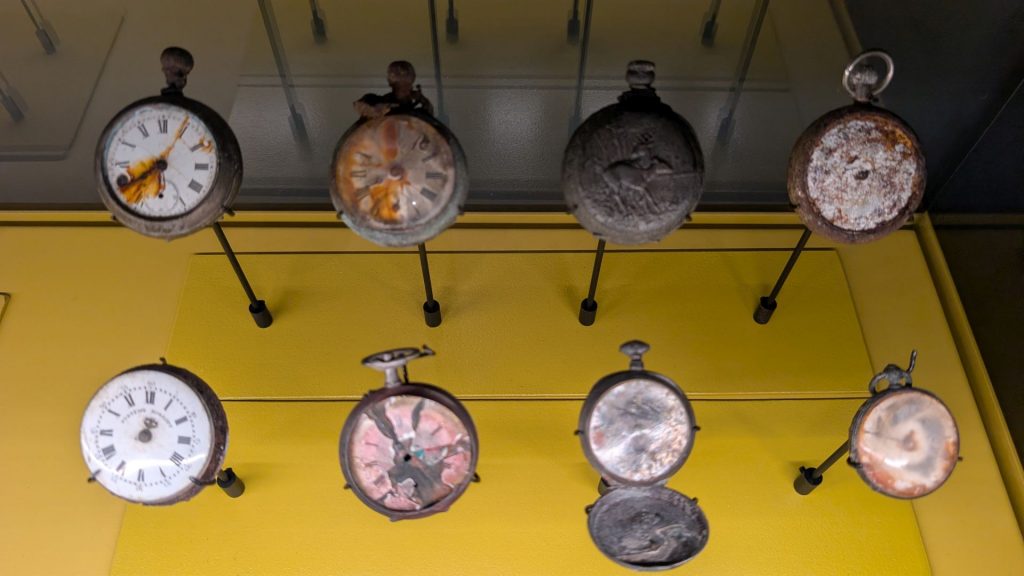
Cobbler’s punch:
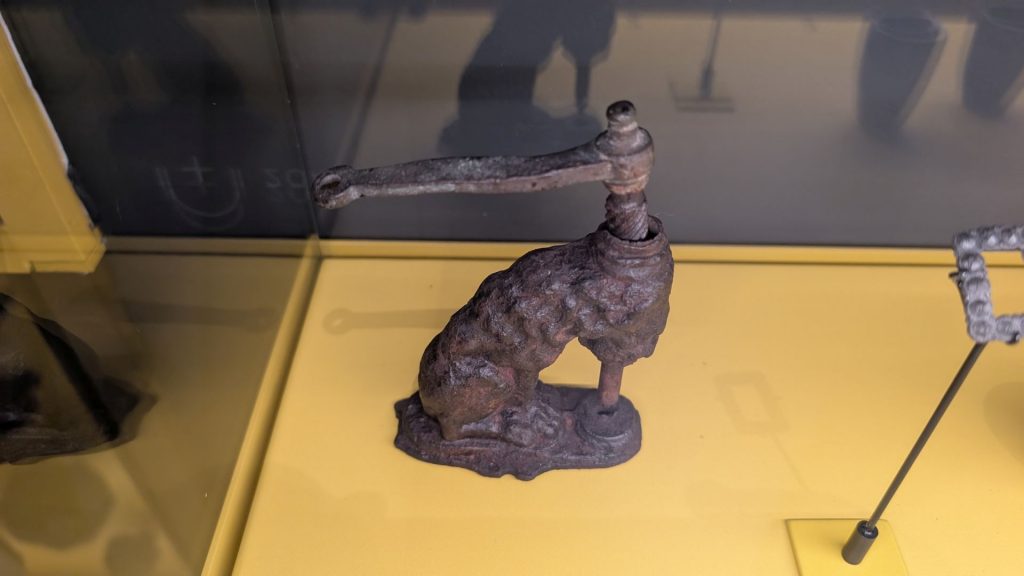
Marching symbol, tuba pistons, clarinet (lower joint), tuba with three pistons, opera glasses:
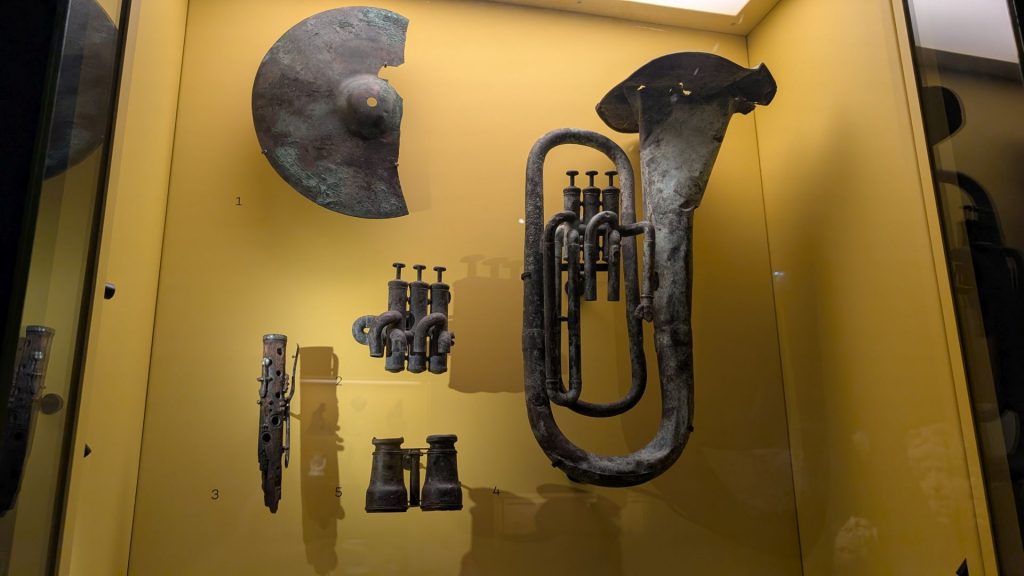
Bronze bell (1865):
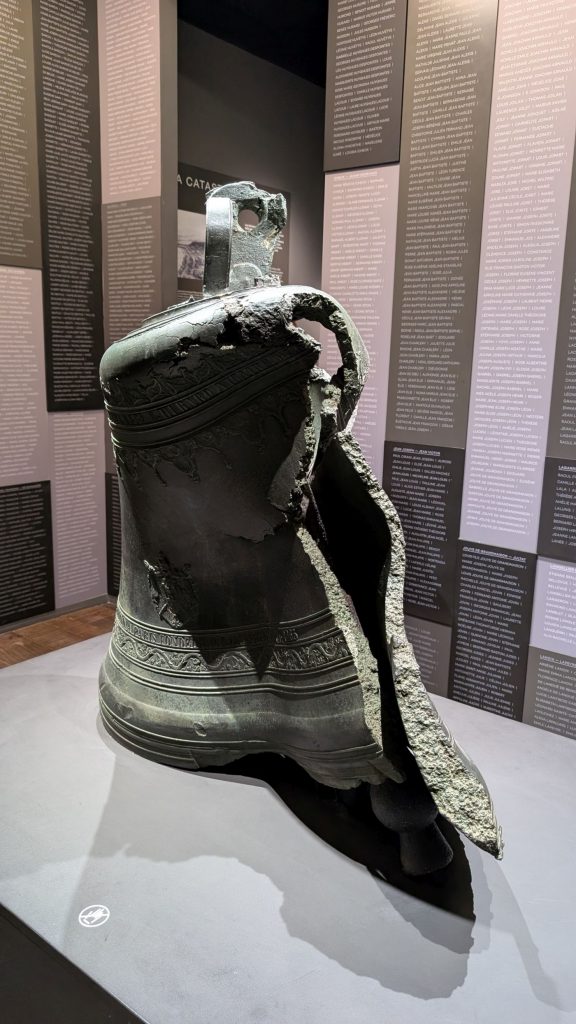
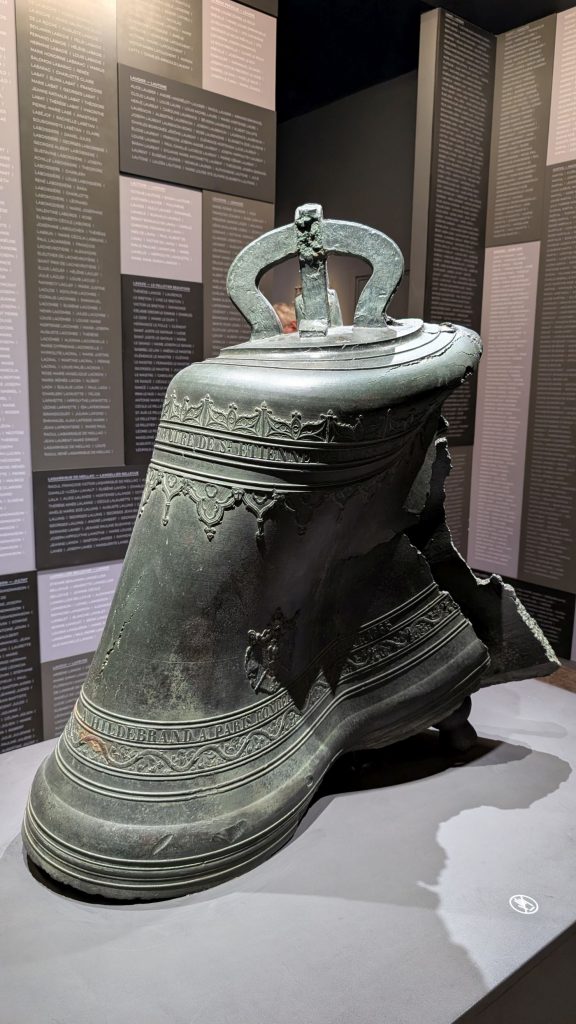
Melted lamp glass:
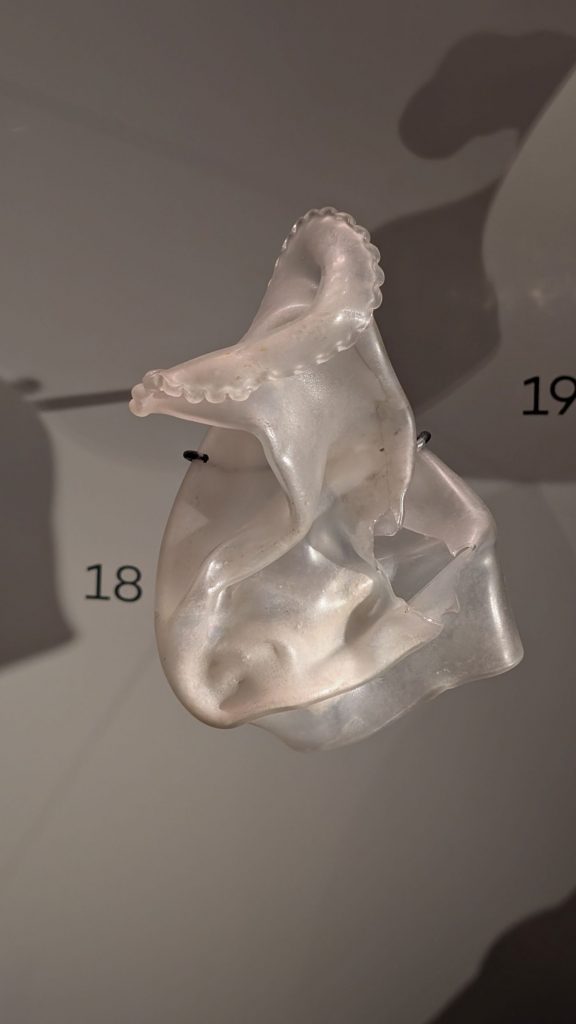
Endomorphic agglomeration (jugs, cooking pots):
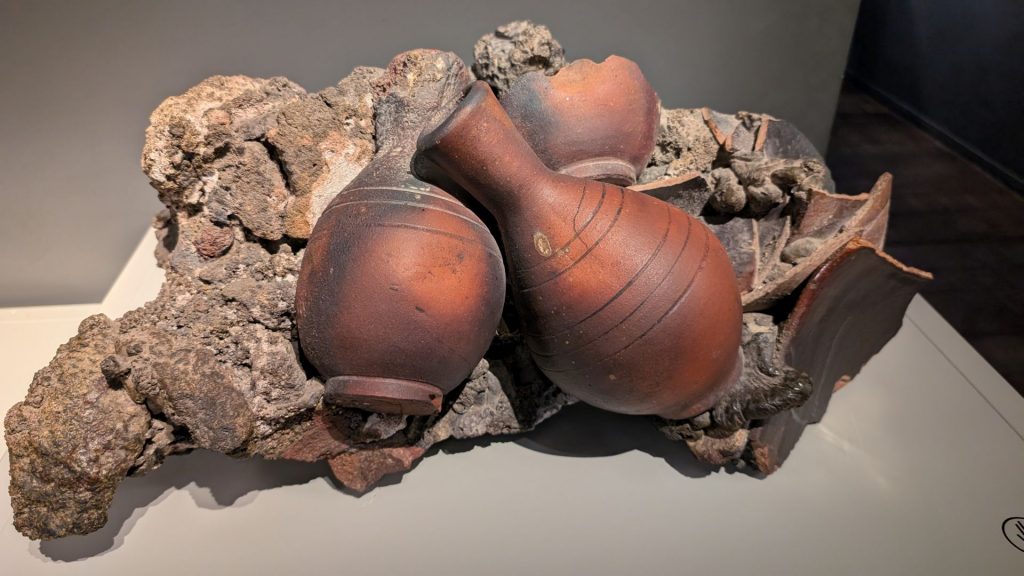
“Cyparis’s” cell grating:
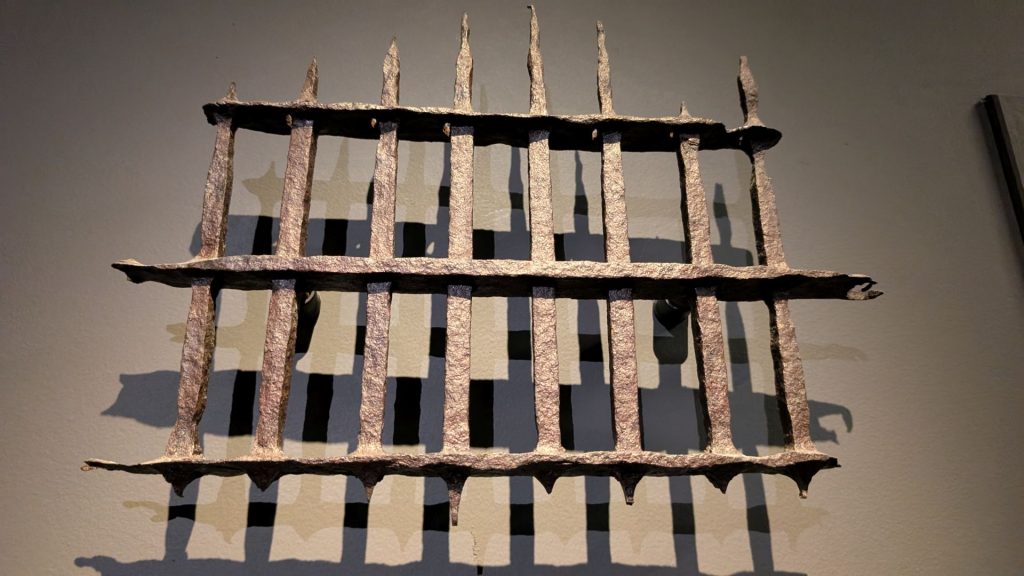
“Cyparis’s” cell latch:
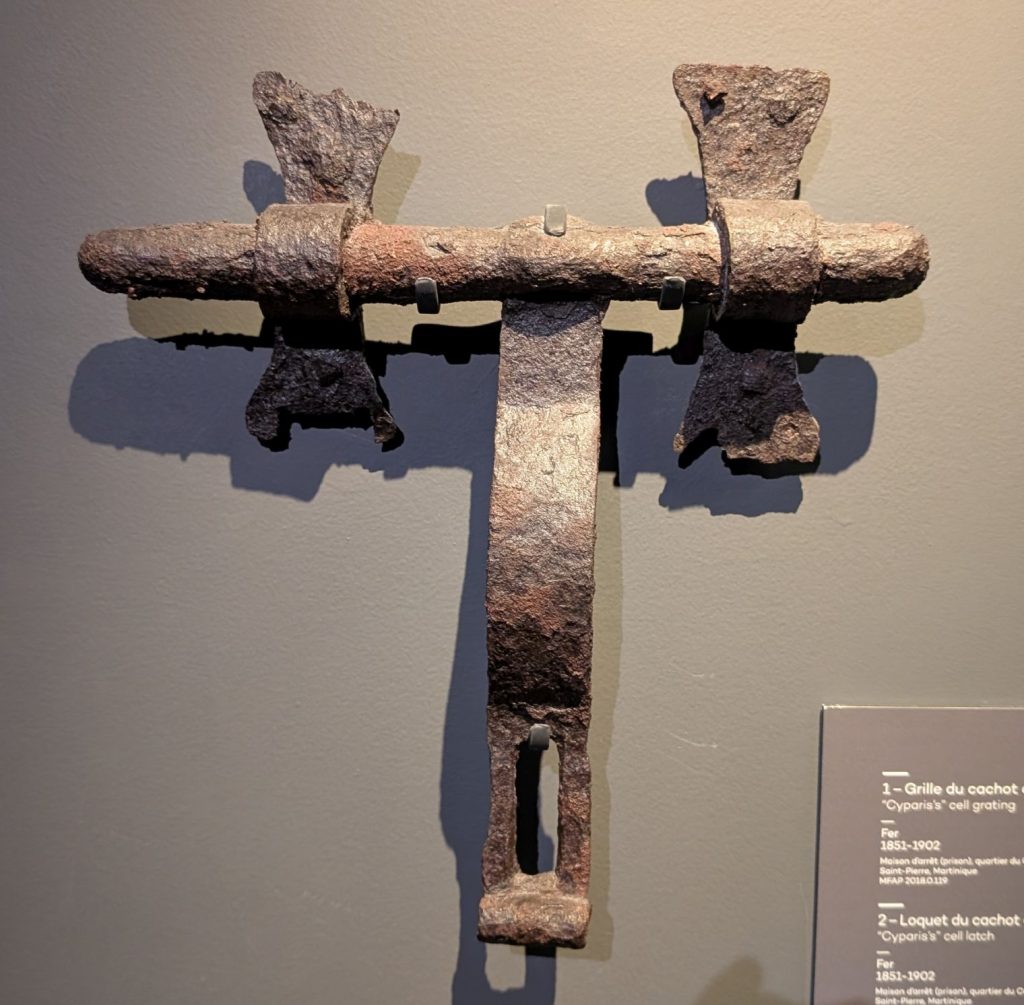
Two of the walls listing the names of the dead:
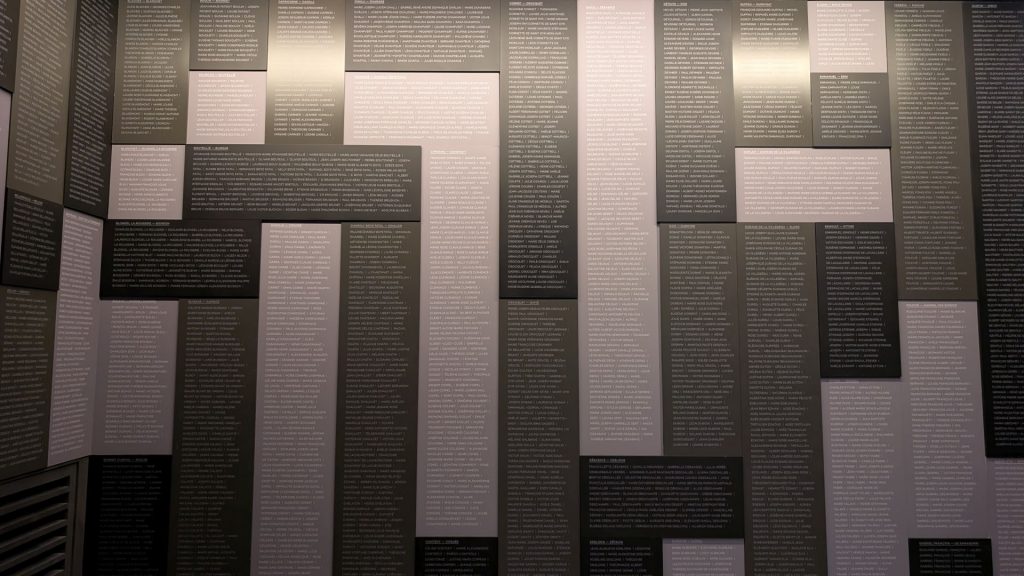
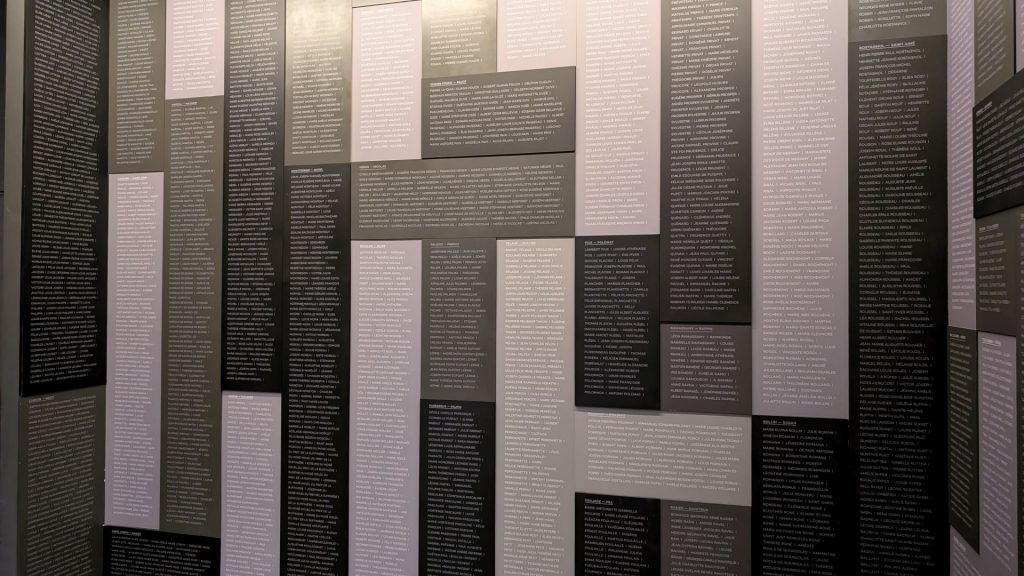
Volcanic ash measuring cylinder:
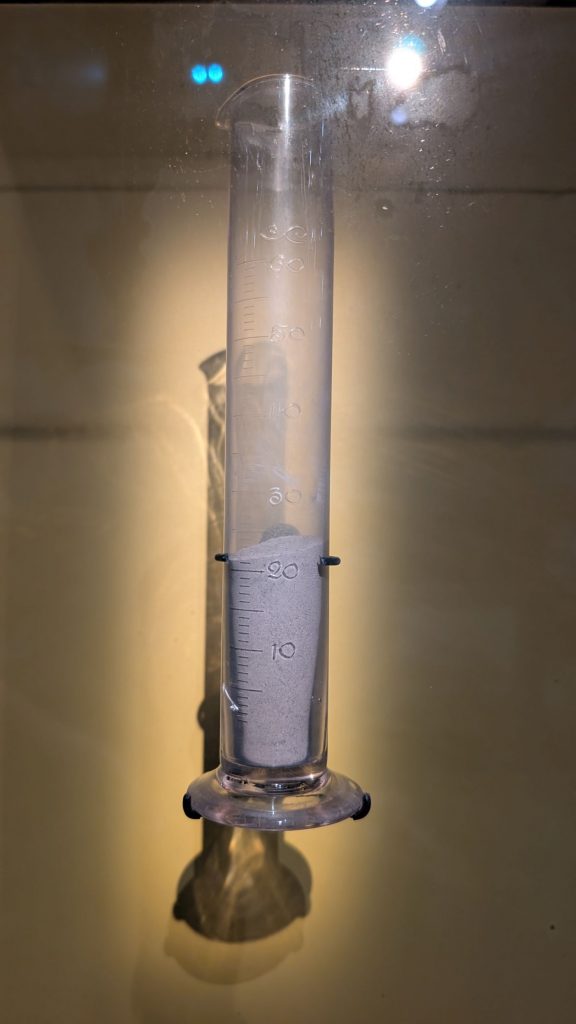
Fountain: The Three Graces, modeled after Germain Pilon’s 16th century monument of the “Three Graces.” By Val d’Osne Foundry, France.
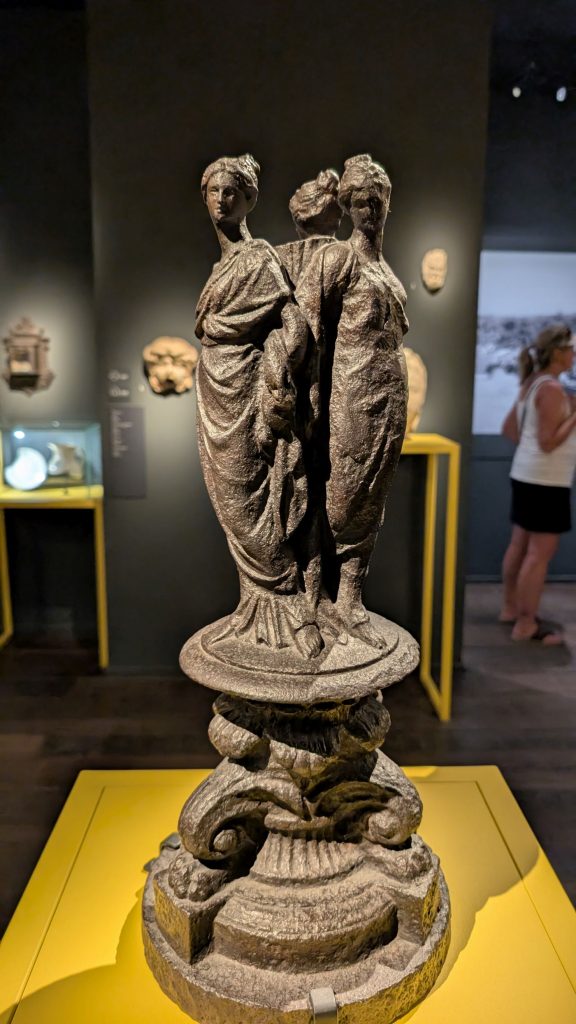

That was just a small sample of the many wonderful and hauntingly beautiful items located in the memorial.
It was time to visit some outdoor ruins. How about the theater?
The Théâtre de Saint-Pierre, also known as La Comédie, was an historical theater that was destroyed in the 1902 eruption. It was a prominent cultural center in the West Indies for over a century, active from 1786 to 1902. The theater was a significant part of Saint-Pierre’s cultural landscape, hosting theatrical performances and operas by famous authors. It was a replica of the Grand Theatre in Bordeaux and could accommodate 800 spectators. Today, the ruins of the theater are a historical monument and a tourist attraction.
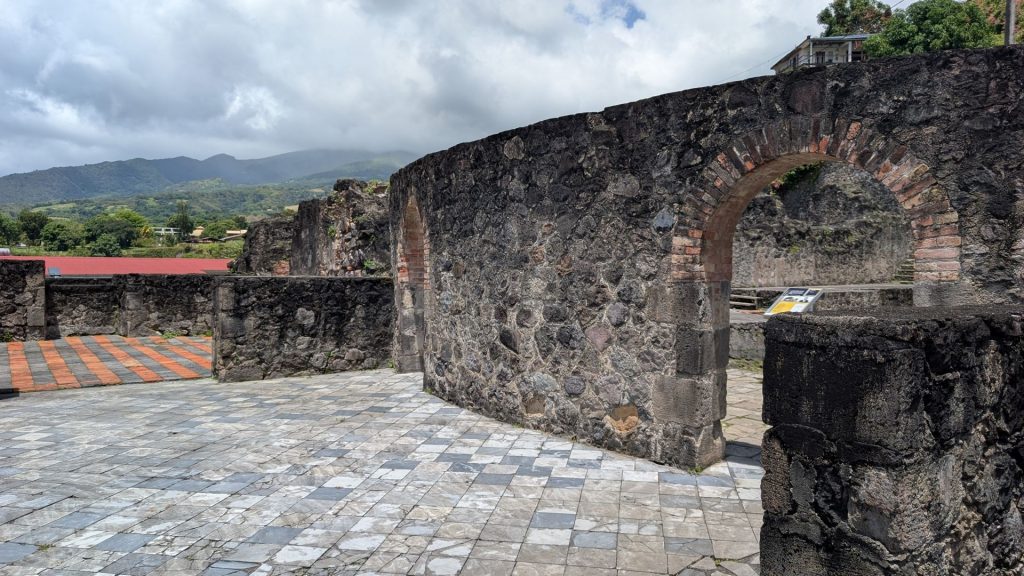
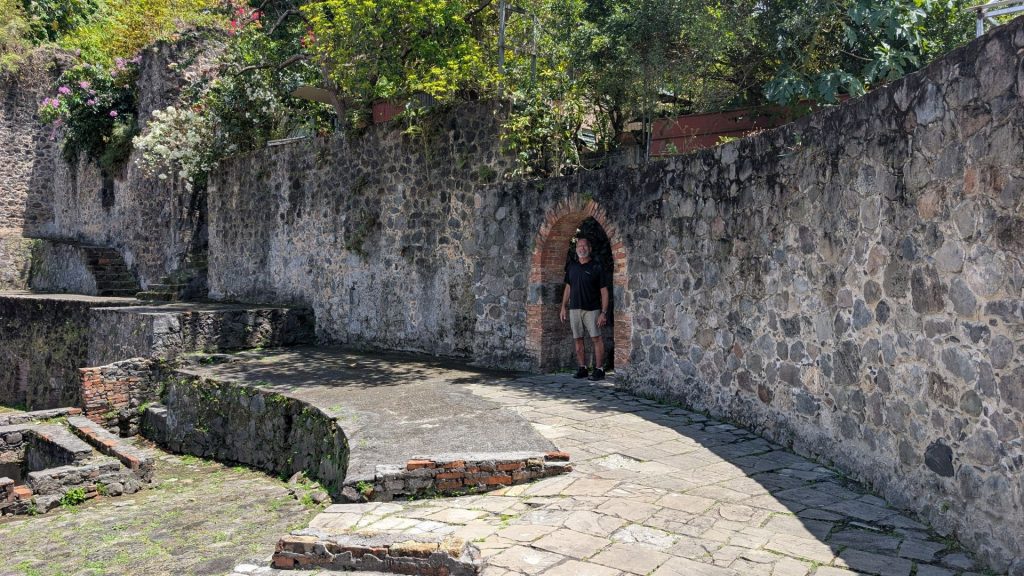
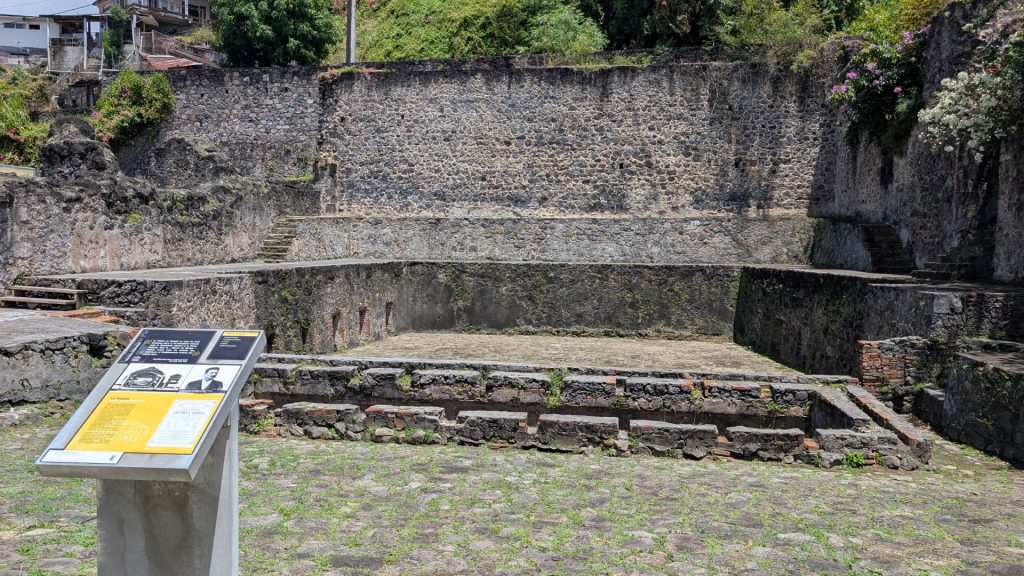
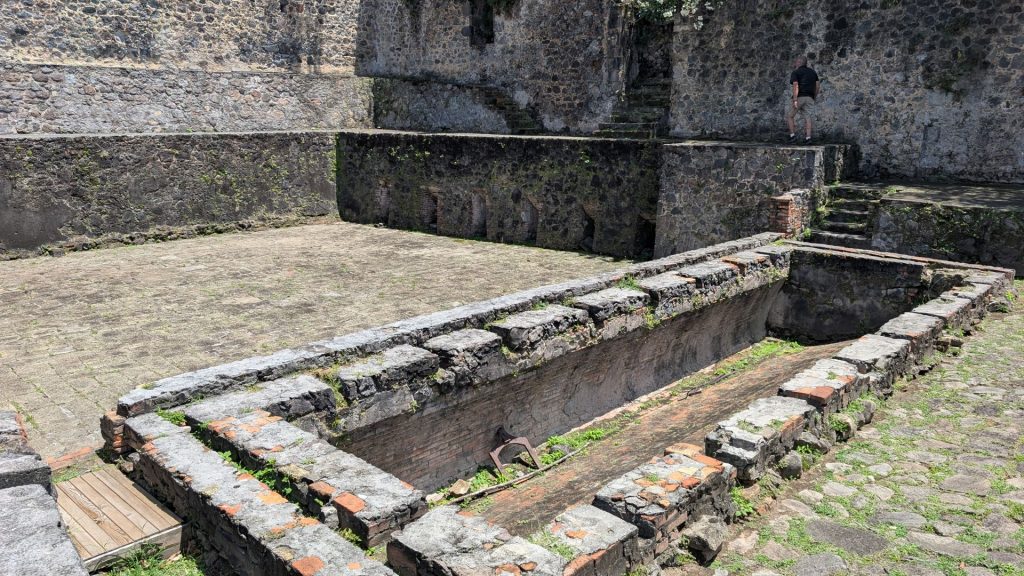
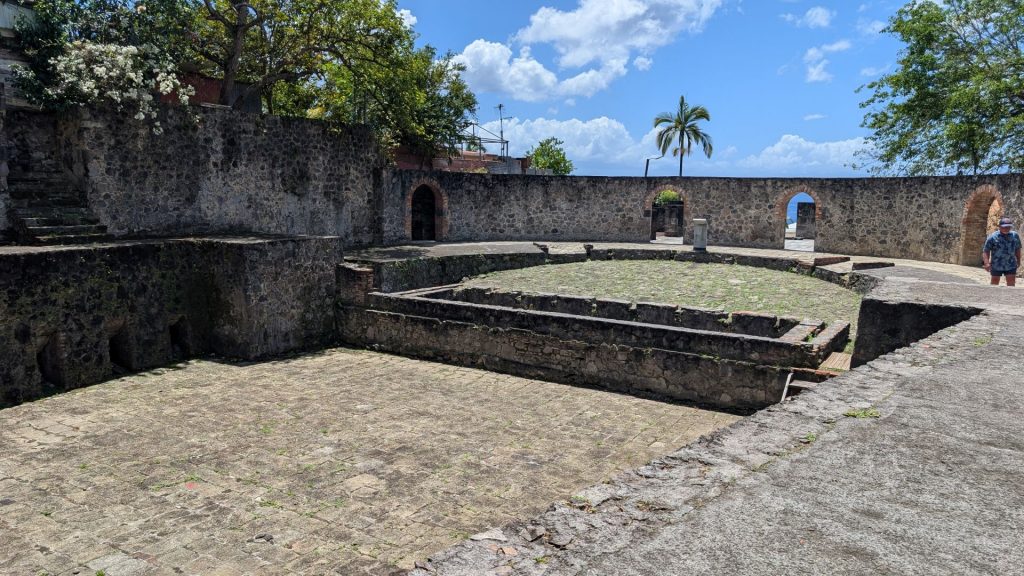
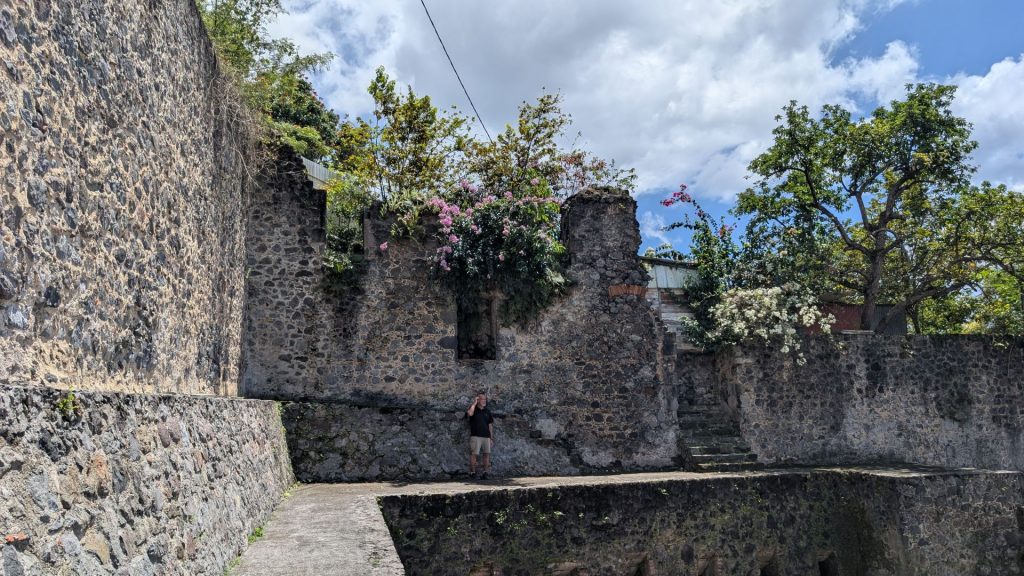
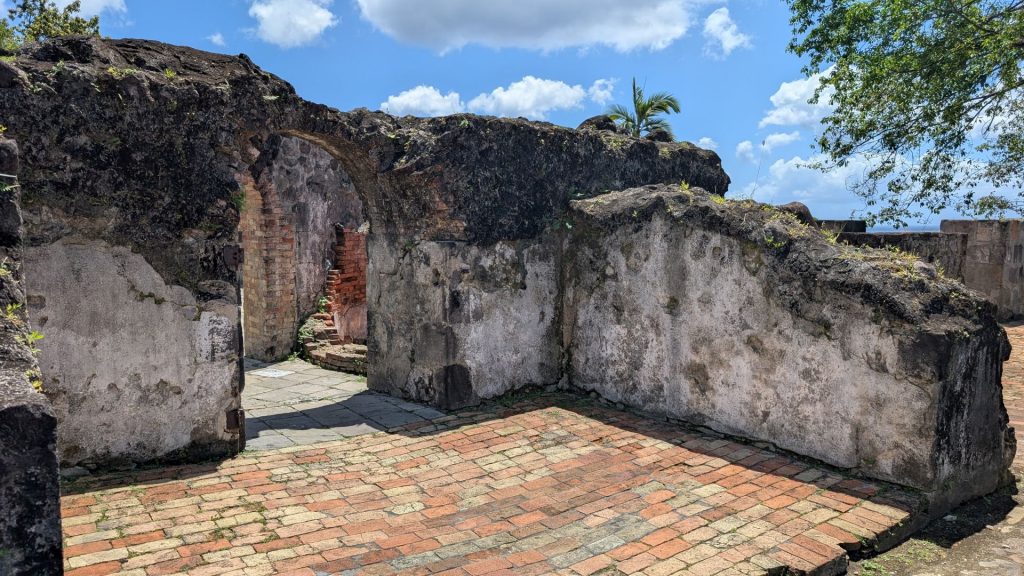
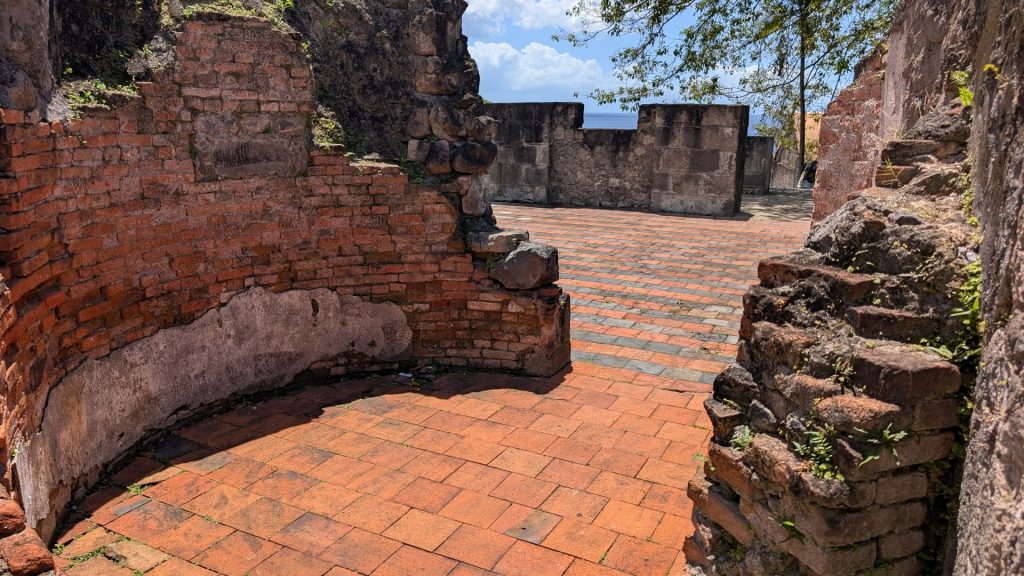
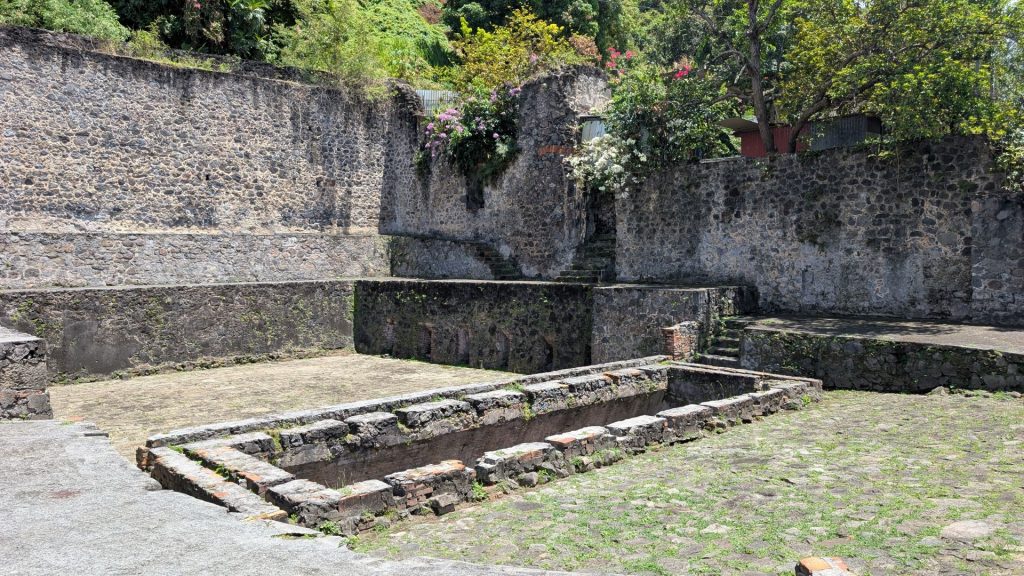
This statue, near the theater’s entrance, was created by Madeleine Jouvray, an assistant of Auguste Rodin’s studio. It bears witness to the desire to give life back to the martyred town. It was inaugurated in 1917 opposite the Place Bertin pier and later moved to the former theater.
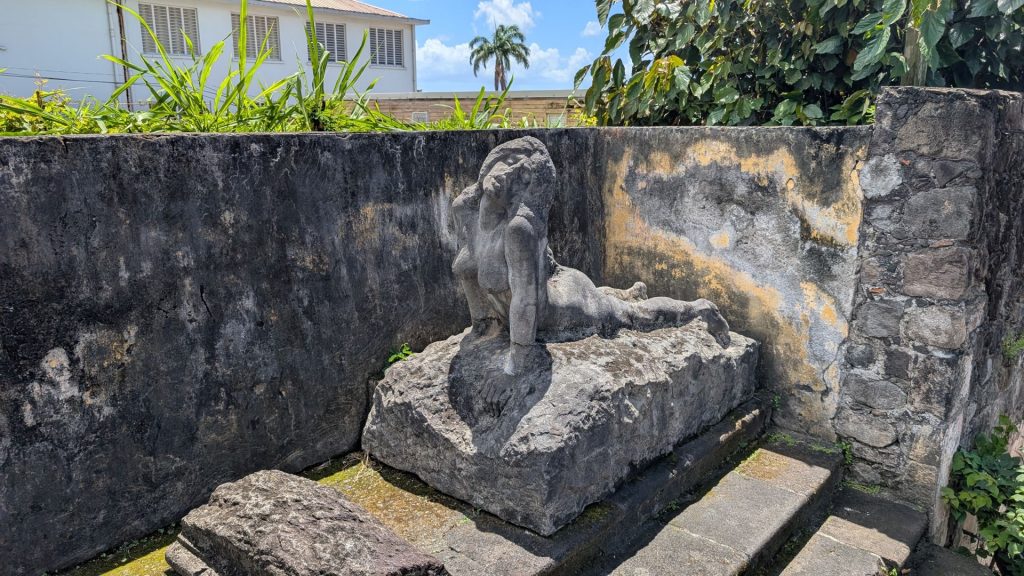
And what is located right next to the former theater? Why, the former prison, where Cyparis was held. This is a picture the former theater on the left, then a wall, then the remains of the prison on the right:
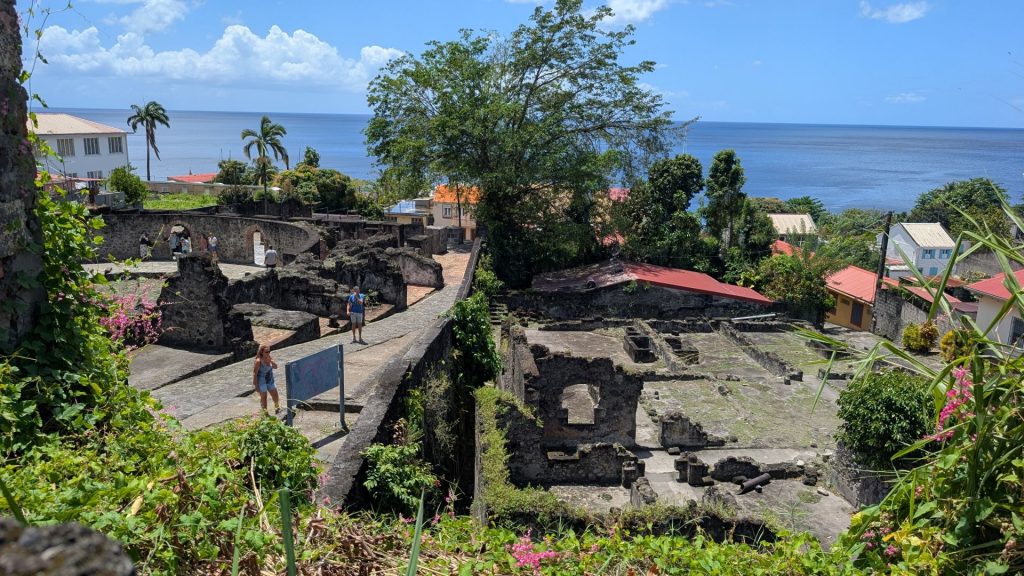
Part of the former prison (below). The posted sign, which explains how Cyparis survived the eruption by being in prison reads:
“The thick walls, the rare openings oriented towards the south-west, on the opposite side to the volcano, or virtually backing on to the eastern perimeter wall, meant that the prisoner avoided direct contact with a massive influx of burning gas. The very location of the dungeon, situated at the foot of Morne Abel and equipped itself with two restraining walls, protected the dungeon from the blast caused by the explosion on 8 May 1902.”
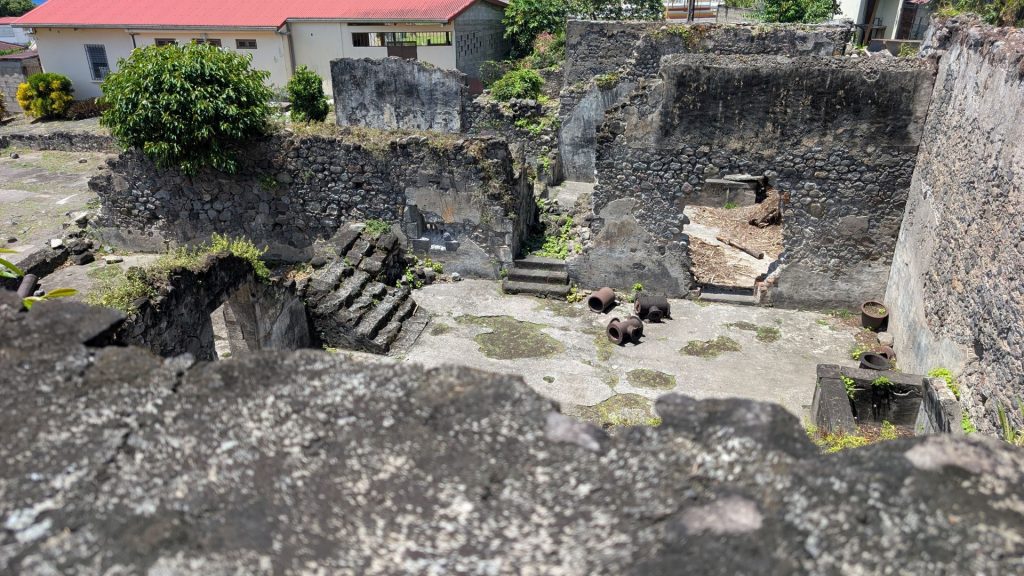
The prison diagram. Note the location of the theater (see the “Theatre” notation at the bottom) to get oriented. Cyparis’s cell is in the bottom right-hand corner.
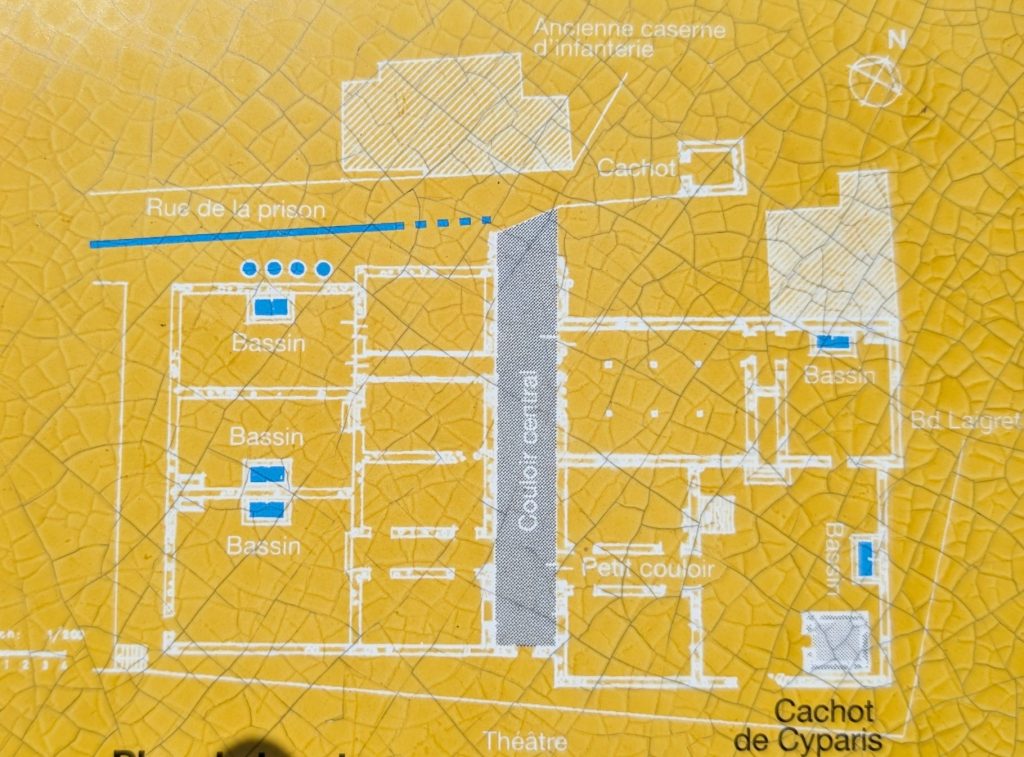
And now let’s see Cyparis’ cell and take a closer look at the prison from within it.
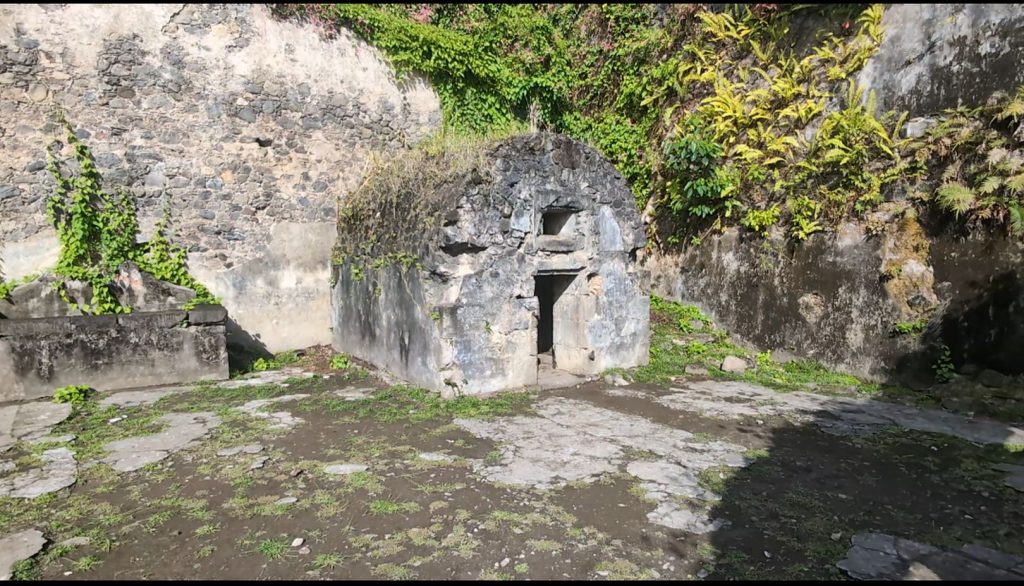
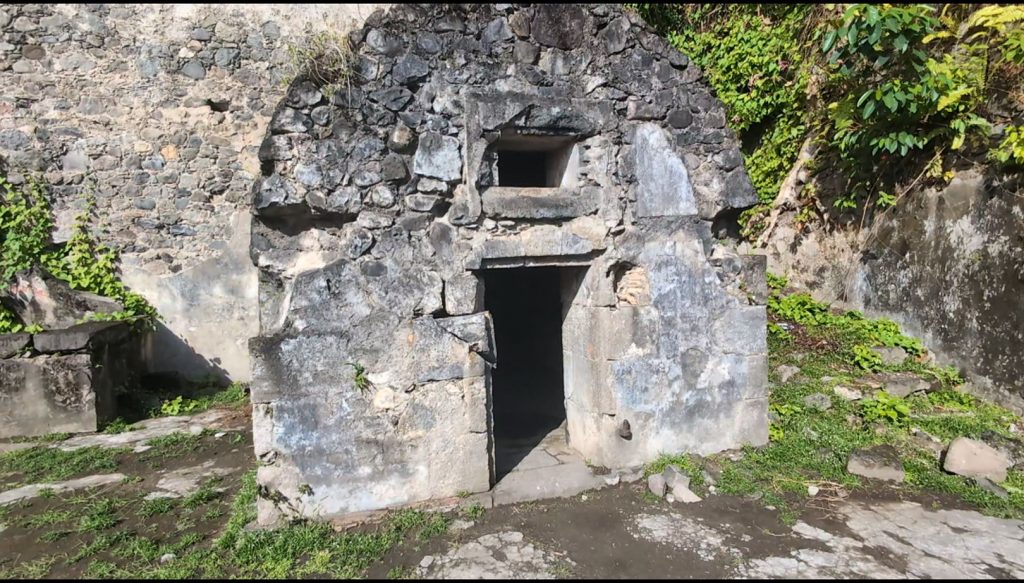
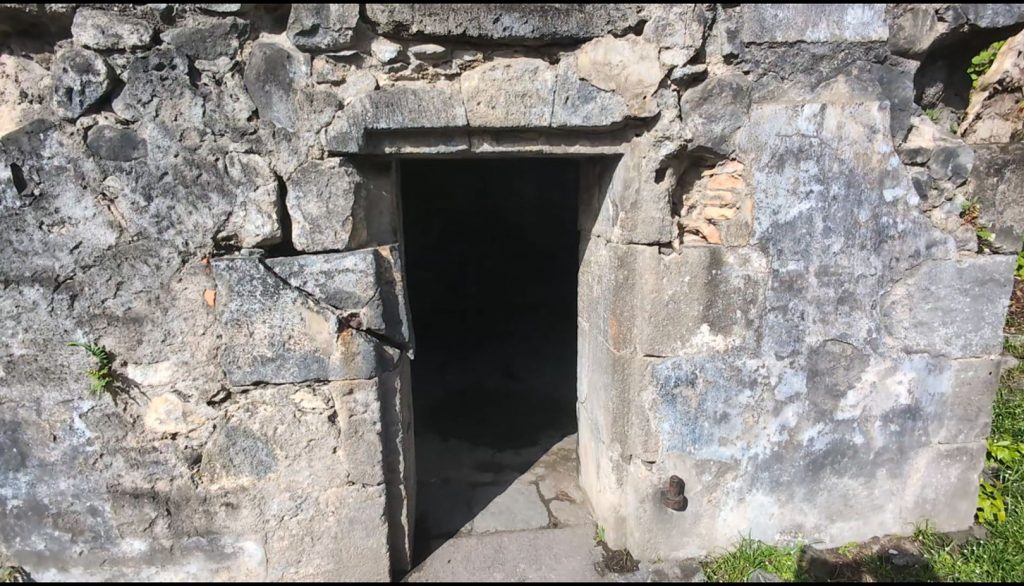
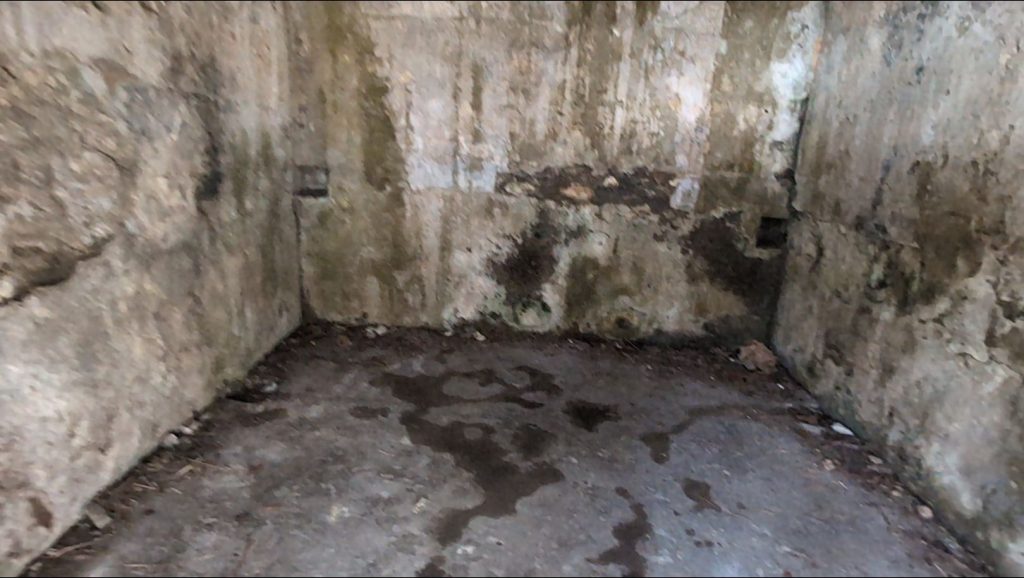
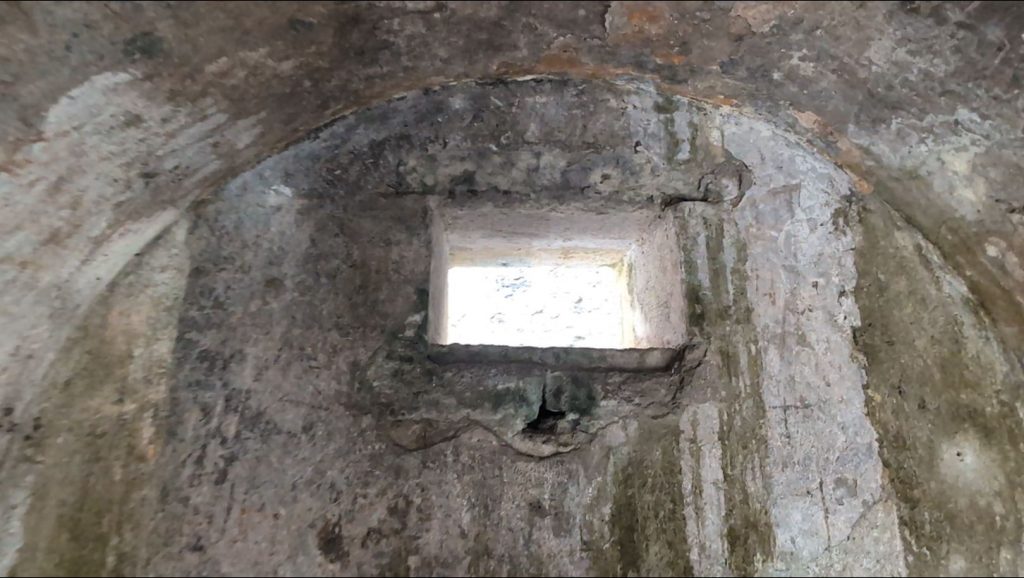
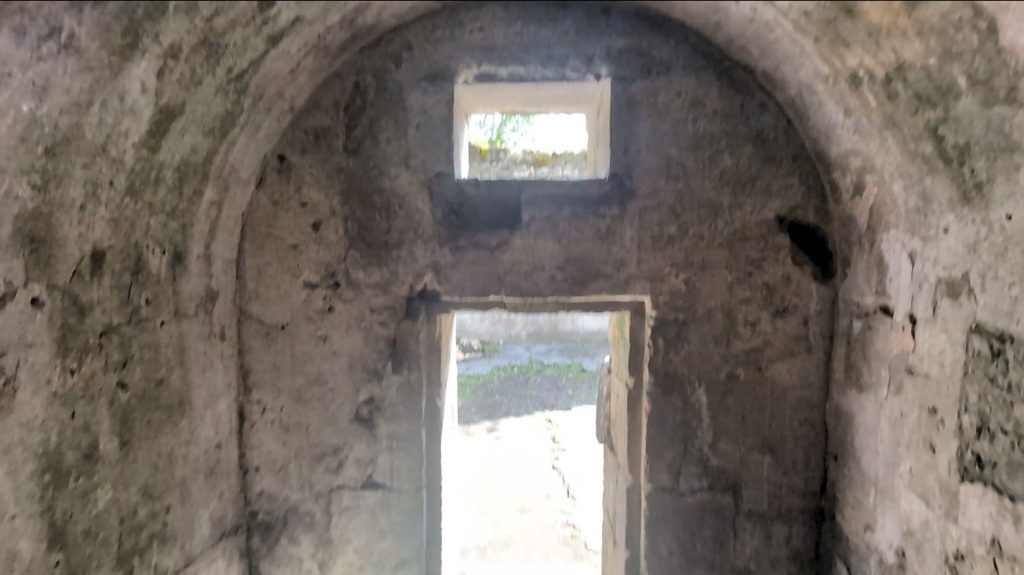
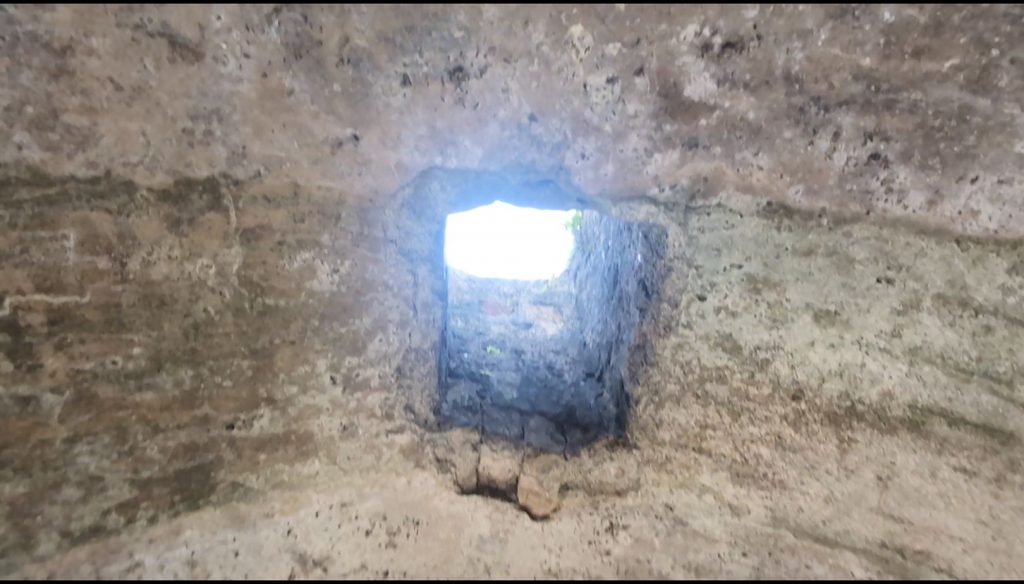
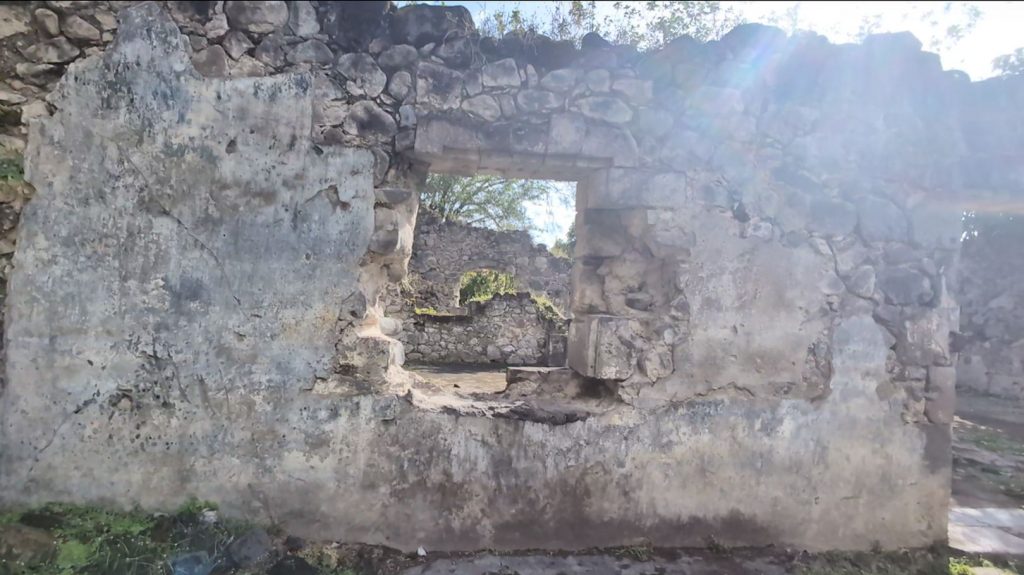
More of the prison:
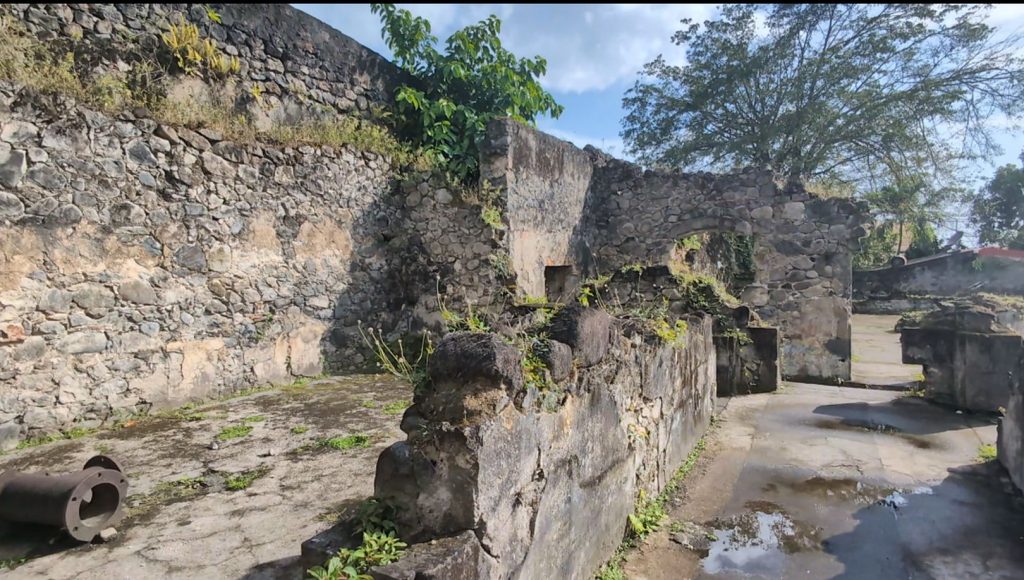
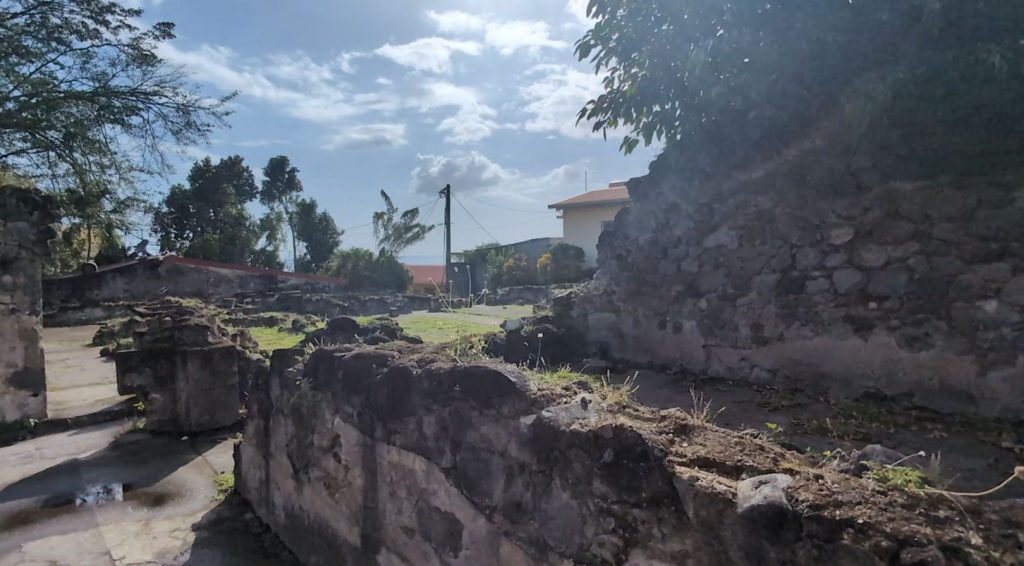
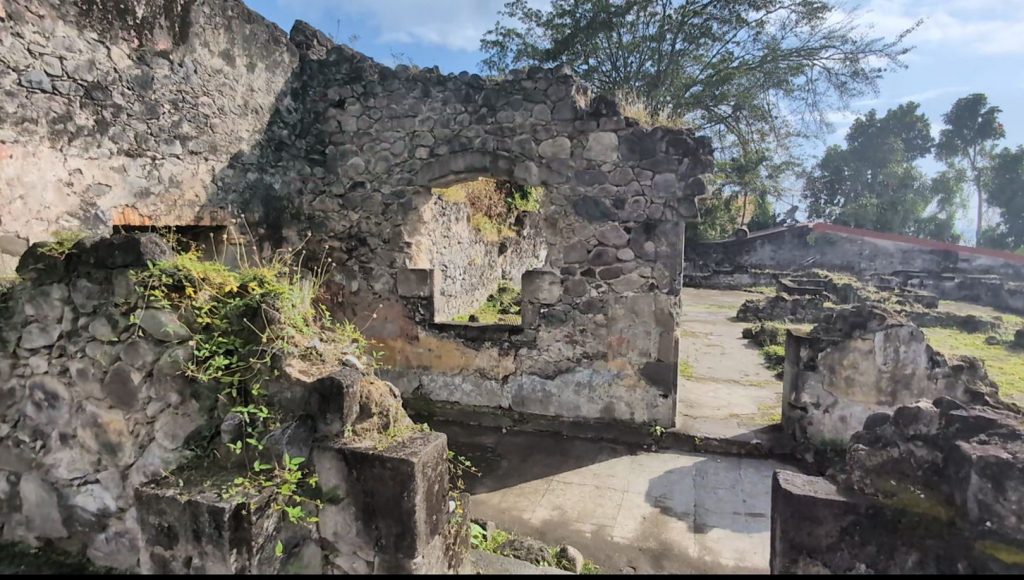
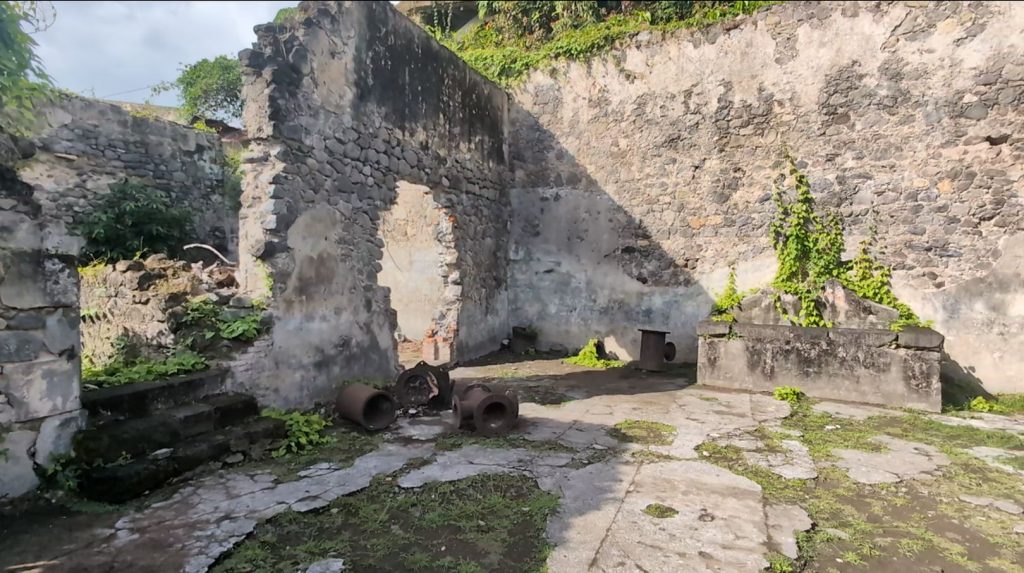
It was time to find a restaurant. Here are some sights along the way.
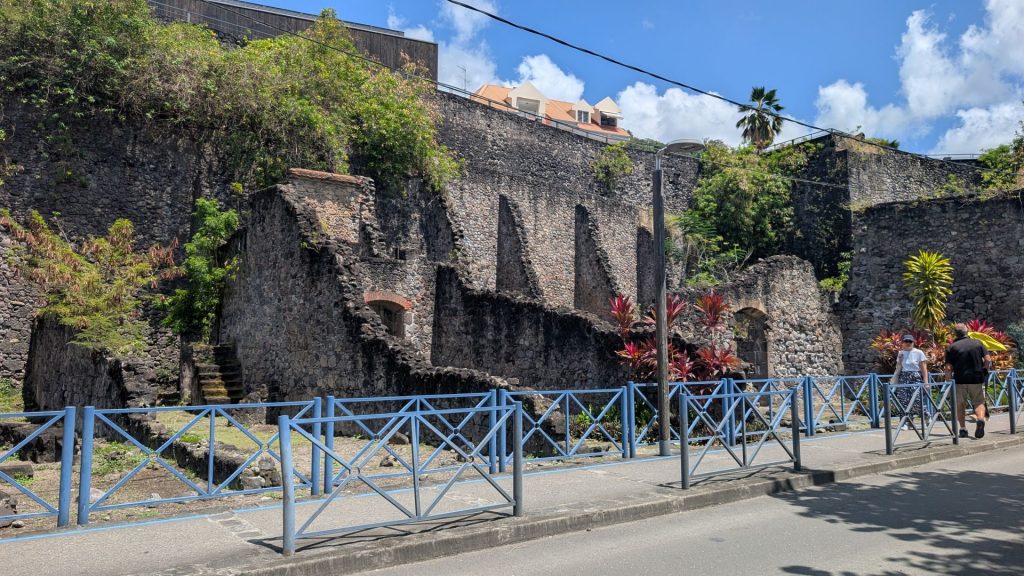
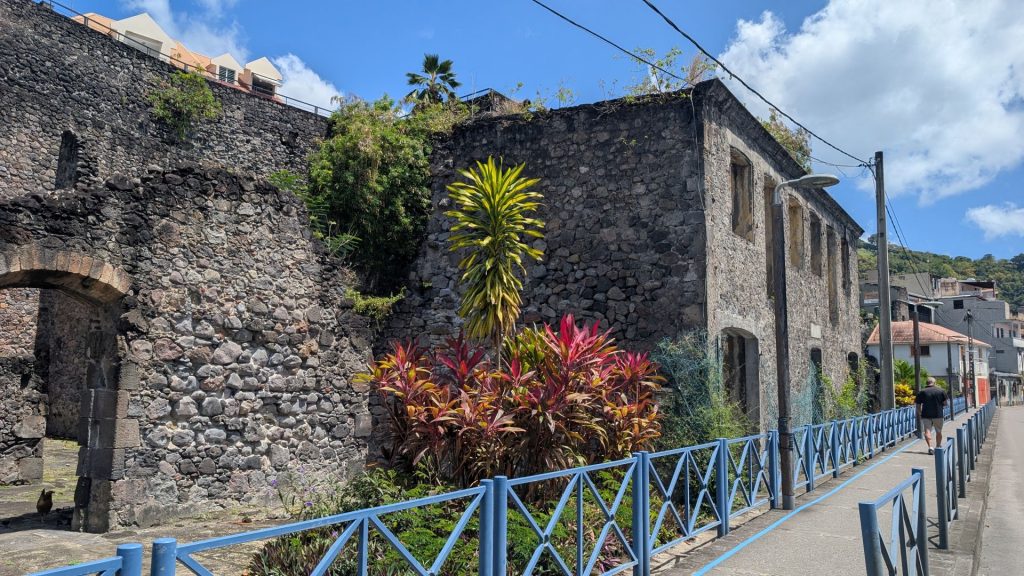
No pictures of lunch, but it was okay. Then we were on our way to the Grande Anse d’Arlet anchorage.
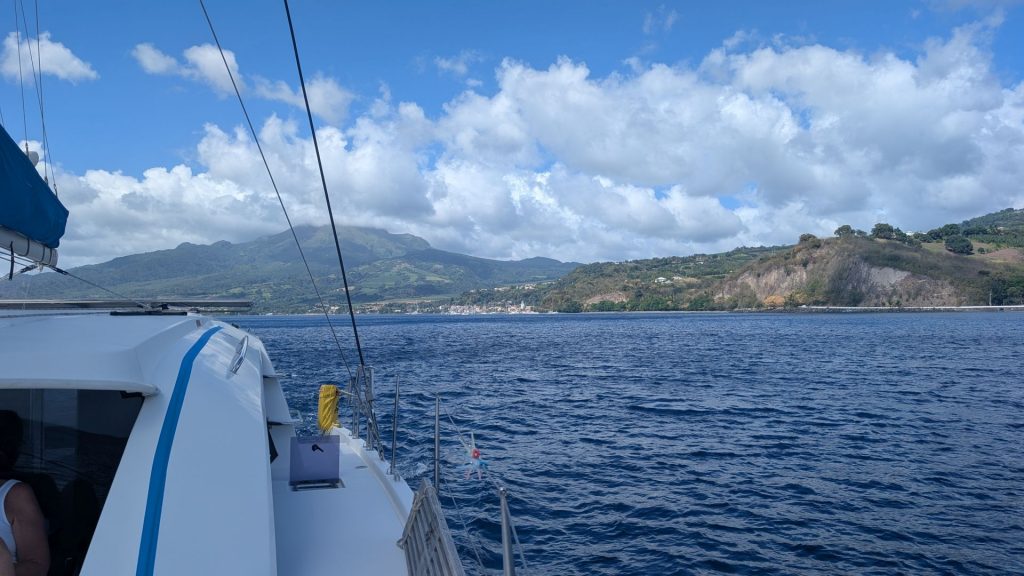

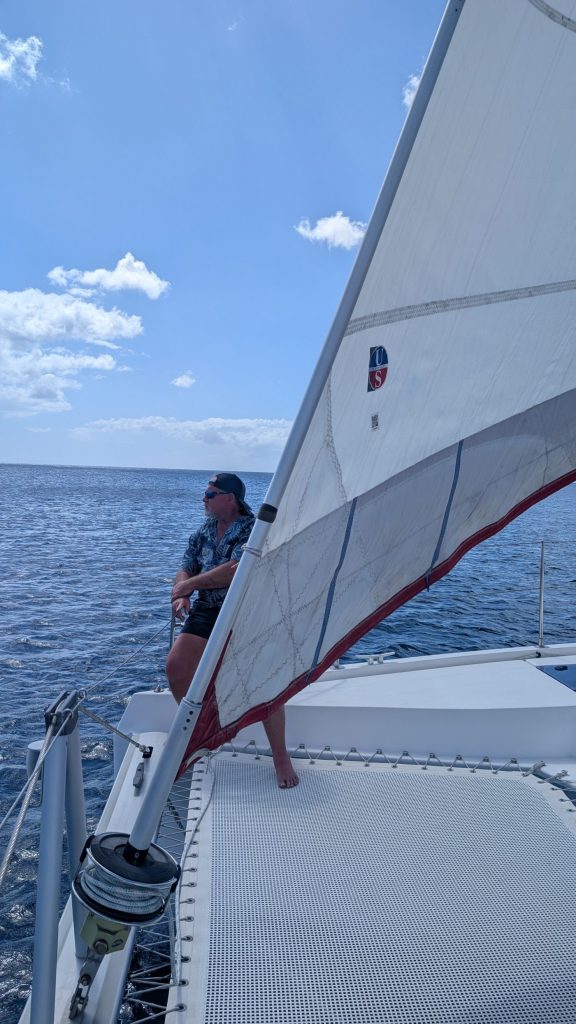
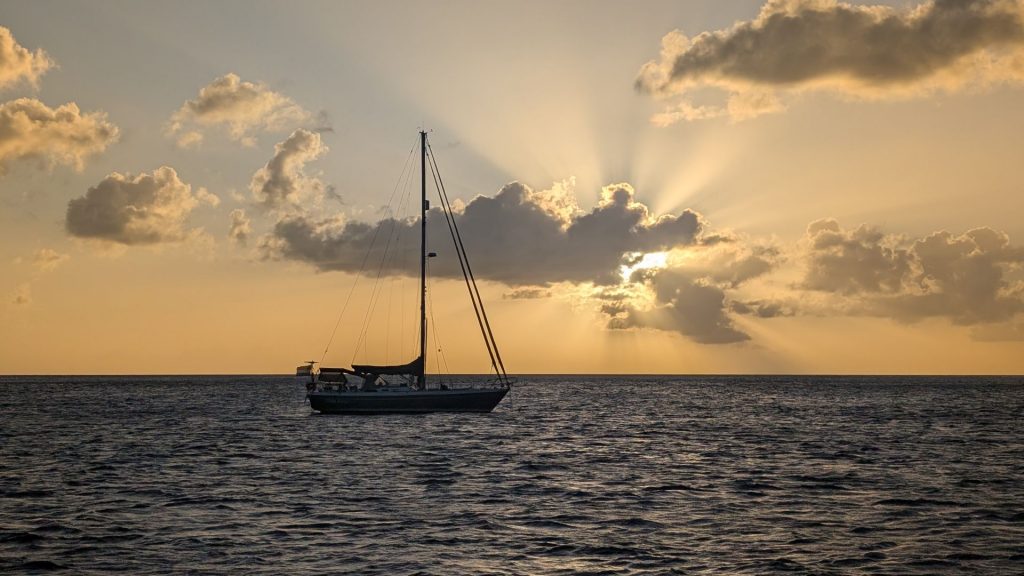
We woke up on the 26th trying to decide how to spend our last full day together. We finally decided to motor back to the marina, rent a car, drive south and stay at a resort. It turned out to be a fantastic idea!
The resort was beautiful! We snagged a suite so we could share the space. We felt like kings and queens. (None of us usually splurge on hotels.) The name of it is Hotel Village St Luce Pierre & Vacances resort. Definitely stay there for a few days if you visit Martinique!! The swimming pool was huge and perfect, the restaurant served us some of the best food we had the entire time Caroline and Jim stayed with us, and the drinks were yummy. Here are pictures from the 26th and the morning of the 27th.
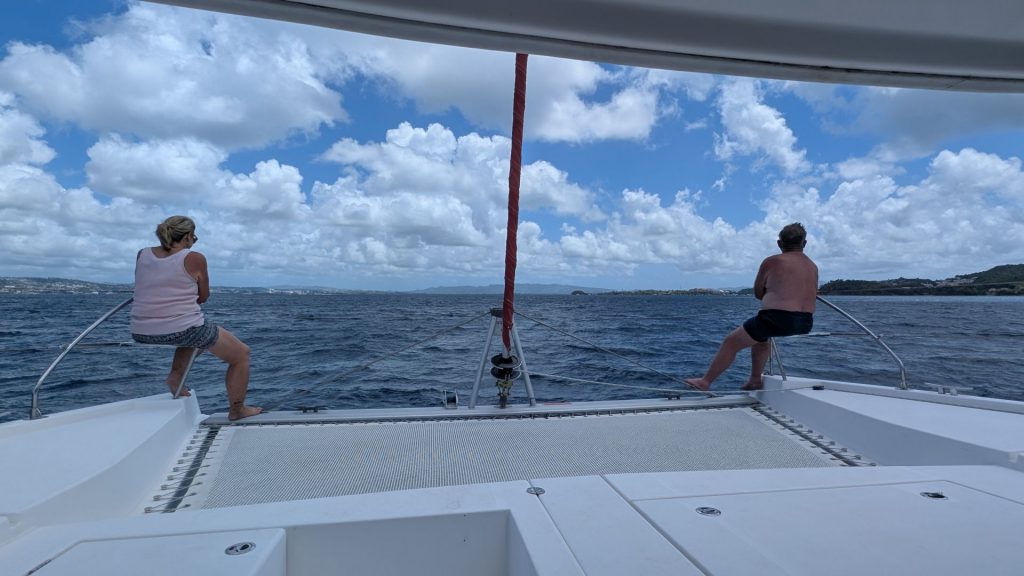
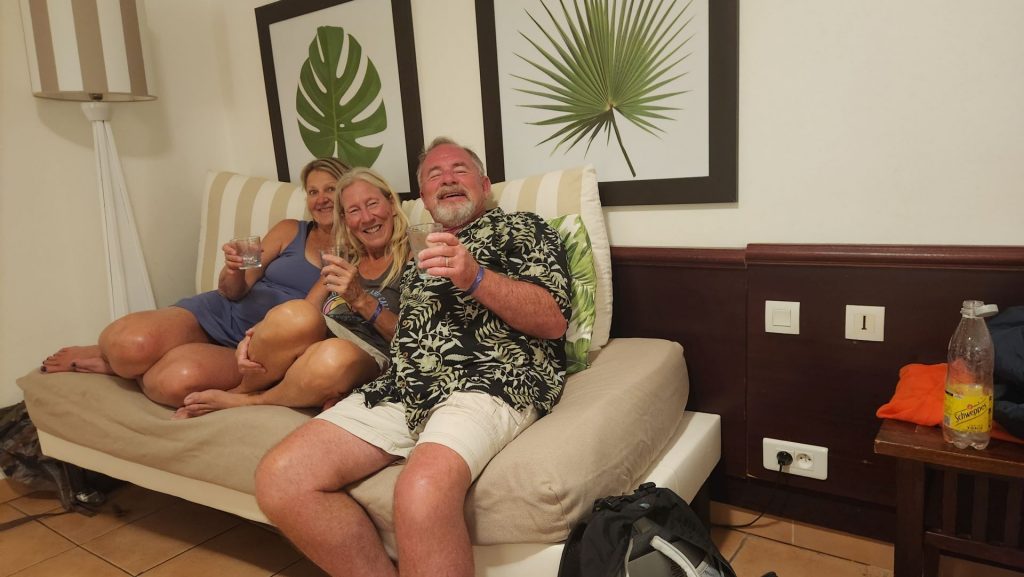
View from our room:
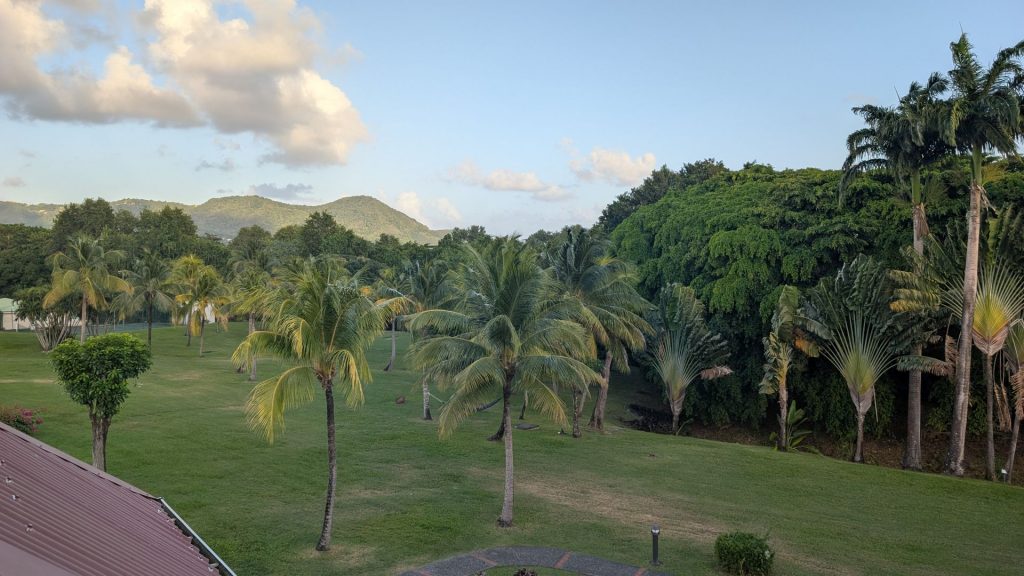
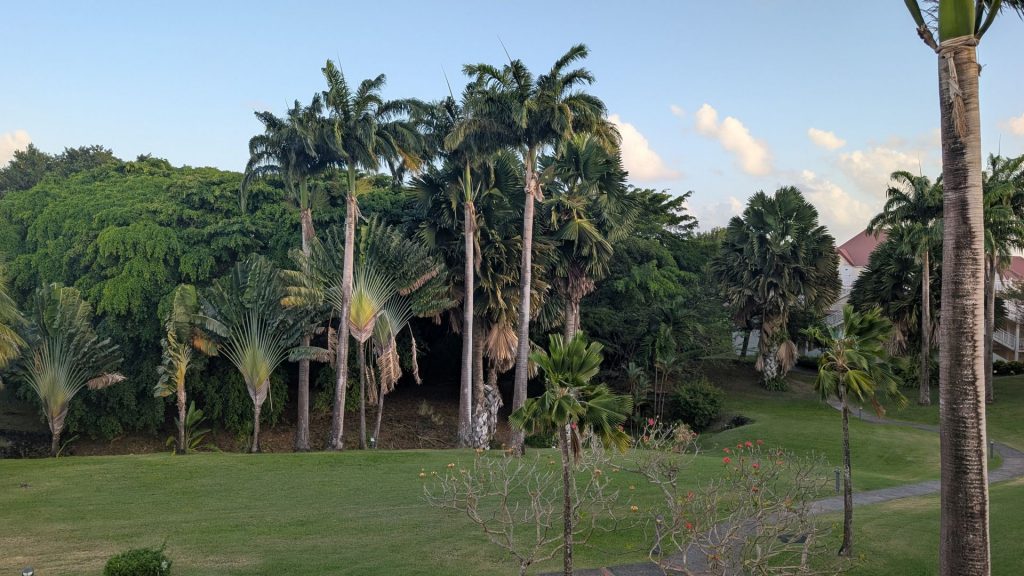
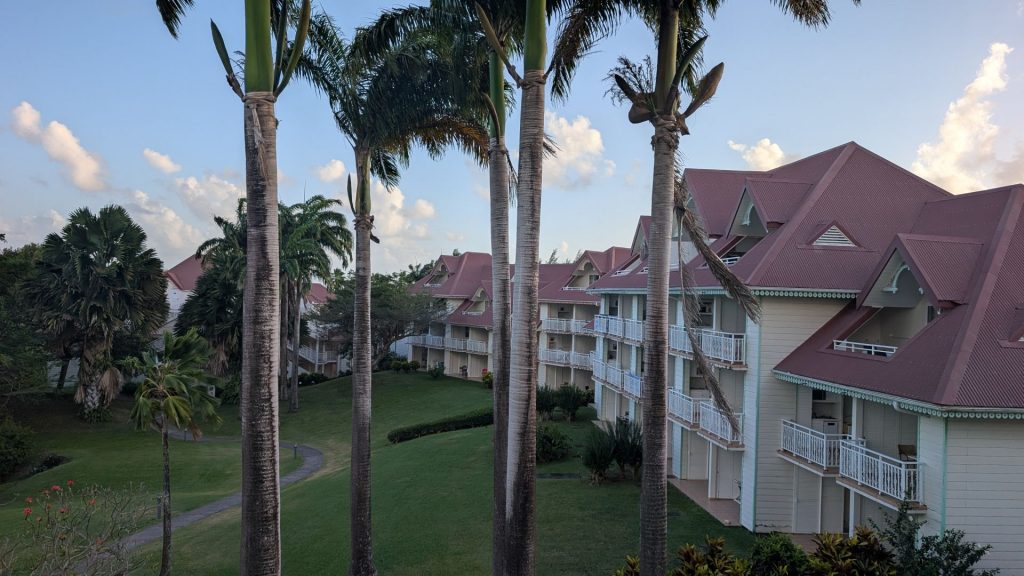
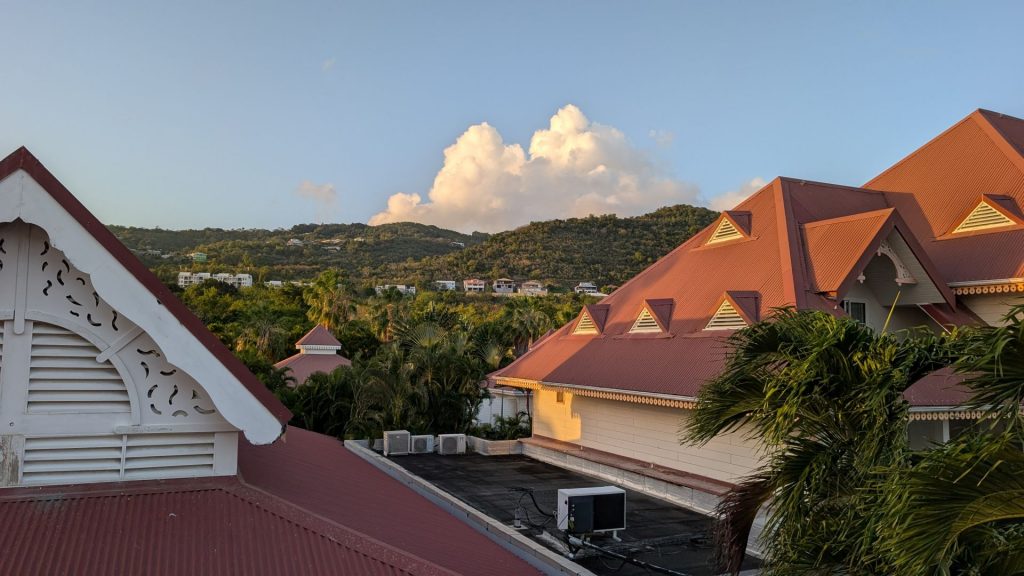
Out and about. . .
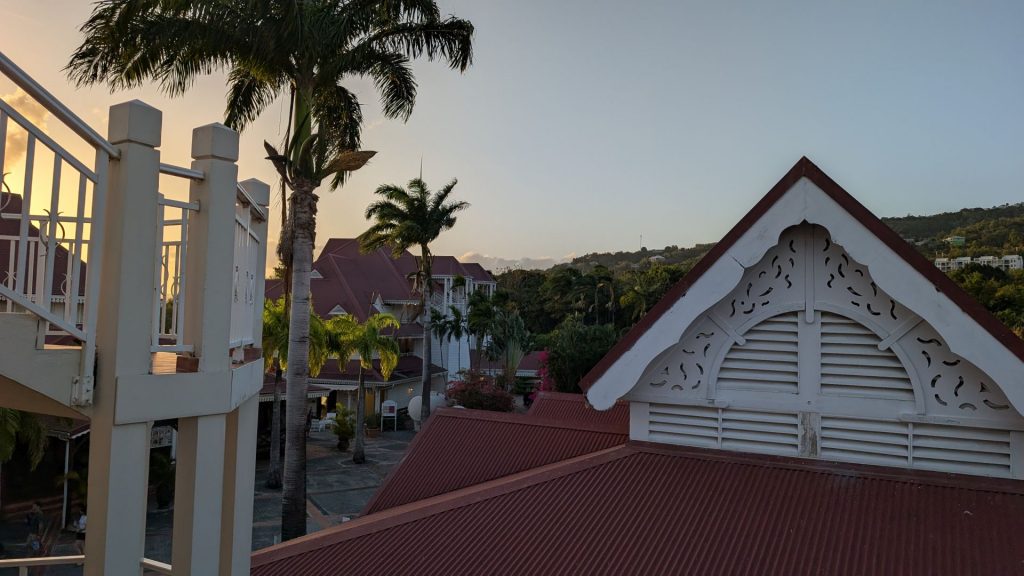
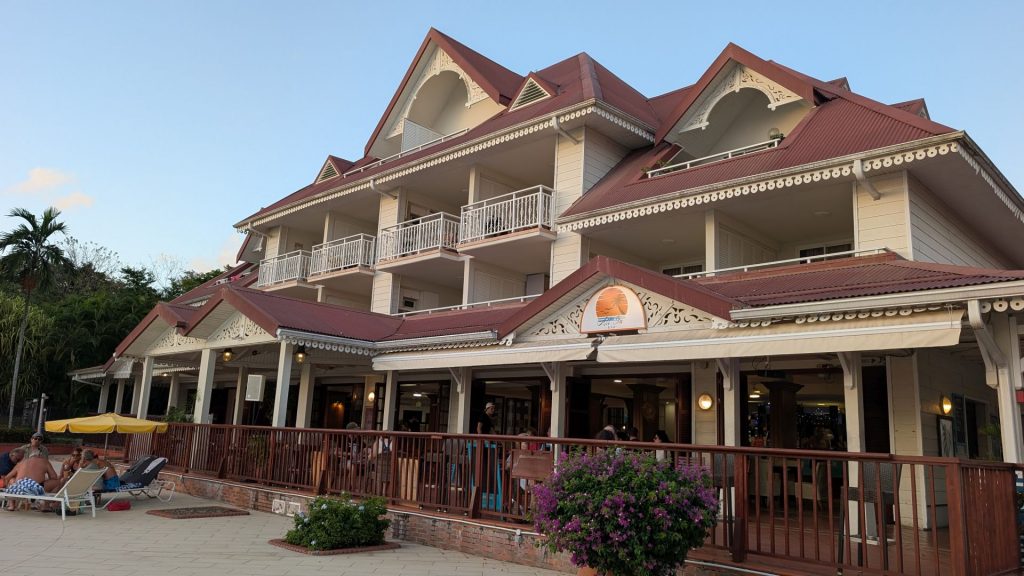
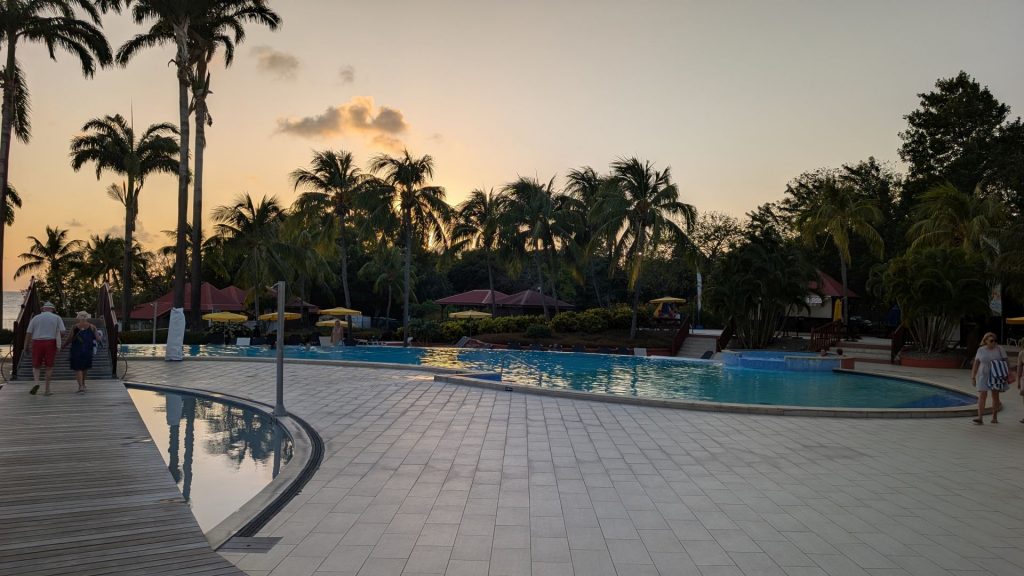
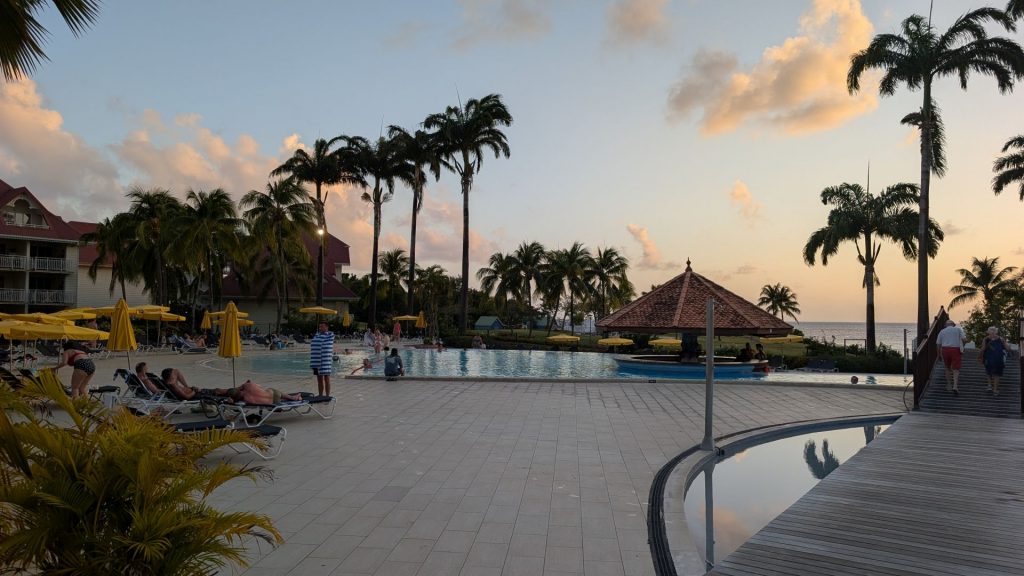

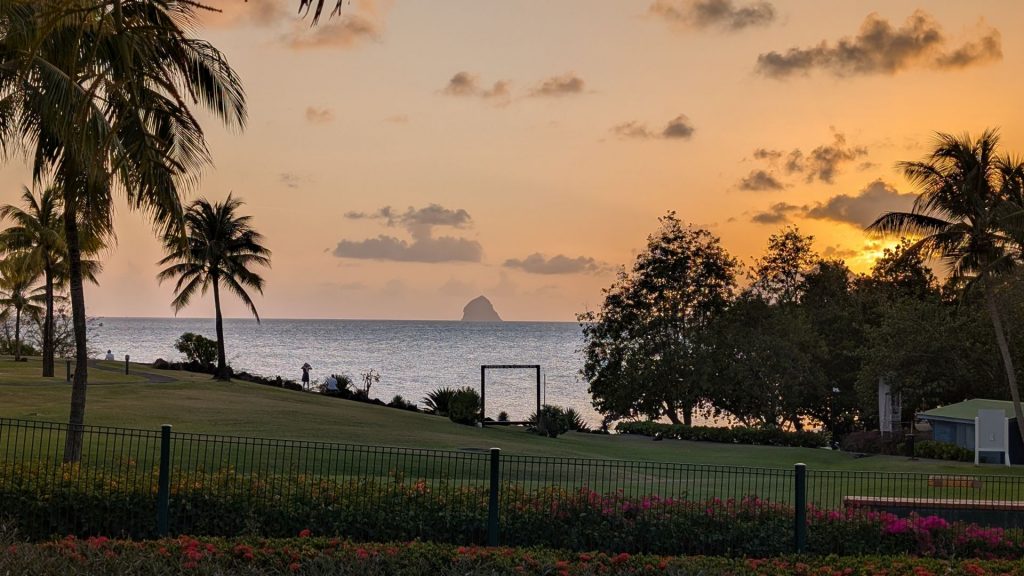
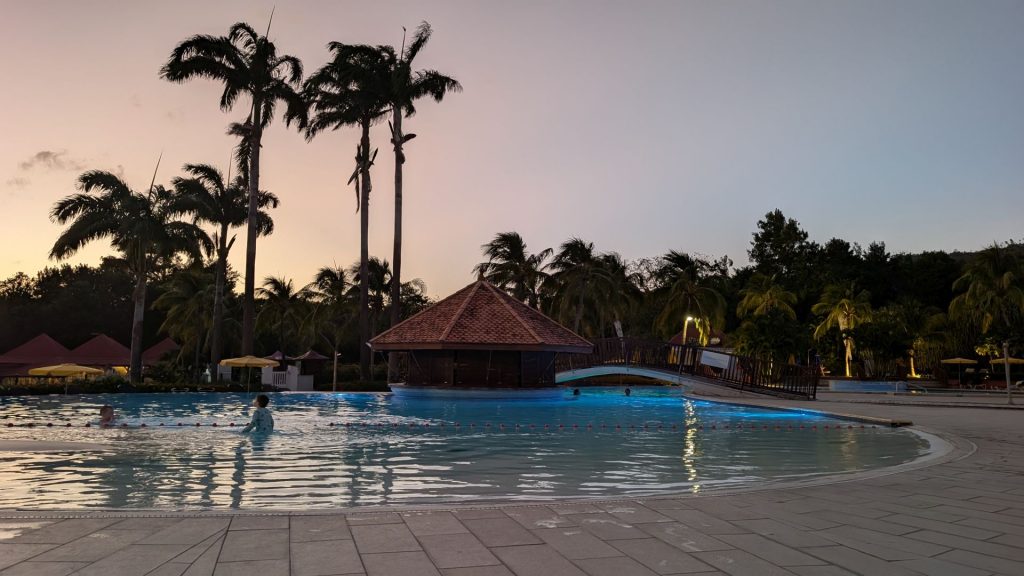
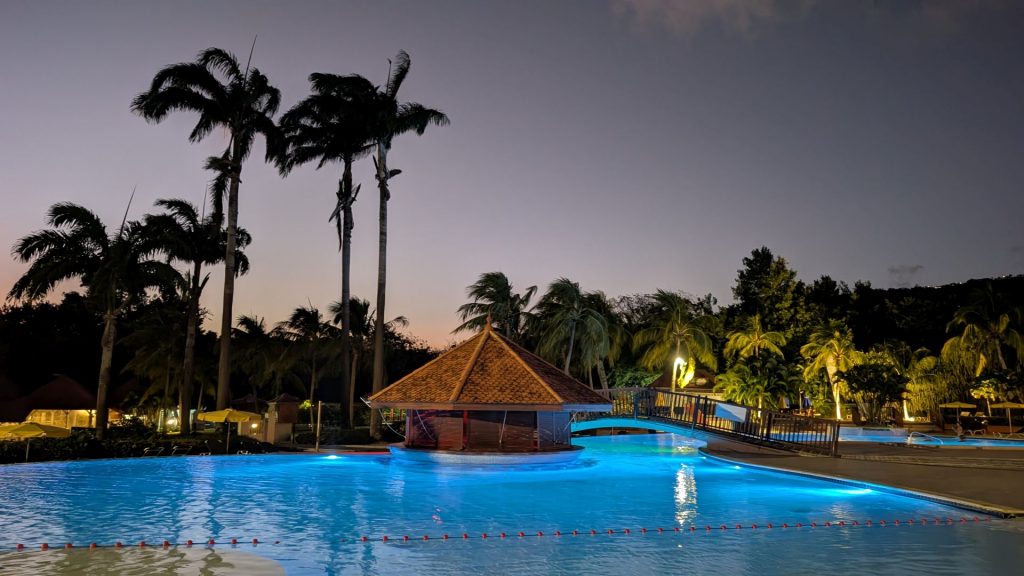
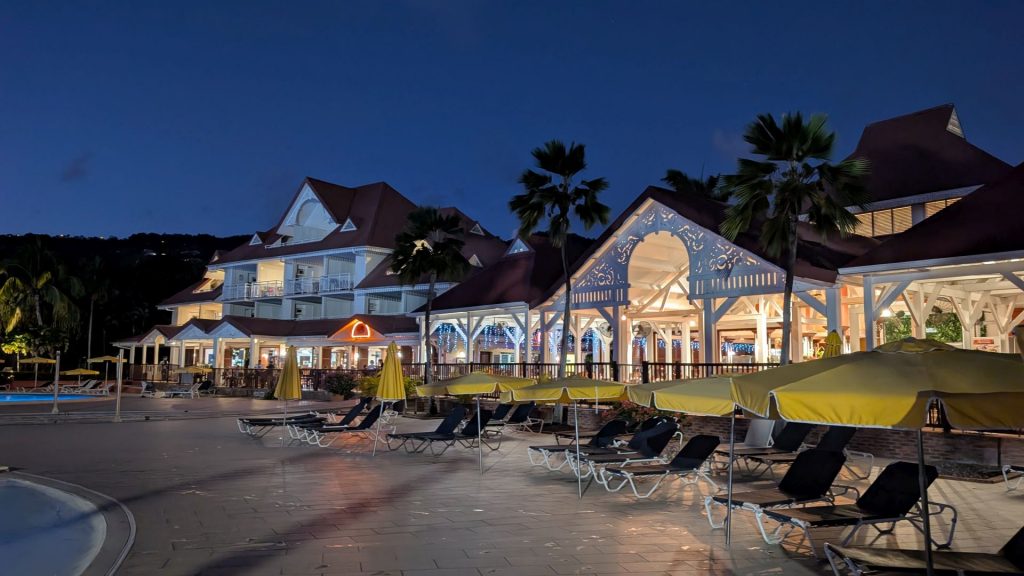
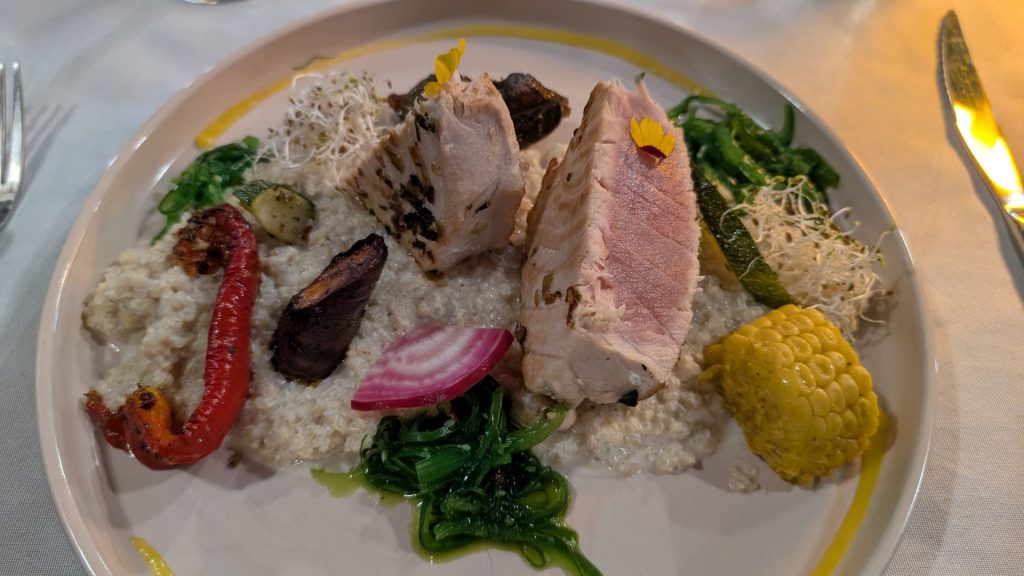
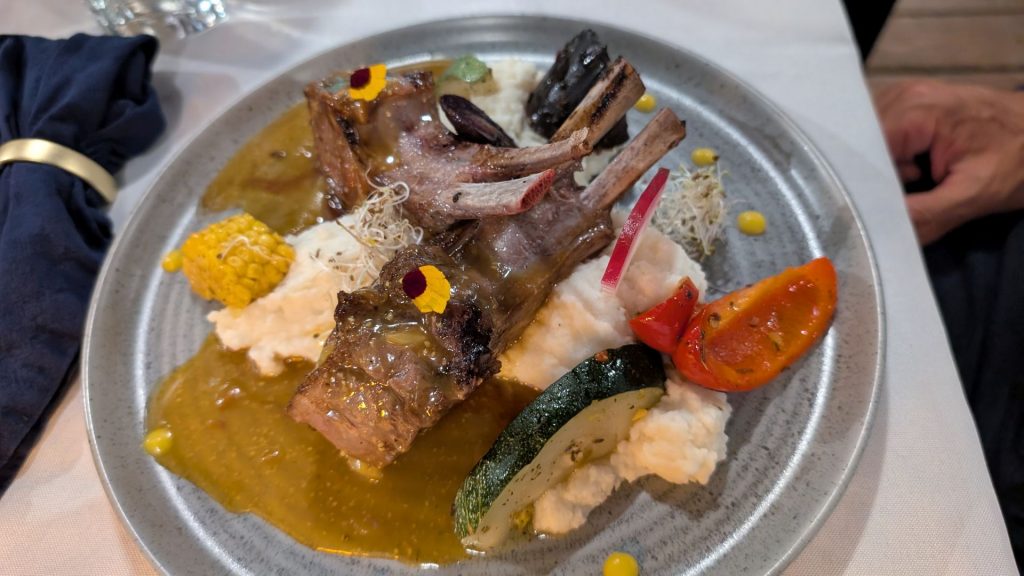
March 27th was our last day with Caroline and Jim. A sad day to be sure, but we all have such wonderful memories of our time together! We walked on the hotel property to the beach before we checked out. They have a big outdoor seating area, presumably for performances.
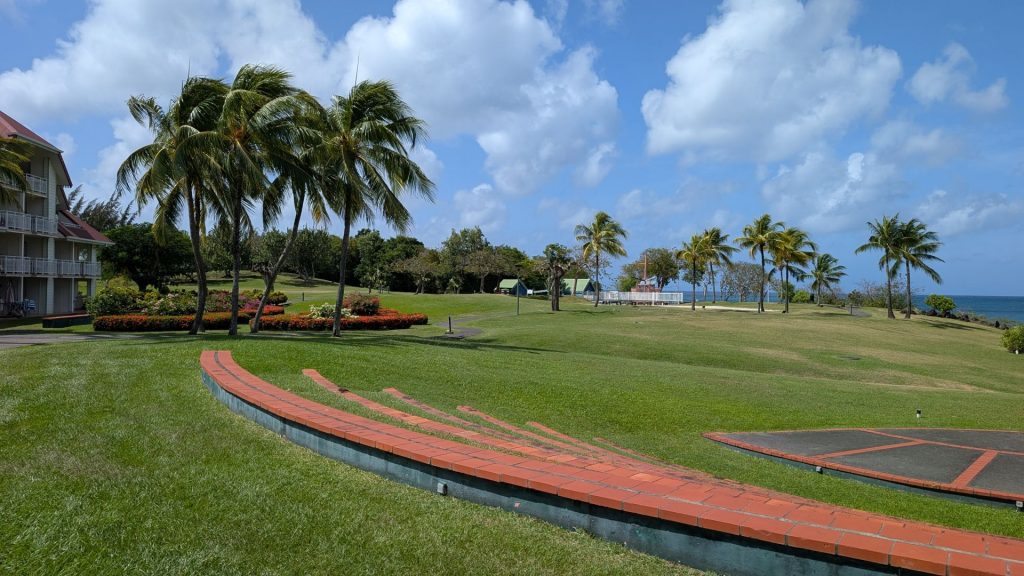
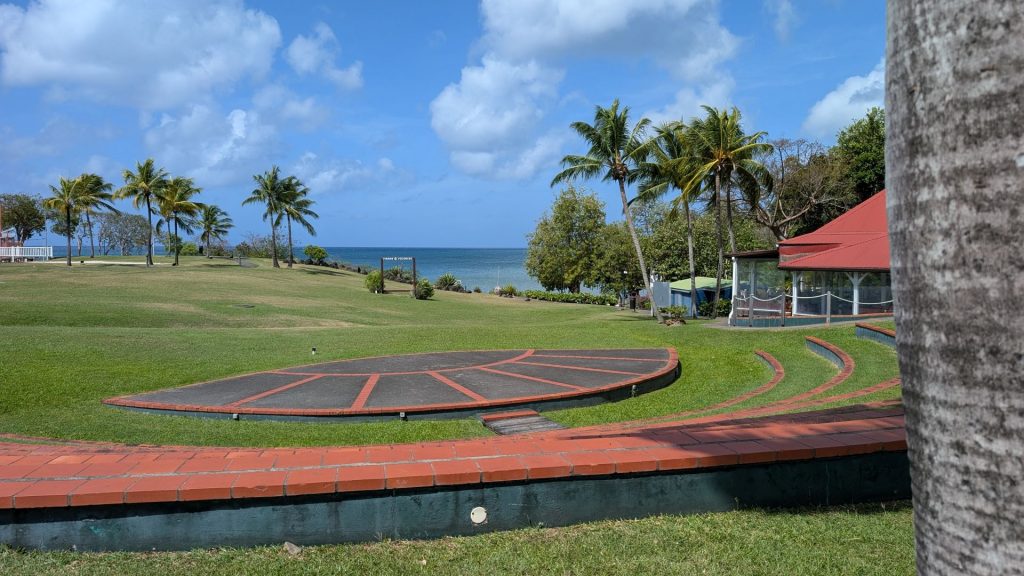
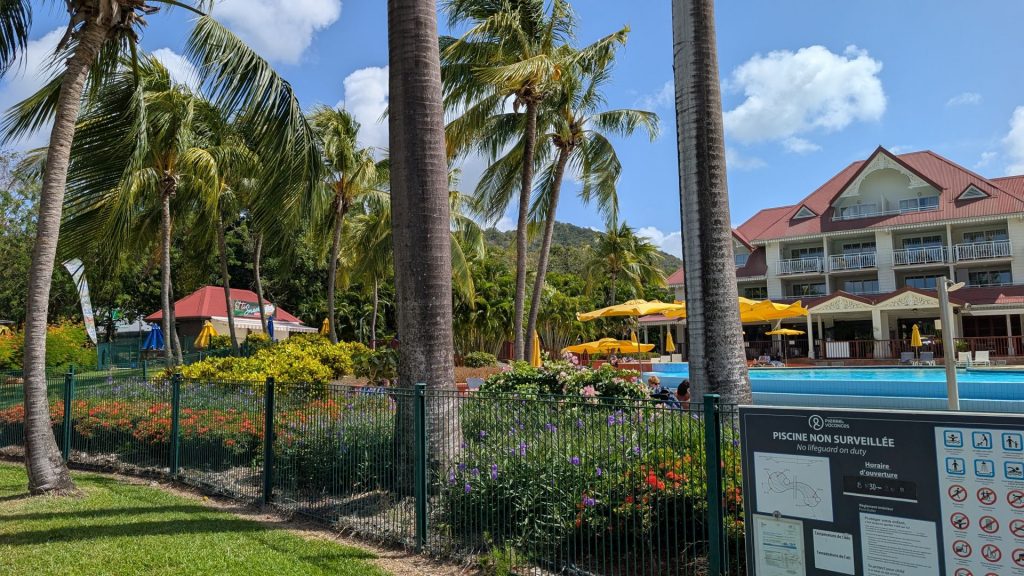
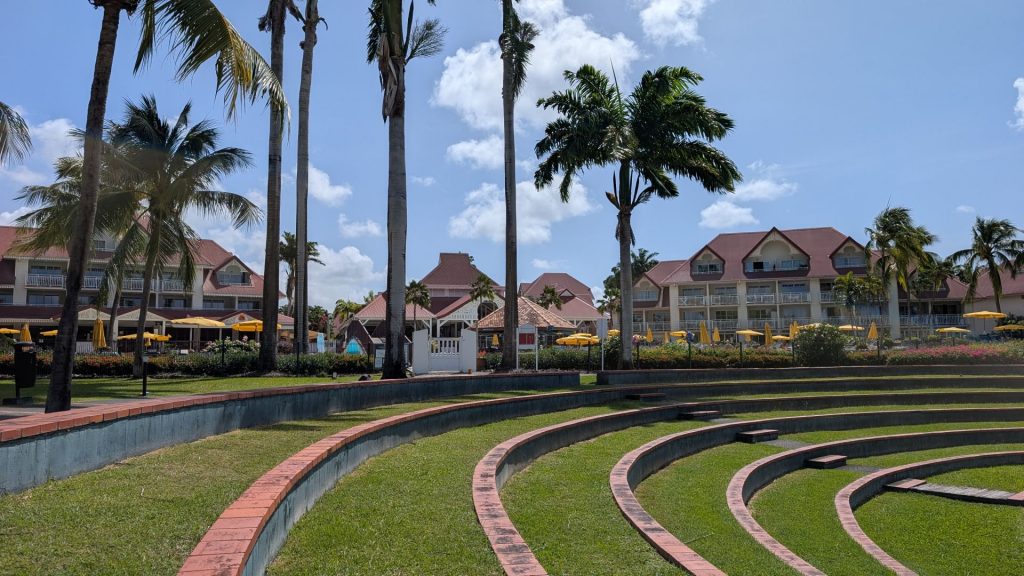
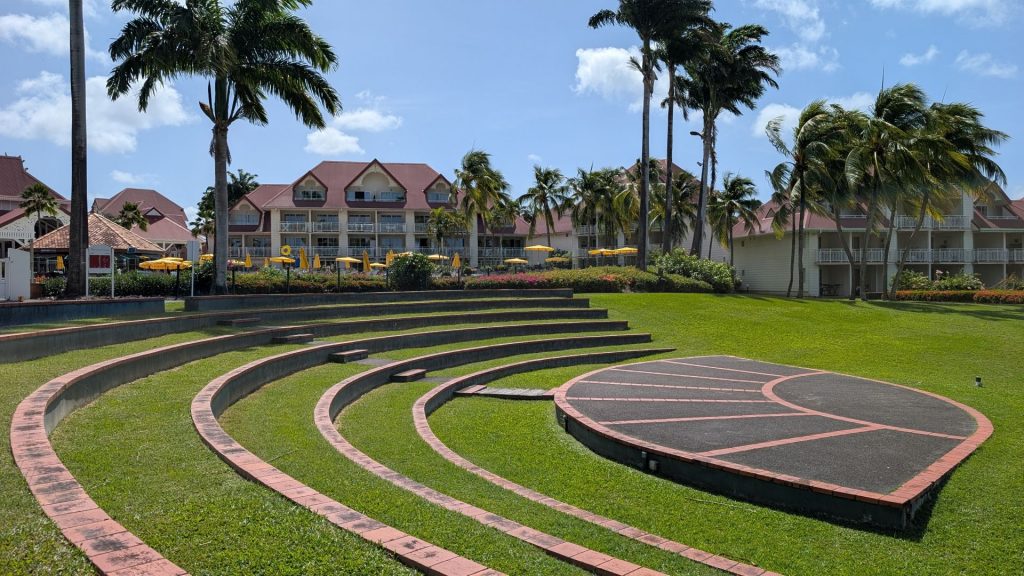
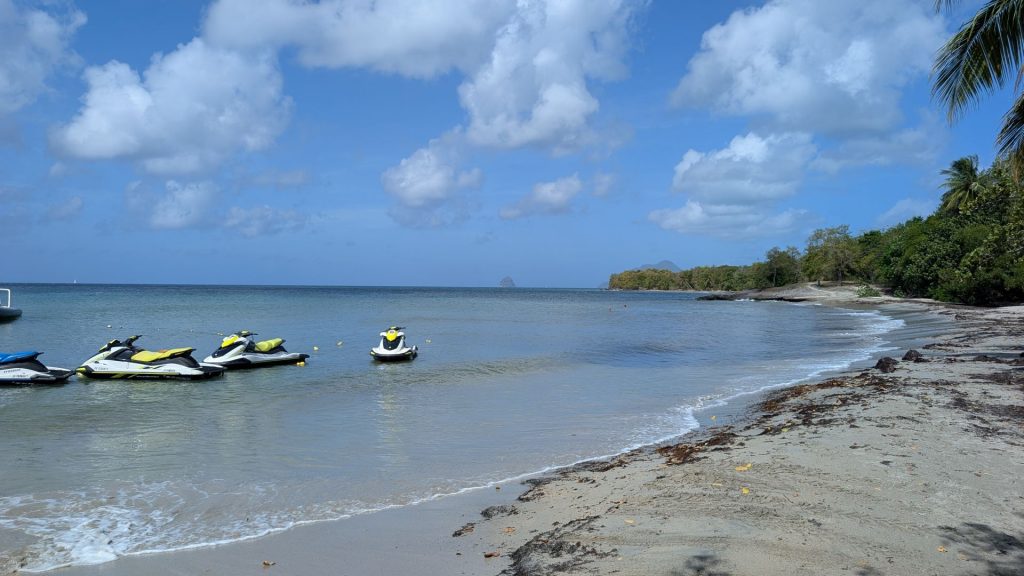
We were all wishing that we had another day to partake of some of the water crafts and activities, spend more time in the pool, go for a hike, and have another yummy meal at the restaurant.
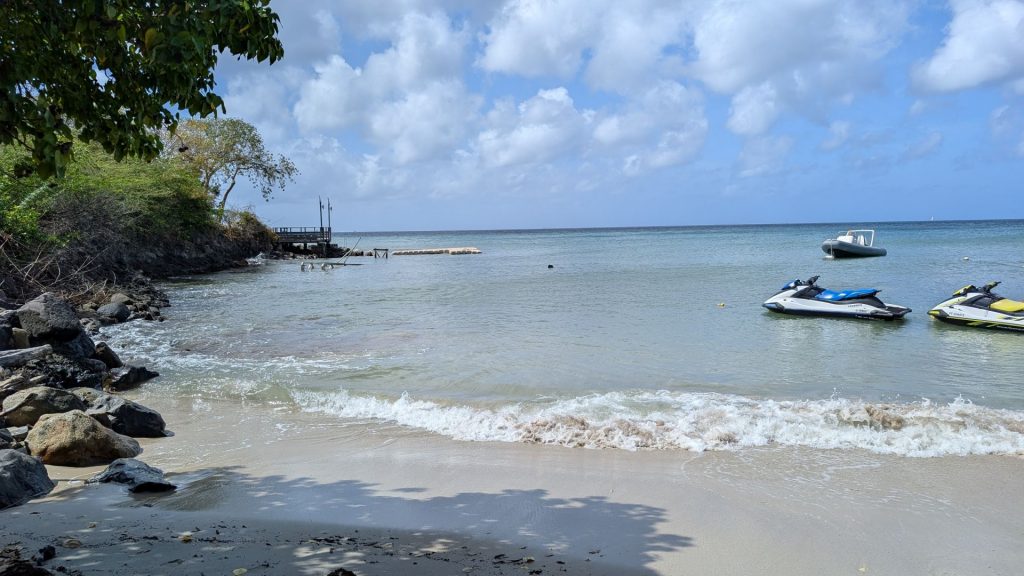
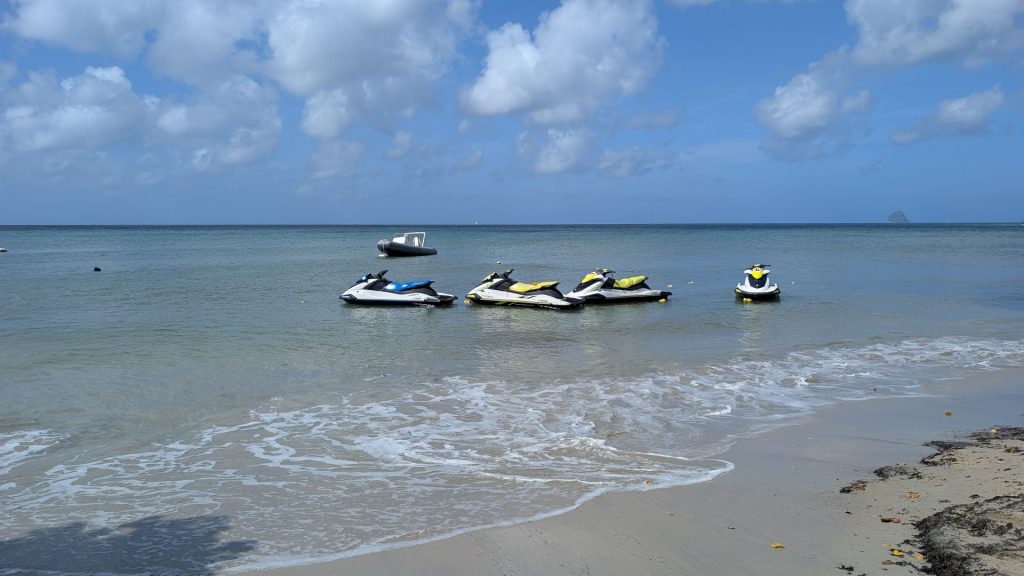
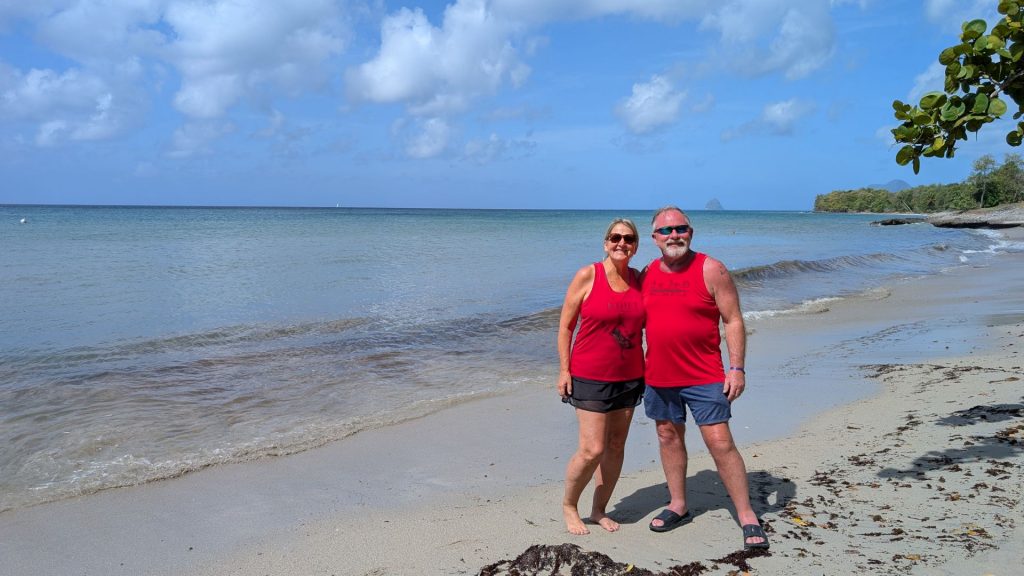
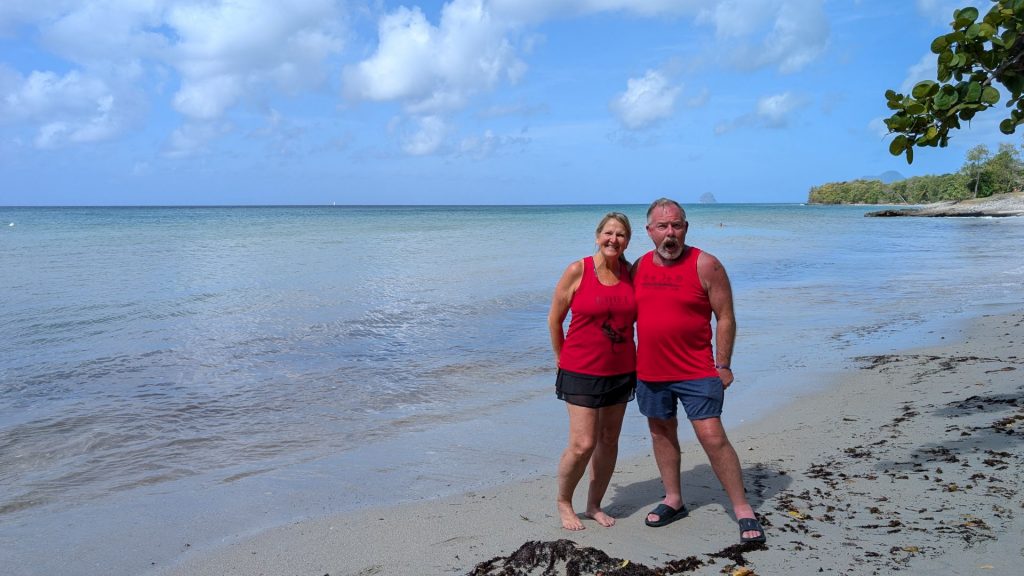
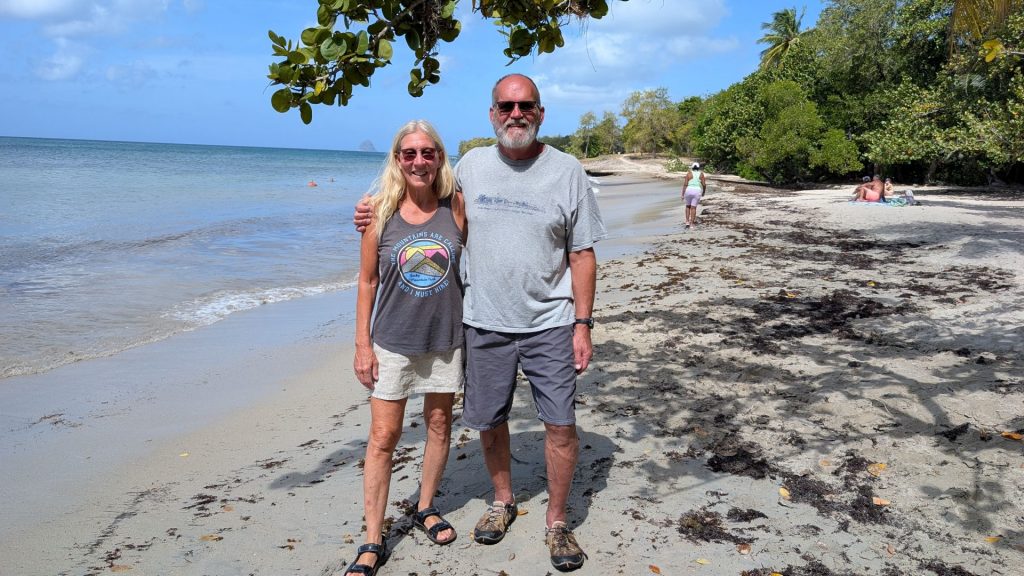
That’s a wrap!
